"Alfred - more properly Ælfred - is the only English king ever to have been designated 'the Great.' He
earned this epithet by his stalwart resistance to the Danes, by his wise government and law-making, and
because of his revival of learning in England. Even though he never ruled the whole of the country, he
was the first king of Wessex to call himself 'King of England,' and all the English not under Danish rule
came to recognize him as their sovereign lord.
Alfred probably never expected to become king, as he had three elder brothers (a fourth had died before
his father). Ælfred was perhaps the most promising of the four boys, if the following story is to be
believed (as recounted by his flattering biographer Asser, writing towards the end of his reign):
In fact it was not until much later in his life that Alfred actually learned to read and write.
In 853, at the age of only four, Alfred was sent to Rome, and again in 855, possibly on pilgrimage with
his father Æthelwulf. During these journeys he spent some time at the court of Charles the Bald, king of
the West Franks, and it seems from this that Alfred acquired some knowledge and admiration for Charles's
grandfather, Charlemagne.
Since the last years of the previous century England had been subject to raids by the Vikings - a
catch-all phrase for the Scandinavian raiders or Norsemen, most of whom as far as England was concerned,
came from Denmark. Eventually the Viking raiders, arriving in ever larger numbers, turned to conquest and
settlement. In the mid-860s a Danish 'Great Army' under Ivar the Bonelesslanded in eastern England and
occupied Northumbria (then comprising all of eastern England north of the Humber). Then the Danes began
to cast their eyes on Mercia (an Anglo-Saxon kingdom roughly occupying the area of the Midlands) and on
Wessex itself, which extended across much of southern England.
In 867, the year of Alfred's marriage to Ealhswith, a princess of Mercian descent, he and his brother led
an expedition to resist Danish incursions into Mercia. The Danes refused to give battle, and were
eventually bought off by the Mercians, but the sortic took the pressure off Æthelred's own kingdom - for a
while. The Danes went on to penetrate East Anglia, killing its king. Then at the end of 870 they turned
their attentions towards south-west - to Wessex.
In mid-April 871, before the last of these battles, Alfred's brother Æthelred I had died, and Alfred had
become king. Although Æthelred I had left two young sons, the succession in those days often passed to
the most competent relative - and by this time Alfred was an experienced military leader. After the
defeat at Wilton in May, a peace was agreed, and for five years the Danes turned their attentions to other
parts of England.
As he grew older and wiser, Alfred adopted different, more cautious tactics for dealing with the invaders.
He would besiege their fortified positions and starve them out, or shadow their armies with guerrilla
forces and prevent them from living off the land. He reorganized the fyrd the militia of each
shire, dividing it into two groups working in shifts, so that cultivation of land would not be entirely
neglected while the men were at war. He also fortified and permanently garrisoned key positions (old
Roman towns, new settlements, old and new forts), to protect the population and their goods, saving them
from Viking plunder.
The result of these changes was that Alfred defeated the Danes at Cynwit and Ethandum in 878, forcing
their leader Guthrum to convert to Christianity (Alfred was godfather at his christening). In another
campaign in the mid-880s Alfred took London (866), and scored further victories at Farnham, Benfleet and
Buttington in 893. In this latter year Alfred's diplomacy with the Welsh paid off, as they sent troops to
aid him in his fight against the Norsemen. It was after the capture of London that all the English not
under Danish rule (and perhaps also the Welsh) submitted to Alfred. By 896 the Danish threat to Alfred's
kingdom had dwindled away - although they still held fast to their vast territories in eastern England,
and it is possible that Alfred may have bought peace by paying tribute money - the so-called Danegeld.
- the shire militias - has already
been touched on, as has his fortification of key locations. These strongholds, known as burhs (the
Old English word is the origin of our word 'borough'), were positioned no more than 20 miles from each
other, and their defence had to be paid for by the inhabitants. Some had street plans, from which it seems
that Alfred intended them to be permanent market towns and commercial centres, rather than just
strongholds in time of war.
Alfred also promulgated his own code of laws, incorporating statutes from both Mercia and Kent, presumably
to encourage acceptance of his claim to dominion over all the English. He reinforced his kingly authority
by introducing a new law on treason and an oath of allegiance. His own introduction to the law code links
his laws with the Ten Commandments, suggesting he wanted people to think of him as a lawgiver with divinely
sanctioned authority.
Culture and learning
The long years of raiding by the Danes had had a disastrous effect on learning. Even many of the English
clergy were ignorant of Latin, the universal language of the Church, and Alfred recalled that when he
ascended to the throne he knew of no man south of the Thames who could translate a letter from Latin.
Alfred longed for learning, and later in his reign he established a court school, as Charlemagne had done
at Aix-la-Chapelle, and imported scholars from Europe and Wales; among the latter was Asser, who was to
write his biography (albeit a hagiographical one). Alfred also encouraged art and architecture, and,
although the enthusiasm for monasticism was not to arrive in England for two centuries or more, he was
responsible for foundations at Athelney and Shaftesbury.
Alfred set himself the task of translating (and sometimes annotation with his own comments) a series of
texts from Latin into Old English, including Pope Gregory's Pastoral Care, St. Augustine of Hippo's
Soliloquies and Boethius' Consolation of Philosophy. Various other works and translations
originally attributed to him (such as Bede's History) are now thought to be by others, but were
carried out at his bidding. One of Alfred's most lasting legacies was his patronage of the Anglo-Saxon
Chronicle, the compilation of which began during his reign, and continued until 1155, providing one of
the most important sources for the history of England in the early Middle Ages. Alfred's own purpose may
have been somewhat different. The early parts of the Chronicle, written in the mid-890s, emphasize
Alfred and his predecessors as the champions of Christianity against Norse paganism, and celebrate
Alfred as the ruler of a peaceful and prosperous Wessex, destined to rule a peaceful and prosperous England.
"I desire to live worthily as long as I lived, and to leave after my life, to the men who should
come after, my memory in good works." King Alfred, annotation to his translation of The
Consolation of Philosophy by Boethius.
"We must bring it to pass, if we have the peace, that all the youth now in England, born of free men
who have the means that they can apply to it, may be devoted to learning until such time as they can read
well what is written in England." King Alfred, letter to his bishops, circa 890.
Alfred's Mystery Illness
Asser, Alfred's biographer, left this tantalizing glimpse into the human being behind the legend:
"From his twentieth to his forty-fifth year (in which he now is) he has been troubled incessantly by
the severe visitation of an unknown disease; never an hour passes but he suffers from it, or is nearly
desperate from fear of it."
Apparently the worst visitation occurred on the day of his wedding, so one may perhaps infer a psychosomatic
element in the affliction, as well as a degree of hypochondria -although all the other evidence of
Alfred's life points to a man of great sanity and sagacity.
Timeline
|
849: Birth of Alfred
853: Visits Rome, where according to legend, he is anointed by the Pope
855: Second visit to Rome
858: Death of Alfred's father Æthelwulf
860: Winchester sacked by the Danes
867: Marries Eathswith
868: Accompanies his brother Æthelred in a campaign against the Danes in Mercia
870: Danish victory at Englefield
871: (4 January) Defeated by the Danes at Reading
871: (8 January) he and his brother defeat the Danes at Ashdown
871: (March) Defeated at Meretun
871: (April) Succeeds to the throne of Wessex after the death of his brother
871: (May) Defeated at Wilton
878: (May) Victories over the Danes at Cynwit and Ethandun
884: Defeates the Danes at Rochester
886: Captures London
887: Learns to read
892: Begins his series of translations of Latin texts
893: Victories over the Danes at Farnham, Benfleet, and Buttington
899: Death of Alfred |

Athelstan, King of England, King of Mercia, and King of Wessex
(924-939)
Born: 895 A.D. Died 22 October 939, at Gloucester. Buried: Malmesburn Abbey.
Succeeded: 2 August 924. Style: Rex totius Britanniae ('King of all Britain'). Father:
Edward The Elder, King of England (899-924). Mother: Ecgwynn. Married: died a
bachelor.
Athelstan - the eldest son of the eldest son of Alfred The Great, King of England
and King of Wessex (871-899) - was the first king to rule over all of England, apart from Cumbria. A
great soldier and 'lord of warriors,' he annihilated a joint Norse-Scottish-Irish invasion force at
Brunanburth, so securing his kingdom.
Athelstan was also an effective ruler, arranging dynastic matches for his sisters, and at home securing
the peace, drawing up codes of law and establishing national assemblies of nobles and churchmen from all
over the country. He thus helped to shape the future political life of 10th-century England.
Towards unification
Athelstan was brought up in Mercia by his aunt Æthelfleda, the Lady of the Mercians, and this probably
helped to secure the loyalty of the Mercians to Athelstan's dynasty, the house of Wessex. After
Æthelfledadied in 918 his father Edward The Elder, King of England (899-924)
ruled Mercia directly, and on Edward's death in 924, Athelstan was proclaimed king of Mercia, being
crowned king of Wessex the following year.
In 926 he arranged the wedding of one of his sisters to Sihtric, ruler of the Viking kingdom of York.
When Sihtric died a year later, Athelstan seized not only York, but the whole of Northumbria - a vast
territory extending from the Humber to the Tweed. Constantine II, king of Scots, submitted to Athelstan
at Bamburgh, the ancient stronghold of the Northumbrian kings. At Hereford, the Welsh princes had already
made their own submissions.
The Battle of Brunanburh
Athelstan's expansionist moves made many enemies. His military incursion in 934 as far north as Edinburgh
alienated Scots, while Olaf Futhfrithsson, son of the ousted Irish-Norse ruler of York, planned his
revenge from his base in Dublin. Eventually Olaf assembled a coalition of Irish Vikings, Scots, and
Strathclyde Britons, and in 937 launched an invasion of England. They met the English army at a place
called Brunanburh, somewhere in Mercia.
The fighting lasted all day, and losses on both sides were heavy, but the English came out victorious.
The coalition lost many of its great men, five kings and seven earls among them, including Owain of
Strathclyde and the son of Constantine II of Scotland. It was a mighty victory, and was celebrated as
such in a splendid narrative poem by an unknown hand, incorporated in the Anglo-Saxon Chronicle.
Athelstan and Europe
As the threat from the pagan Northmen receded, Athelstan positioned himself as one of the princes of
Christendom, establishing bonds with his fellow Christian princes of Europe. One of his sisters married
Otto the Great, who became Holy Roman Emperor; another married High the Great, duke of Burgundy. European
royalty also came to Athelstan's court: Louis IV of France took refuge there, while Haakon of Norway was
raised in England as Athelstan's foster-son.
Athelstan, something of a connoisseur, exhanged precious gifts with rulers all over Europe. Among the
presents from Duke High - sent with the emissaries seeking the hand of the king's sister - were two of
Athelstan's most treasured possessions: the sword of the Emperor Constantine, and the lance of Charlemagne,
weapons belonging to two of the great champions of Christendom. There is little doubt that Athelstan saw
himself as one of these champions, for was he not, in his own words, 'King of the English, elevated by the
right hand of the Almighty, which is Christ, to the Throne of the Whole Kingdom of Britain'? By the time
of his death, with substantial parts of Britain under his suzerainty and purged of the pagans, this claim
was only a partial exaggeration.
"He offered indeed most ample gifts, which might instantly satisfy the cupidity of the most
avaricious: perfumes, jewelry . . . a vase of onyx, carved with such subtle engraver's art that the
cornfields seemed really to wave, the vines really to bud, the forms of the men really to move, and so
clear and polished that it reflected like a mirror the faces of the onlookers. . ." William of
Malmesbury, writing in the 12th century, describes some gifts to Athelstan by High, duke of Franks.
"Athelstan King, Lord among Earls, Bracelet-bestower and Baron of Barons, He with his Brother,
Edmund Atheling, Gaining a lifelong Glory in battle, Slew with the sword-edge There by Brunanburh, Brake
the shield-wall, Hew'd the linden-wood, Hack'd the battle-shield, Sons of Edward with hammer'd
brands." Anon., 'The Battles of Brunanburh,' from the Anglo-Saxon Chronicle, translated by
Alfred, Lord Tennyson (1876).Timeline
|
895: Birth of Athelstan
924: (2 August) Proclaimed king of Mercia
925: Crowned king of Wessex
927: Takes control of Northumbria
934: Invades Scotland
937: Defeats a coalition of Vikings, Scots, and Strathclude Britons at Brunanburh
939: (22 October) Death of Athelstan |


Anderson County, Kentucky
"ANDERSON: 1827 (82nd county) Anderson County is bordered by Nelson, Spencer, Shelby, Woodford, Franklin, Mercer, and Washington counties. Taken from
parts of Franklin, Mercer, and Washington, it is located at the western edge of the famous
Kentucky Bluegrass Region. Anderson consumes an area of 206 square miles, which is drained
by the Kentucky and Salt Rivers.
The county was named for Richard Clough Anderson Jr., a nephew of General George
Rogers Clark (Founder of Louisville, KY). He served in Congress and was appointed Minister
to Columbia by President Monroe. Anderson was the first diplomat from the United States to
negotiate a treaty with a South American country.
Lawrenceburg is the county seat. Originally settled in 1776, the town was not actually
incorporated until 1820. It is located 13 miles south of Frankfort, and 23 miles west of Lexington,
Kentucky.
The economy is historically based on farming, yet more than 50 distilleries were in operation in 1818.
Kentucky River limestone is quarried in large parcels, and other chief industries include the
manufacturing of carpeting, wall tile, pipe coating, metal fasteners, dairy products, and meat
processing." Source: Written by Robert A. Powell Kentucky Counties, page 7-8;
1989.
"ANDERSON COUNTY in 1827, Anderson County was formed from parts of Franklin, Mercer, and Washington
Counties. The county is located in what is generally regarded as the Bluegrass (north central) area of
the state. Lawrenceburg is the county seat.
The county is named for Honorable Richard Clough Anderson Jr., who was born in
Louisville in 1788. A graduate of William and Mary, Anderson served in the Kentucky House of
Representatives and then two terms in the United States Legislature before being named by President Monroe
to serve as minister plenipotentiary to Columbia in 1823. Received in Bogota with much enthusiasm,
Anderson negotiated the United State's first treaty ever with a South American republic. He died in 1826
while on his way to serve as a delegate to the Panama Congress. Source: Kentucky County Maps,
p.4.

Col. Richard Clough Anderson Sr.
The following items are from the "Soldier's Retreat" on Hurstbourne Lane, Louisville, KY. in the family cemetery.
"Soldiers Retreat sign #1968. Home of Col. Richard C. Anderson, 1750-1826. American Revolutionary War Patriot. Aide
to Lafayette, wounded at Siege of Trenton and Savannah, captured at Charleston, fought at Yorktown, where surrender of
Lord Cornwillis to Washington in 1781 completed the Revolution. Married Elizabeth Clark, sister of General George Rogers Clark (Founder of Louisville, KY). Second wife Sarah Marshall, cousin of Chief
Justice John Marshal. [over] Soldier's Retreat: Completed by Anderson in 1794, with massive walls of limestone over
two feet thick, it was a refuge from possible Indian attacks. Damaged bye earthquake 1811 and by lightning 1840, the
homestead was later dismantled. Distinguished by 1983 listing on National Register of Historic Places, Soldier's
Retreat reconstructed by L. LeRoy Aighbaugh, Jr."
Military Grave marker: "Richard C. Anderson Virginia Lt. Col, Continental Line Revolutionary War 12 Jan 1750-16 Oct
1826"
Masonic order grave marker: Masonic square & compass symbol "First Master of Lexington Lodge 25 F.&A.M. (Virginia) in
1788, now Lexington Lodge no. 1 F.& A.M. Erected by Lexington Lodge no. 1 F. & A.M. 1988 Lexington, KY."
"Elizabeth Clark Anderson, daughter of John & Ann Clark ?????? wed to Col. Richard C. Anderson. Born 1768 Married 1787
Died 1795."

History of Grand Lodge of
Kentucky F&AM
Below is a brief listing from their history:
"At a Grand Lodge, holden by adjournment at the Mason's Hall, in the city of Richmond, on the 17th day of November,
1788 ... a petition of Green Clay, in behalf of sundry Brethren residing in the district of Kentucky was read, praying
that leave be granted to them to hold a regular lodge at the town of Lexington, in the district aforesaid.
Ordered, that a charter be granted to Richard Clough Anderson, John Fowler, Green Clay, and others, to hold a regular
Lodge of Free Masons at the town of Lexington, in the district of Kentucky, by the name title, and designation of the
Lexington Lodge, No. 25.... (Signed) Alex Montgomery, G.M., p.t. Teste William Lambert, G.Sec'y, pro tem.
The three men named in the record were of some stature in both the profane and Masonic worlds. Richard Clough Anderson,
the first Master of Lexington Lodge No. 25, was a native of Hanover County, Virginia. He was a captain in the Virginia
Continentals during the Revolution and crossed the Delaware in the first boat at the Battle of Trenton in 1776. He also
saw service at Brandywine, Germantown, and Savannah before being taken prisoner at Charleston in 1780. After the war he
moved to Kentucky and became a principal surveyor of bounty lands to be entered for veterans of the Revolution.
Anderson eventually established his residence on a farm called "Soldier's Retreat" near Louisville. Anderson was a
member of the first electoral college and a member of the Kentucky legislature. He married Elizabeth Clark, the sister
of George Rogers Clark. His children included Richard Clough Anderson, Jr. for whom Anderson County was named, and
Civil War (Union) Brigadier General Robert Anderson. Richard Clough Anderson died in 1826.
Accordingly, the Grand Lodge of Virginia saw fit to grant a charter to the little band of Masons "at the town of
Lexington, district of Kentucke." Thus the first lodge in the western country was established in Lexington the "Athens
of the West" four years before Kentucky was admitted into the Union.
It is an interesting fact and one that shows the importance Masonry played in the early settlement of Lexington, that
out of the party of eight pioneer hunters who located the site of the city, three were Masons; Robert Patterson, Levi
Todd and John Maxwell."

Honorable Richard Clough Anderson Jr.
U.S. Congressman;
U.S. Minister to Columbia.

Anderson County, Kentucky
was named for Richard C. Anderson Jr., a nephew of
General George Rogers Clark (Founder of Louisville, KY). He served in U.S. Congress
and was appointed Minister to Columbia by President Monroe. Anderson was the first diplomat from the
United States to negotiate a treaty with a South American country.
"Richard Clough Anderson, Jr., legislator and diplomat after whom Anderson County was named, was born on 4
August 1788, at Soldier's Retreat in Jefferson County, Kentucky, to Richard Clough Anderson and Elizabeth
(Clark) Anderson. He was a graduate of William and Mary College. After studying law in Virginia, Anderson
practices law in Louisville and served in the Kentucky legislature in 1815. He was then elected to two
terms in the U.S. House of Representatives (1817-1821), where he chaired the Committee on Public Lands. He
was returned to the Kentucky legislature in 1821 and chosen Speaker of the House in 1822. Anderson was
appointed U.S. minister plenipotentiary to Colombia [by President Monroe] on 27 January 1823, and in 1826
he was confirmed as a delegate to the Panama Congress of Nations. While on his way to Cartagena, he died
of yellow fever on 24 July 1826, in Turbaco, Panama.
Anderson married Elizabeth Gwathmey in 1810; they had three daughters and one son. Anderson was buried in
the family cemetery on Hurstbourne Lane in Jefferson County.
See Alfred Tischendorf and E. Taylor Parks, eds., "The Diary and Journal of Richard Clough Anderson, Jr.
1814-1826 (Durham, N.C., 1964). SECTION Written BY Charles Snow Guthrie for the history as written in
The Kentucky Encyclopedia, page 21; 1992.

John Baird (Pioneer, Methodist)
"Pioneer Methodist (KY Road 210 at 462, LaRue County)
John Baird (Beard) was born 1768. In 1791, became a Methodist circuit rider in Maryland.
Immigrated to Kentucky in 1795. Preached first sermon in this area at house of Phillip Reed, August 1796,
that lead to organization of the Level Woods Methodist Church. He died in 1846. Buried in the family
cemetery near Level Woods Church. "An able expounder of the Word of god." Roadside History: A Guide to
Kentucky Highway Markers p.119.

Baird's Town, Kentucky (City of) (a.k.a. Bardstown, KY) (Nelson
County,KY)
"Bardstown: (Nelson County). This 4th class city and the seat of Nelson County is on U.S. 31E, 62,
and 150, 32 miles sse of downtown Louisville. According to tradition, the site had been settled by 1776
and was first called Salem or Salem Town. In 1780 William Bard (1738-1802), a Pennsylvania-born surveyor,
arrived to represent his brother, David, who had been granted a 1000-acre tract here by Governor Patrick
Henry of Virginia. William soon laid off the town, which as Bardstown was variously spelled Bards Town,
Bardstown, Bairdstown, and even Beardstown partly because of confusion about the proper spelling of the
family name. The bards were the sons of Archibald Bard, an Irish immigrant, who was also known as Beard.
In Scotland, years before, their family name had been spelled as Baird. To complicate matters, unrelated
families of Baird and Beard had also settled in the area before 1800. The post office was established as
Bairdstown on 1 October 1794, with Benjamin Grayson, postmaster, and is said to have retained this
spelling until around 1820 when William Bard's sons legitimized the present form. 199, 465, 1078."
Written by Robert M. Rennick, Kentucky Place Names, 1987, p. 14.

Major Bland Williams Ballard (Pioneer, soldier, legislator) (1761-1853)
BALLARD, BLAND W. (born Spotsylvania County, Virginia, 16 October 1761; died Shelby County, Kentucky 5 September 1853). Pioneer, soldier, legislator. Ballard
was the third child and eldest son of Bland Ballard [Sr.]. Ballard and his father came to Kentucky in
1779. Ballard joined the militia that year and served in Col. John Bowman's expedition against the
British and their Indian allies in the Revolutionary War. Ballard also accompanied General
George Rogers Clark against the Pique towns in 1780 and 1782, spied for Clark in the 1786 Wabash
expedition, and served with General Anthony Wayne at the battle of Fallen Timbers on 20 August 1794.
Ballard reached the rank of Major during the War of 1812 and led the charge into Frenchtown, Michigan,
where he was wounded and taken prisoner.
Ballard's family settled first in the Louisville area. In 1787, they moved to Shelby County's
Tick Creek, where Ballard's father, stepmother, brothers John and Benjamin, and three younger children lived in a cabin
located about a hundred yards from a fort known as Tyler Station [their cousins]. In spring 1788, a party of Delaware
Indians shot and killed John at the woodpile, then surrounded the house. As Ballard rushed out to guard his father's
front door, several Indians ran to the back of the house, broke out chinking, and shot and killed the elder Ballard,
fourteen year-old Benjamin, and one small daughter. Mrs. Ballard was tomahawked as she ran out the front door. Another
little daughter, injured by a hatchet, recovered. A son, James, was not at home. It is said that Ballard fired six
shots and killed six Indians. The enemy later admitted that they had lost seven. The attack became known as the Tick
Creek Massacre.
In addition to his duties as soldier and scout, Ballard helped mark the best route from the site of Shelbyville to the Falls of the Ohio, served as a trustee of Shelby Academy, and
represented Shelby County, Kentucky in the General Assembly (1800, 1803, 1805). He married
Elizabeth Williamson. The couple had seven children: James, Mary, Dorothy, Susan, Sally, Martha "Patsy," and Nancy.
His second wife was Diane Matthews; his third wife was Elizabeth Weaver Garrett. He was buried near his home but was
reinterred two months later in the state cemetery at Frankfort. In 1842 Ballard County,
Kentucky was named in his honor.
See Margaret Morris Bridwell, "Notes on One of the Early Ballard Families of Kentucky, Including the Ballard
Massacre," Filson Club Historical Quarterly 13 (Jan. 1939): 1-10, Lewis and Richard H. Collins, History of
Kentucky, vol. 2 (Frankfort 1966; original publication 1874); G. Glenn Clift, Remembering the Raisin!
(Frankfort 1961); E.D. Shinnick, Some Old Time History of Shelbyville and Shelby County (Frankfort 1974)."
Compiled by Mary Lou (Smith) Madigan for The Encyclopedia of Louisville, 2000.


Ballard County, Kentucky
"Ballard County: 254 square miles. Population 9,000. County Seat: City of Wickliffe.
Ballard County was established in 1842 from Hickman and McCracken counties and named for Major
Bland W. Ballard (Pioneer, soldier, legislator) (1761-1853), Indian fighter and scout for General
George Rogers Clark's Ohio and Wabash campaigns, who later fought in the War of 1812 and served in Kentucky
legislature." Written by Robert M. Rennick, Kentucky Place Names, 1987, p. 12-13.
"Ballard County: is named after Major Bland Williams Ballard (Pioneer, soldier,
legislator)(1761-1853) a frontier Indian fighter. A fifteen year career on the frontier culminated in General
Wayne's victory at Fallen Timbers in 1793, Ballard served five terms in the Kentucky legislature between 1795 and 1811.
He fought at Tippicanoe and after the War of 1812 began he was wounded twice and captured at Raisin River, but escaped
the Indian massacre after that battle. Born in 1759 [other sources say 1761] at Fredericksburg, Virginia, Ballard died
5 September 1853.
Ballard County was formed in 1842. Located in the far western part of the state, in that area known as the "Purchase,"
it was formed from parts of Hickman and McCracken counties. The Ohio and Mississippi Rivers join at the southwest
corner of the county. The county seat is located at City of Wickliffe." Source: Kentucky
County Maps, p.5.

Ballard High School (Jefferson County, KY) ("Rogers Clark Ballard Memorial H.S.")

Ballard High School (Jefferson County, KY) as it is known by its shorter name, has also been called "Pig Sty High"
because it was built on a former pig farm in the mid 1960s. 1968 was the first year for the school to open.
Originally, they had grades 7-12. The first graduating class was in 1974 (for students having started in the 7th
grade). The school was not damaged by the tornado of 3 April 1974. After Kammerer Middle School was opened, middle
school grades 6-8 were transferred there as high school populations from the baby boom generation had overcrowded the
school. During the 1970s, the creation of television courses occurred as there are more students to teach and too few
teachers to help out. The school had oversized rooms that could hold hundreds of students in both the north and south
buildings on the second floors. These rooms could be sub-divided with moveable walls that were mounted on tracks in the
ceiling. TV sets hung from the ceilings in each of those sub-divided rooms, so whether it was one large room or several
smaller rooms, everyone had a TV within a close range.
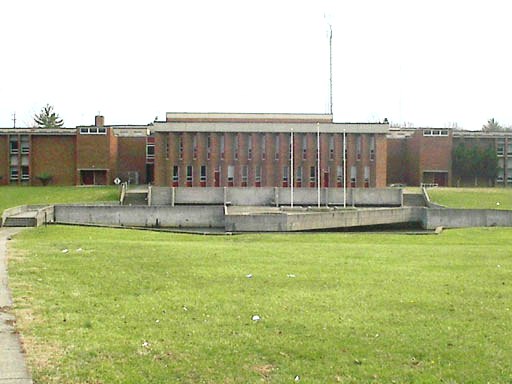


Ballard, Kentucky (City of)
(in Anderson County, Kentucky)
(McBrayer). This virtually extinct crossroads hamlet on KY Road 842, 7.5 miles southwest of Lawrenceburg, is in the
"Cut-off" section of the county, so called from its having been cut off from Mercer and Washington counties when
Anderson County, Kentucky) was formed. The post office, established on 8 August 1893 was
named either for Thomas Ballard, who, as postmaster of Lawrenceburg at that time, had helped to secure the post office
for the community; or for William Ballard, the first of that name to be listed in a county census and whose farm was a
short distance from the post office site. It closed in 1904. Caldwell's Store, an earlier post office in the area,
established by Benjamin F. Caldwell and in operation from 1866 to 1883, may also have been referred to as
Ballard 712, 958, 1387." Written by Robert M. Rennick, Kentucky Place Names, 1987, p.12.

Ballard Post Office (Floyd County) (a.k.a. Garrett P.O.)
"Garrett (Floyd County) (Wayland). This coal town with a post office is on KY Road 7 and 80 and the Right Fork of
Beaver Creek, 13 miles south of Prestonburg. It was founded around 1914 as an Elk Horn Coal
Company town named for the brothers John and Robert Garrett, Baltimore bankers and coal company financiers. The post
office established as Ballard Post Office on 2 June 1910, with Nathaniel Estepp, postmaster, became Garrett in
1914." Written by Robert M. Rennick, Kentucky Place Names, 1987, p. 114.

Ballard School (now called "Chance School" on Lime Kiln Lane) (Jefferson County,
KY)


Ballardsville, Kentucky (City of) (in Oldham County, KY)
"Ballardsville (Oldham County). This hamlet with extinct post office is centered at the junction of KY Roads 22
and 53, 2.5 miles sse of LaGrange. The post office was established sometime before 1829 and named for a family of early
settlers. It closed in 1903. 1316" Written by Robert M. Rennick, Kentucky Place Names, 1987, p.13.


Blandville (City of)
"Blandville (Ballard County). This hamlet with a post office is a recently
disincorporated town, located at the junction of Kentucky Roads 802 & 1837, 6.5 miles east of the City of Wickliffe. It was established in 1842 as the first seat of Ballard County. Like the county, it was named for [Major] Bland Ballard (1761-1853), famed Indian
fighter and state legislator. John H. Stovall, on whose land the town was laid out, became the first postmaster on 11
November 1842. The town was incorporated on 14 January 1845. After a courthouse fire in 1880 in which all
records were destroyed, the seat was removed in 1882 to the City of Wickliffe, a new town on
the Mississippi River. 169, 444. Written by Robert M. Rennick, Kentucky Place Names, 1987, p.26.

The Honorable, Dr. Josiah Bartlett, M.D., Col. (Signer of Declaration of
Independence) (Continental Congress) (1st Gov. of New Hampshire)
"BARTLETT, Josiah. 1729-1795. Signer [Declaration of Independence], Mass. After a classical
education, he started the student of medicine at [the age of] 16 and five years later began practicing in
Kingston, N.H. A successful doctor who introduced many medical reforms, he entered the provincial assembly
in 1765 and served continuously until the Revolution. He was named J.O.P. in 1767 and in 1770 took
command of a militia regiment. Governor Wentworth dismissed him from both posts in February 1775 for his
open opposition to the Crown. In 1774, he became a member of the committee of correspondence and was sent
to the first provincial congress. He had been elected to the 1774 Continental Congress, but was unable to
accept when his house, apparently maliciously, was burned down. In 1775, he was again elected and served
until 1777 when he resigned for poor health. He signed the Declaration of Independence in 1776. In 1777,
he was with Stark at Bennington as agent of the state in providing the N.H. troops with medical supplies
and was Col. of militia 1777-1779. He was re-elected to Congress in March 1778 and voted in 1781 for the
Articles of Confederation, which he had helped write. He served on many major committees and, worn
physically by Congress's many moves in 1778-1779, he refused re-election. Appointed chief justice of the
N.H. court of common pleas, he continued in the legal field when, in 1782 he was named associate justice
of the superior court. In 1778, he was made chief justice, serving two years. He helped ratify the
Federal Constitution in 1788, and was chief executive (then called president) of N.H. 1790-1792. In
1793, when the title was changed, he was elected first Governor and served for another year. He
organized and was first president of the N.H. Medical Society in 1791, the year after he was given an
honorary M.D. degree by Dartmouth." Source: Encyclopedia of the American Revolution by Mark K.
Boatner, p. 61.


Beckham County, Kentucky
"BECKHAM COUNTY, an eighty-day wonder that was abolished by state courts, was carved out of Carter
County in northeastern Kentucky, along with corners of Lewis and Elliott, as Kentucky's 120th county.
Beckham County was created by the legislature on 9 February 1904, during a period of rapid growth, in a
mix of local pride and political ambition. First envisioned as being named Harscrabble, then Goebel, it
was in the end named for the sitting governor, J.C.W. Beckham (1900-1907), with Olive Hill as county seat.
Disputing a seventy-dollar debt judgment, C.V. Zimmerman filed suit against the new county judge, Capt.
C.C. Brooks, claiming the county was unlawful because it left the parent county with few than four hundred
square miles of area each and had less area than that itself. Carter County joined the suit, claiming that
Beckham County ran too close to Vanceburg and Grayson, Both county seats, violating a ten-mile minimum set
by the state constitution. The suit also claimed that Beckham County would rob Carter of rightful taxes.
The court of appeals dissolved Beckham County on 29 April 1904. Postal orders and marriage licenses
remain the only official records of its existence. See George Wolford, Carter County, a Pictorial
History (Ashland, KY., 1985)." Written by George Wolford for The Kentucky
Encyclopedia, page 65-66; 1992.
"BECKHAM COUNTY: This was the 120th county formed in Kentucky, but you won't find it on any
current map. It lasted for only 80 days! It was made up of parts of Carter, Elliott and Lewis County. Many
historical reference works, including Everton's, does not even list it. It was abolished after being
created on 9 Feb 1904. It had been named for the sitting Governor, J. C. W. Beckham. It was also called
Hardscrabble and Goebel. Postal orders and marriage licenses remain the only official records and it is
unknown where these are stored." Source:
http://www.rootsquest.com/~jmurphy/lessons/tip_04.htm
1.) Beckham County; Parent County/Counties: Carter
Date Approved: 9 February 1904; Date Effective: 9 February 1904
Reference: "Acts of the Kentucky General Assembly," 1904, pages 27-30.
Note: Named for J.C.W. Beckham, Kentucky Governor, when the county was created. Olive Hill was designated
the county seat. The court of appeals dissolved this county on 29 April 1904.
Text of Act Creating New County:
Note: Beckham County would have been the 120th county established or the 121st if voters had approved
the establishment of Henrietta County in 1867.
CHAPTER 5. An ACT creating the county of Beckham. Approved 9 February 1904. Emergency Provision.
BE it enacted by the General Assembly of the Commonwealth of Kentucky:
SECTION 1. That the county of Beckham be, and the same is hereby, created, and the boundary lines
thereof are established as follows:
Beginning on three black oaks by the county, or old State road, the corner of John Reid's and Wilburn
Hall's and Marion Oldfield's lands, being ten and one half miles by survey from Grayson, the present county
seat of Carter county, Kentucky; thence south 12 degrees 6. east 36,740 feet to a small locust; thence
south 56 degrees west 2871 feet to a black oak near the open fork of Big Gimlet, thence north 4 degrees 30.
west 19,860 feet to a white oak on Mauck Branch so as to exclude William Binion's house; thence with the
act of 1869, approved 26 January 1869, making Elliott county; thence with Mauck Ridge to the corner of
Rowan, Elliott and Beckham counties; thence north 70 degrees 6. west 14,465 feet; thence north 26 degrees
16. west 70, 157 feet to the point near Briery Creek; thence due north 31,480 feet; thence north 9 degrees
15. east 65, 297 feet; thence due south 12,238 feet to a small hickory and oak on top of Three Prong ridge;
thence south 5 degrees 19. west 52,528 feet to the point of beginning.
SECTION 2. The seat of government or county-seat of said county is Olive Hill.
SECTION 3. Said county is, for the present, divided into five magisterial districts, numbered and
bounded as follows:
District No. 1. Beginning at the point where the line of this county crosses Cave branch; thence with
the division line between this county and Carter county to where it crosses Tygart's creek; thence up said
Tygart's creek, with the meandering thereof, to the mouth of Jarvis branch; thence up said branch, with the
meanderings thereof, including the farms of James Jarvis and William Jordan, to the county road at the head
of said branch; thence with the county road to the Corey school-house, on top of the hill; thence with the
county road to the Elliott county line, crossing Big Sinking Creek at Providence school-house; thence with
the Elliott county line to a set stone in said line, at a point due south from the main forks of Big
Sinking Creek; thence with the county road leading to Limestone, but excluding all of Limestone West of the
Jack Thompson branch; thence down Tygart's creek to the forks thereof, at the Chesapeake and Ohio Railroad
bridge, near the residence of Ex-Senator Carpenter; thence up and with the Fleming Fork of Tygart's creek,
to the mouth of Smith's Run creek; thence up said Run to the headwaters thereof, at a set stone on the
ridge dividing the waters of said Smith's Run from those of Grassy, near the residence of Samuel J.
Rayburn, but excluding it; thence with the top of said ridge to the Joseph Tutt's farm, on the headwaters
of Buffalo creek; thence an East course with the top of the ridge that divides the waters of Buffalo and
Smoky creeks, to where the old Oakland school-house was burned; thence down Cave branch to the
beginning.
District No. 2. Beginning at the point where the line between Beckham and Carter counties crosses
Tygart's creek; thence following the division line between said counties to the line of Elliott county;
thence with the Elliott county line to the corner of District No. 1; thence with the boundary lines of
District No. 1, to the beginning.
District No. 3. Beginning at the forks of Tygart's creek, at the Chesapeake and Ohio Railroad bridge, a
corner of District No. 1, and thence with the line of District No. 1 to the Elliott county line; thence
with the line of Elliott county to where it intersects the line of Rowan county; thence with the Rowan
county line to a set stone on top of the ridge which divides the waters of Tygart's creek from those of
Kinniconick creek; thence with the top of said ridge to the corner of District No. 1, near the residence of
Samuel J. Rayburn and including it; thence with the boundary line of District No. 1 to the beginning.
District No. 4. Beginning at the corner of District No. 1, at the Joseph Tutt's farm; thence running on
top of the ridge dividing the waters of Buffalo creek from those of Laurel creek to the Lewis county line;
thence with the line of Lewis county to the line of Greenup county; thence with the line of Greenup county
to the line of Carter county; thence with the line of Carter county to the beginning.
District No. 5. Beginning at a set stone in the Rowan county line, a corner of District No. 3; thence
with the line of District No. 3 in an east course to the corner of District No. 4, at the Joseph Fults'
farm; thence with the north line of District No. 4 to the line of Lewis county on Stafford's Hill; thence a
west course with the line between Lewis and Beckham counties to the Rowan county line; thence with the
Rowan county line to the place of beginning.
SECTION 4. For the purpose of selecting and acquiring grounds upon which to erect and maintain all the
necessary public buildings for said county, a board of commissioners is hereby created, to be composed of
three members, who shall be appointed by the Governor within ten days after this act takes effect, from the
two political parties, who shall be residents of this county, and who shall hold the office until the work
of the said commission is completed, and any vacancy on which shall be filled by appointment by the fiscal
court of said county.
SECTION 5. The said commission shall have power, and it shall be its duty, to provide temporary places
for holding the courts and keeping the public records of said Beckham county until permanent buildings are
provided for such purposes.
SECTION 6. When this act takes effect it shall be the duty of the Governor to appoint from the eligible
citizens of said Beckham county all the officers provided for a county by the Constitution and laws of this
State, such officers to hold until the next regular State election and until their successors are elected
and qualified.
SECTION 7. Inasmuch as the people living in the territory comprised by said Beckham county live very
remote from the county seats of their former counties and are compelled to travel long, tedious and
expensive journeys thereto, and as the expense of litigation and other public duties and privileges is very
heavy, an emergency does exist, and therefore this act shall take effect and be in force from and after its
approval by the Governor.
REF: "Acts of the Kentucky General Assembly," 1904, pages 27-30.
CHAPTER 72. An ACT to amend section 5 of an act, entitled "An ACT creating the county of Beckham" and
providing for transfer of assessment lists. Approved 21 March 1904. Emergency Provision.
BE it enacted by the General Assembly of the Commonwealth of Kentucky:
SECTION 1. That section 5 of an act, entitled, "An act creating the county of Beckham," and which
section reads as follows:
SECTION 5. The said commission shall have the power, and it shall be its duty, to provide temporary
places for holding courts and keeping the public records of said Beckham county until permanent buildings
are provided for such purposes, be so amended as to read as follows:
SECTION 5. The said commission shall have the power, and it shall be its duty, to provide temporary
places for holding the courts and keeping the public records of said Beckham county until permanent
buildings are provided for such purposes; that it shall be the duty of the county courts of any county,
whose territory is affected by the act creating the county of Beckham, to direct the county court clerks to
compile, make up and certify to the county court clerk of Beckham county the property assessment lists,
already made for the current year, of the property properly assessable in Beckham county by reason of its
location therein; and the sheriffs of said adjoining counties so affected are respectively relieved from
the responsibility of the collection of such tax lists so certified to the county court clerk of Beckham
county. For the service of so compiling and certifying such lists as herein provided, the fiscal court of
Beckham county shall allow to such county court clerks a reasonable compensation, payable out of the
revenues of said Beckham county.
SECTION 2. WHEREAS, It is necessary that the taxes due the county of Beckham be collected when due, an
emergency is declared to exist, and this act shall be in force from and after its passage and approval by
the Governor.
REF: "Acts of the Kentucky General Assembly," 1904, pages 155-156.
Source:
Secretary
of State Land Office

Honorable John Crepps Wickliffe Beckham
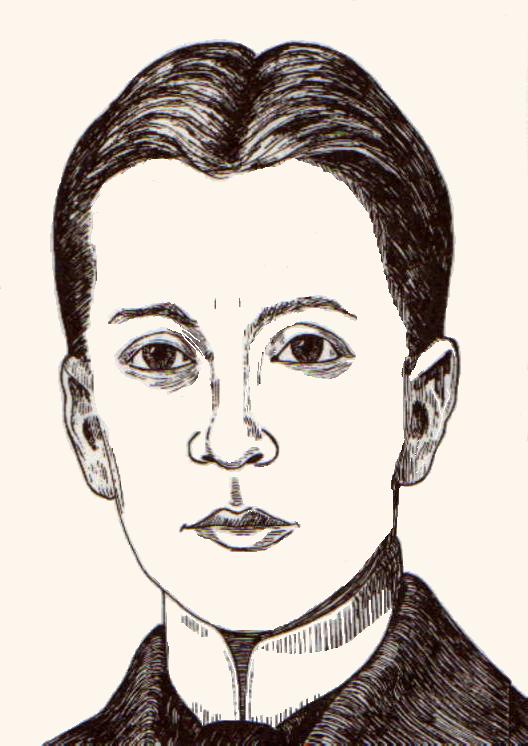
35th Governor of Kentucky; U.S. Senator; Speaker of Kentucky House of Representatives; Second Governor
of KY to ever succeed himself

Actually three Governors of KY did fill two consecutive terms (Gov. James Garrard 1796-1804; Gov.
J.C.W. Beckham 1900-1907; Gov. Paul Patton 1995-Present)...our 35th. Governor J.C.W. Beckham (3 Feb. 1900
to 10 Dec. 1907) (b. 5 Aug. 1869-d 9 Jan. 1940)(Democrat). I am related to Beckham, to his grandfather,
the "14th. Governor of KY (Honorable Charles Wickliffe) (Whig Party). Charles had
three sons and five daughters and the most prominent was his son Robert C. Wickliffe, was quite active in
politics and became governor of Louisiana [1856-1860]." I am related to these three governors who were all
born in Bardstown, KY.
From the Book, "Governors of Kentucky": "Beckham seceded to the governorship upon the death of Governor William Goebel.
In November of that same year [1900] he was elected by the people to fill out the rest of the unexpired term. He was
then re-elected to succeed himself for a full term, making his tenure last nearly eight successive years. John Crepps
Wickliffe Beckham was born at "Wickland" [Home of three Governors]
, at the edge of
Bardstown, the son of William and Julia Wickliffe Beckham. His mother was daughter of former governor Charles Anderson
Wickliffe. Beckham attended Central University at Richmond. He was appointed as principal of Bardstown public schools
in 1888, and was admitted to the bar in 1889. Beckham left his position as principal to establish a law practice in
Bardstown. In 1893 he was the Democrat nominee for the legislature, elected without opposition. He was a member of the
Kentucky House 1894-98, serving as Speaker in 1898. Beckham was selected as the nominee for Lt. governor on the
Democratic ticket with William Goebel in the election of 1899. At the age of 30, barely old enough to serve as
governor, Beckham was sworn into office on 3 February 1900, though Gov. William S. Taylor refused to vacate the office.
The Democrats retired to Louisville for a short time, and Kentucky had two state governments. The case of Taylor vs.
Beckham was decided in favor of the Democrats by Circuit Judge Fields of Louisville, a decision that was upheld by the
Court of Appeals and the Federal courts. To determine who should fill the unexpired term of Governor Goebel, a special
election was held 6 November 1990, in which Beckham defeated John W. Yerkes. Had Beckham lost the election, Kentucky
would have had four governors in less than one year's time; as it turned out, we had only three, and the third one last
over seven years. Governor Beckham married Jean Raphael Fuqua, daughter of Joseph A. Fuqua of Owensboro, 21 November
1900, shortly after the special gubernatorial election. In 1903 he was elected to succeed himself as
governor, this time he defeated M.B. Belknap, T.B. Demaree, Adam Nagel and Alfred Schmultz.
Beckham ran again for the governor's chair 20 years later and was defeated by Flem D. Sampson. He was elected to the
U.S. Senate in 1915, serving until 1921. He was not successful in his attempt at re-election to the Senate, and in 1927
was defeated by Sampson in the gubernatorial election. He died in Louisville at the age of 70, and was buried in the
Frankfort Cemetery."
Source reference Kentucky Governors by Robert A. Powell, published and distributed by Kentucky
Images, 527 South Upper Street Lexington, KY 40508-2993; Published 1989.
Honorable John Crepps Wickliffe Beckhams' history as written in The Kentucky
Encyclopedia, page 65; 1992.
"John Crepps Wickliffe Beckham, governor during 1900-1907, was born to William Netherton Beckham and Julia Tevis (Wickliffe) Beckham on 5 August 1869, in Bardstown, Kentucky. He was the grandson of Honorable Charles Anderson Wickliffe (1839-1840). He attended Central University in Richmond,
Kentucky, and then became Bardstown's principal of public schools (1888-1893). Admitted to the bar in 1889, he
opened a law practice in 1893. Beckham was elected to three terms in the state House of Representatives as a Democrat
(1894-1900). In 1899 William Goebel, accepted Beckham as his running mate for lieutenant governor.
[Initially it was thought that,] They lost, and Republican William S. Taylor was elected. But the Democratic majority
in the General Assembly reversed the decision, and when Goebel died of an assassin's bullet a few days after being
declared governor, Beckham succeeded to the office. In a special election held on 6 November 1900, to determine who
should fulfill Goebel's term, Beckham defeated Republican John W. Yerkes, 233,052 to 229,363. Anxious to reunited his
party and to calm the state, Beckham stressed non-controversial issues and the need for compromise. In 1903 he was
easily nominated for a full term as governor; he defeated Republican M.B. Belknap by 222,014 to 202,764.
As governor, Beckham called for improved roads, greater attention to penal and charitable institutions, and
improvements of the state's educational system, all consensus positions. The governor did not display strong
leadership, and the legislature showed little inclination to initiate reforms. Beckham was able to reduce the public
debt, and under his leadership a uniform textbook law was passed in 1904 and two state normal schools were created in
1906, at Bowling Green and Richmond. Beckham's ideas about railroad regulation were considerably more moderate than
Goebel's, and he did little to stop the violence of the tobacco farmers' Black Patch War. During his term, work was
begun on an imposing new state capitol.
Denied the nomination for the U.S. Senate in 1908, Beckham returned to his law practice, but in 1914 he defeated
another former governor, Augustus E. Wilson (1907-1911), in Kentucky's first popular election to the Senate and served
from 4 March 1915 to 3 March 1921, his support of President Woodrow Wilson and of prohibition cost him the election,
which he lost to Republican Richard P. Ernst by fewer than 5,000 votes. He was the Democratic candidate for governor
in 1927, but a number of his own party rejected him, and he lost to Republican Flem D. Sampson, 382,306 to 350,796. In
return for his support of Gov. A. B. Chandler (1935-39, 1955-59) in 1935, Beckham was appointed to Kentucky's Public
Service Commission in 1936. He also served as the chairman of Government Reorganization Commission. Beckham made one
further attempt to gain the Democratic nomination for the U.S. Senate in 1936, but was unsuccessful.
In 1900 Beckham married Jean Raphael Fuqua; they had two children. Beckham died on 9 January 1940, and was buried in
the Frankfort Cemetery.
See Nicholas C. Burckel, "From Beckham to McCreary; The Progressive Record of Kentucky Governors," Register 76
(Oct. 1978): 285-306; Glenn Finch, "The Election of United State Senators in Kentucky: the Beckham Period," FCHQ
44 (Jan. 1970): 38-50: Lowell Harrison, ed., Kentucky's Governors 1792-1985 (Lexington, KY., 1985)." Written by Lowell H. Harrison for The Kentucky Encyclopedia, page 65; 1992.

Julia Tevis (Wickliffe) Beckham
"Julia Tevis (Wickliffe) Beckham,
the daughter, sister and mother of state governors, was born in the family home, Wickland-
Home of three Governors, in Bardstown, Kentucky, 1835. She was the youngest daughter of Honorable
Charles Anderson Wickliffe, governor of Kentucky during 1836-1840, and Margaret (Crepps) Wickliffe. She was named
for teacher Julia A. Tevis, who had established Science Hill School for girls in Shelbyville, Kentucky, which Julia
Wickliffe attended along with her four older sisters. Her sister Nannie married David L. Yulee, who was elected a U.S.
senator from Florida; her brother Honorable Robert C. Wickliffe was governor of Louisiana from 1856
to 1860. On 16 October 1855, Julia Wickliffe married William Netherton Beckham, a Kentucky legislator who represented
Nelson County for one term. The couple's son. Honorable John Crepps Wickliffe Beckham, served
as governor of Kentucky during 1900-1907.
Julia Beckham died at "Wickland" on 1 August
1913, and was buried in Bardstown Cemetery."The Kentucky Encyclopedia, page 65; 1992.

Elizabeth Blankenbaker [Garriott] (Early settler of KY)
Henry Blankenbaker (American Revolutionary War Veteran, early settler of
Jeffersontown, KY)
Jacob Blankenbaker (Early settler of Jeffersontown, KY)
John Nicholas Blankenbaker (1717 immigrant to North America)
Nicholas Blankenbaker (American Revolutionary War Veteran, early settler of
Shelby County, KY)
Samuel Blankenbaker (American Revolutionary War Veteran, Founder of
Jeffersontown, KY)
Thomas Blankenbaker (American Revolutionary War Veteran, early settler of
Jeffersontown, KY)

Elizabeth Blankenbaker [Garriott] (Early settler of
KY)
The daughter, Elizabeth, married Ambrose Garriott. He was in the 1787 property tax list in Virginia.
Except for one very early child in the church records, they left no mark there.
All of Jacob Blankenbaker (Early settler of Jeffersontown, KY) sons,
except Nicholas Blankenbaker (American Revolutionary War Veteran, early
settler of Shelby County, KY), moved to Jefferson County, KY; Nicholas moved to Shelby County, KY.
Elizabeth, and her husband, Ambrose Garriott, moved to a different county in KY.
Jacob Blankenbaker (Early settler of Jeffersontown, KY) directed in his
will that his estate be divided when the youngest child was 21. Elizabeth, at this time, would have
been almost 70 years old, so there was about a fifty-year spread in his children's ages.

Henry Blankenbaker (American Revolutionary War Veteran, early
settler of Jeffersontown, KY)
Henry Blankenbaker (died 1801), a Revolutionary War veteran, entered 1,317 acres of land in old
Fayette County, Virginia (now Kentucky) in 1783. In 1797, he owned 250 acres on Floyd's Fork of the Salt River in Jefferson County, KY.
The second son of Jacob Blankenbaker (Early settler of Jeffersontown,
KY) to go to Kentucky was probably Henry, who is not in the 1787 Culpeper, Virginia, personal
property tax list. He was a sponsor at the baptism of a child of Joshua Yager, his brother-in-law, in
1785. At this time, he was almost 30 years old.

Jacob Blankenbaker (Early settler of Jeffersontown, KY)
Jacob Blankenbeker (Blankenbaker) migrated to Kentucky in 1782 and entered claims for 2,776 acres. He
later received 187 acres in Jefferson County, Kentucky, from his son Samuel. Blankenbaker Lane and
Blankenbaker Road were named for this family.
Jacob Blankenbeker (Blankenbaker) was the father to Henry Blankenbaker
(American Revolutionary War Veteran, early settler of
Jeffersontown, KY), Elizabeth Blankenbaker [Garriott] (Early settler
of KY), Nicholas Blankenbaker (American Revolutionary War Veteran,
early settler of Shelby County, KY), Samuel Blankenbaker (American
Revolutionary War Veteran, Founder of Jeffersontown, KY), and Thomas
Blankenbaker (American Revolutionary War Veteran, early settler of Jeffersontown, KY).
Jacob directed in his will that his estate be divided when the youngest child was 21. Elizabeth Blankenbaker [Garriott] (Early settler of KY), at this time,
would have been almost 70 years old, so there was about a fifty-year spread in his children's ages.

John Nicholas Blankenbaker (1717 immigrant to North
America)
John Nicholas Blankenbaker was the father of Jacob Blankenbaker (Early
settler of Jeffersontown, KY) and grandfather to Elizabeth
Blankenbaker [Garriott] (Early settler of KY), Henry Blankenbaker
(American Revolutionary War Veteran, early settler of Jeffersontown, KY), Nicholas Blankenbaker (American Revolutionary War
Veteran, early settler of Shelby County, KY), Samuel Blankenbaker (American
Revolutionary War Veteran, Founder of Jeffersontown, KY), and Thomas
Blankenbaker (American Revolutionary War Veteran, early settler of Jeffersontown, KY).

Nicholas Blankenbaker (American Revolutionary War Veteran, early
settler of Shelby County, KY)
Nicholas Blankenbaker (1758-1849) a Revolutionary War veteran was listed on the Mercer County,
Virginia tax list in 1789. In 1797, he bought a 175-acre tract of land in Jefferson County, KY.
Probably, the first son of Jacob Blankenbaker (Early settler of Jeffersontown,
KY) to go to Kentucky was Nicholas, who was a Revolutionary War veteran. He was in Class 1771 of
the Culpeper Classes, and was drafted, i.e., he was the selection out of the class. It is believed that
he moved shortly after the war to Kentucky. He has no records in Virginia after his military service.
All of the sons, except Nicholas, moved to Jefferson County, KY; Nicholas moved to Shelby County, KY. His
daughter, Elizabeth Blankenbaker [Garriott] (Early settler of KY), and
her husband, Ambrose, moved to a different county in KY.

Samuel Blankenbaker (American Revolutionary War Veteran, Founder of
Jeffersontown, KY)
Samuel Blankenbaker (1754-1827) severed in the American Revolutionary War. In 1783, he entered
claims for 2,700 acres in old Lincoln County, Virginia (now KY) and, 1785, he claimed 517 acres on the
Sandy River in Bourbon County, Virginia (now KY). Samuel was granted 390 acres of land in Jefferson County
in 1792.
Samuel was on of the original founders of the Lutheran Church in 1795 in Jeffersontown, Ky. This church
was considered a part of the Hebron Lutheran Church (Culpeper County, Virginia). Samuel was also one of
the original trustees of Jeffersontown, KY in May 1797.
Samuel was a communicant in 1790 (without a wife), at the German Lutheran Church in the Robinson River
Valley; however, he was not in the 1787 tax list for Culpeper County. (There is one Samuel there, but that
should be his nephew, who was 20 years old). Some say that his first wife, Amy Yager, died in 1788, so
there may have been a complicated story here. For example, he and his wife may have gone to Kentucky,
where his wife died. He may have then returned to Virginia briefly, made an appearance at the church, and
then went back to Kentucky.

Graveside ceremony honors Samuel Blankenbaker
Article published on 24 June 2008
Samuel Blankenbaker, the man known for allowing an extension to be built on his property that connected
Jeffersontown and Middletown, will be honored in a graveside ceremony on Independence Day.
The ceremony will start at 11:30 a.m. 4 July 2008 next to Blankenbaker Pond, off Bluegrass Parkway between
Campus Place and Papa John's Boulevard.
Blankenbaker, who served in the Revolutionary War and died in 1827, was granted 390 acres of land in
Jefferson County in 1792. In 1797, when Middletown and Jeffersontown were incorporated as cities, a local
court ordered Blankenbaker, who lived between the two cities, to find an agreeable route for a road to
connect them.
Blankenbaker Road, which smoothed transportation between the two cities, was extended from Jeffersontown's
Ruckriegel Parkway in 1997. In 1999, the road now known as Blankenbaker Parkway was extended to
Shelbyville Road in Middletown.

Thomas Blankenbaker (American Revolutionary War Veteran, early
settler of Jeffersontown, KY)
Thomas Blankenbaker (1763-1835) a Revolutionary War veteran, bought 115 acres on the Floyd's Fork
of the Salt River in 1796. In 1811, he had 115 acres on Floyd's Fork of the Salt River, 60 acres in Madison County,
and in 1830, owned 221 acres on Pope Lick in Jefferson County.
Thomas, was having children baptized up to 1798 in Virginia. Comparing the dates for Jacob's
move, it appears that Thomas probably went with his father (Jacob Blankenbaker
(Early settler of Jeffersontown,
KY)) to Kentucky.


Breckinridge County, Kentucky
"BRECKINRIDGE: 1799 (39th county) Breckinridge is the 6th largest county in Kentucky. It contains 566
square miles, and is bordered by the Ohio River, and the counties of Meade, Hardin
County, Grayson, Ohio and Hancock. To form the county, a portion was taken from Hardin County, KY. 19 years after Capt. William Hardin-(Revolutionary War
Capt.) erected his log fort on the site that became Hardinsburg, in the county seat. The county is
named for John Breckinridge, a Lexington lawyer and contemporary of Henry Clay. He was elected to the U.S. Senate in
1802 and served as U.S. Attorney under President Jefferson.
Cloverport, just 12 miles northwest of Hardinsburg, was established as a town
in 1828. It was the largest community in the county until 1960, when Hardinsburg
edged ahead. In 1816, when Abe Lincoln's family migrated to Indiana, they crossed the [Ohio] river at Cloverport
on a raft with a team of oxen, a cow, and household goods. Four miles outside of Cloverport was a well-known
health resort called Tar Springs, which had eleven kinds of mineral waters. It was the birthplace of
Judge Wiley B. Rutledge, Justice of the U.S. Supreme Court from 1943-1949. Coal oil was first produced
here in 1851, then exported to England via New Orleans for gas manufacture. It was used by Queen Victoria to light
Buckingham Palace. Joseph Holt lived near Cloverport. He held the offices of Judge Advocate General,
Postmaster General, and Commissioner of Patents during the Civil War." Source: Written
by Robert A. Powell Kentucky Counties, page 13; 1989.
"Breckinridge County: Named in honor of John Breckinridge, a Virginia who was one of the early Kentucky pioneers, became
our 39th County in 1800. It was formed from part of Hardin County. Its northern boundary is the Ohio River. The county
seat, Hardinsburg, was originally a frontier fort established in 1790 by William Hardin, known to the Indians as "Big
Bill." With "Big Bill" furnishing them with courage and leadership, the settlers never abandoned their Hardin fort, and
today Hardinsburg is a modern community with well-preserved, gracious old homes and a progressive outlook. Addison Dam
and Park at Lock 45, in the Ohio River on Highway KYK-144, make a popular place for picnicking and boating. North of
this dam are the birthplace and grave of Joseph Holt, Judge Advocate General of the Union Army during the Civil War. The
Holt mansion was build 180 years ago with brick made from Ohio River clay. The small town of Cloverport is touched by
the Lincoln Heritage Trail. Here Abraham Lincoln's family ferried across the Ohio River from Kentucky to their new home
in Indiana. The trail is a 1,000 mile circle tour that may be said to originate in Kentucky at Hodgenville, where the
great emancipator was born. It touches any number of sites related to Lincoln's life, and proceeds from Kentucky into
Indiana, where Lincoln grew up, and on to Illinois, where he later made his home. The Rough River and the lake formed by
damming it up, Rough River Reservoir, are on Breckinridge County's southern border. Just across the lake, in Grayson
County, is one of Kentucky's newest resort parks, Rough River Dam State Park. You can fish, boat, or water-ski on the
35-mile lake, and camp along the water's edge." Source:
http://www.rootsquest.com/~jmurphy/lessons/tip_255.htm

Honorable U.S. Vice President John Cabell Breckinridge

"Many men have contributed much of the success of the Scottish Rite in Kentucky. Space does not permit a detailed
biography of each of them. Among the many prominent Kentuckians who held membership in the Scottish Rite was John
Cabell Breckinridge, 33°, who served as the first Sovereign Grand Inspector General in Kentucky for the Supreme Council
whose headquarters are in Washington D.C. He was elected Vice-President of the United States in 1856, serving from
1857-1861; at the time of his election he was only thirty-five years old, the youngest Vice-President in the nation's
history. As a Presidential candidate in 1860 he received 82 electoral votes.
Seven men have guided the destiny of the Scottish Rite in Kentucky as Sovereign Grand Inspector Generals, Breckinridge
was followed by Frederick Webber and John H. Cowles and these two men governed the Rite from 1859 until 1952. Both also
held high positions in the Supreme Council, Cowles serving as Grand Commander for 31 years, retiring in 1952. Fourth,
Fifth and Sixth respectively were Judge Stephen S. Jones, 33°, Charles J. Weber, 33°, and George R. Effinger, 33°.
The current Sovereign Grand Inspector General in Kentucky of the Supreme Council and the titular head of
the Scottish Rite in Kentucky is John E. Moyers, 33°, who is also a Past Grand Master of the Grand Lodge
of Kentucky, Free and Accepted Masons.
John E. Moyers, 33°
Sovereign Grand Inspector General"
Source of
information


Clark County, Kentucky
"CLARK: 1792 (14th County) Clark County was carved from Bourbon and Fayette.
It spans 259 square miles and was named for pioneer hero General George Rogers Clark
(Founder of Louisville, Kentucky). He is best remembered for his conquest of the old
Northwest Territory during the Revolutionary War. Clark is bordered by Fayette,
Bourbon, Madison, Montgomery, Powell, and Estill. Winchester, is the county seat, was
named for a town in Virginia. The Courthouse, built in 1853, holds some of the oldest documents in the
state with several pertaining to Daniel Boone's land transactions. The first and last speech Henry Clay
gave was in Clark County. His first was from a tree stump, and his last was a case in the courthouse.
On Ironworks Pike, 12 miles east of Winchester, is the site of Indian Old Fields. It was a
Shawnee town called Eskippakithiki; the last Indian Village in the state. John Findley
visited it in 1752, when he was a fur trader.
Old Providence Church, between Winchester and Boonesborough, was built about
1787 of native limestone. Daniel Boone and members of his family attended services here. Noted
personalities of Clark County history include sculptor, Joel T. Hart; Honorable James A. Clark,
13th governor of Kentucky (1836-1839); and Richard Hickman, lieutenant governor (1812-1816)." Source:
Written by Robert A. Powell Kentucky Counties, page 18-19; 1989.

General George Rogers Clark's Fort (Revolutionary War Time)
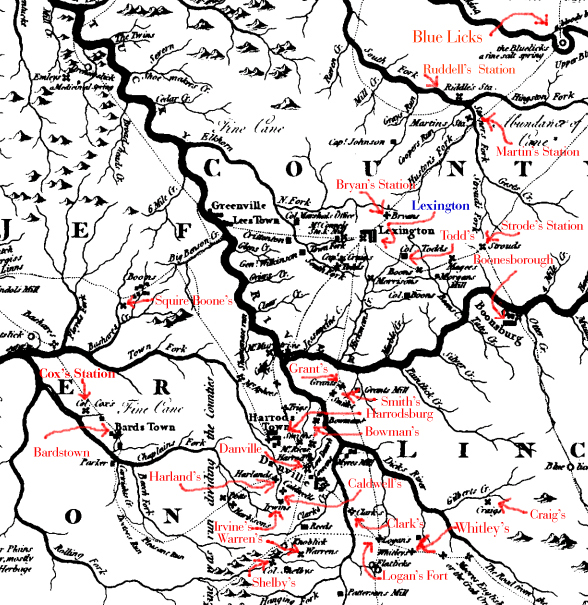
Look to the bottom, center of the map to see the fort written in red. It is just southeast of Danville,
Kentucky.

General George Rogers Clark
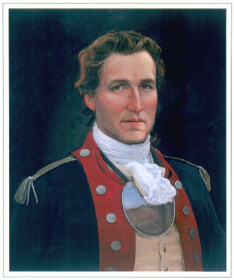
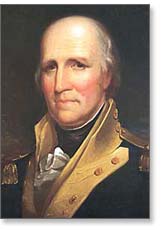
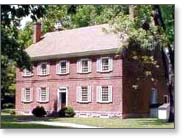
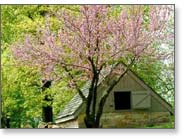
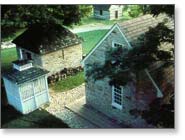
About George Rogers Clark (1752-1818)
"At 26, George Rogers Clark was a confident frontiersman with a vision that would nearly double the size of his country in one stroke. A red-haired
six-footer, Clark was a knowledgeable frontiersman, an outstanding field commander, and extremely confident of his abilities to move and persuade
anyone to do what was necessary to succeed against formidable odds of time, money, and manpower.
Kentucky was a rich wilderness before the American Revolution. The abundant game, meadows and virgin forests attracted both Native Americans from
the North and frontiersmen from the East. George Rogers Clark was one such frontiersman who described Kentucky as a "fair land". By 1776, a few
isolated settlements had sprung up, as settlers refused to heed England's proclamation of 1763 that forbade such westward settlement. When the
Revolutionary War broke out, the settlers found themselves caught without protection from Indian raids that were backed and encouraged by the
British army. Ever concerned about the safety of settlers, Clark persuaded Virginia to declare Kentucky a county of Virginia, which entitled it to
an identity, a government and supplies. Clark then convinced Virginia's governor, Patrick Henry, to send him with a small army to the areas north
of the Ohio River to capture British outposts there, thus reducing the Indian threat for Kentuckians.
After the war, George Rogers Clark settled in the rapidly growing town he had founded, Louisville. He built a cabin on land in Indiana given to him
and his men by the government, he participated in Louisville's civic affairs and helped resolve problems of land grants for his former troops. He
also served on Indian commissions because of his expert ability to negotiate with the Native Americans. Later in his life, ill health resulting
from the dreadful exposures during his long march to Vincennes began to limit his activities. Clark went to live at Locust Grove with his sister
Lucy Croghan and her family in 1809 after undergoing an amputation of his leg as a result of a serious burn. Clark continued to receive visits and
give advice towards the community at large while under the care of his sister's family. He stayed at Locust Grove until his death on February 13,
1818. He was buried in the family plot behind the house and later reinterred at Cave Hill Cemetery in Louisville.
Clark's contributions to Kentucky and to the nation are numerous. As a military commander he was
unmatched. It is to George Rogers Clark that Locust Grove remains a memorial." Source: http://www.locustgrove.org/aboutgrc.html
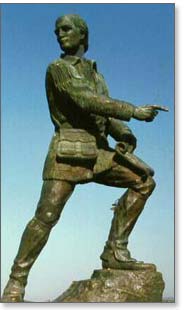
George Rogers Clark facts
At the age of nineteen, George Rogers Clark had a land claim on Fish Creek in what is now West Virginia. In 1783 Thomas Jefferson asked Clark if he
would lead an expedition to explore the western part of the continent. This endeavor was not undertaken, but Clark later would bring younger
brother William to Jefferson's attention. George Rogers Clark accepted a commission in the French Army in 1793 with the expectation that he would
lead Kentuckians against the Spanish. President George Washington ordered Kentucky Governor Honorable
Isaac Shelby-(1st. & 5th. Gov of KY) to have Clark arrested. Shelby refused. In
1812 George Rogers Clark was awarded a $400 disability pension from the Commonwealth of Virginia. An honorary sword also was awarded at that time
and is on exhibit at Locust Grove." Source:
http://www.locustgrove.org/aboutgrc.html
Locust Grove-former home of General George Rogers Clark
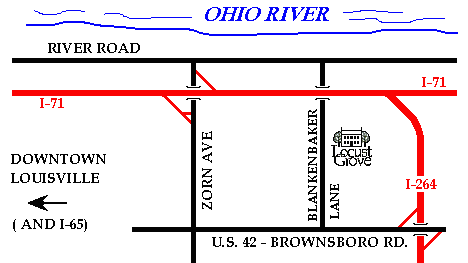
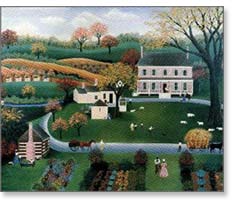
Locust Grove facts
"William Croghan served in the British army before joining the 8th Virginia Regiment to fight for independence. William and Lucy's son John Croghan
received medical training from Dr. Benjamin Rush, who also had instructed Meriwether Lewis in preparation for the Lewis and Clark Expedition. John
Croghan owned Mammoth Cave from 1839 until his death in 1849 and the family held the property until the 1920s. The reproduction shingles on the
house and some of the outbuildings are made of concrete, not wood. The property survived the 1811 New Madrid earthquake and sustained minimal
damage during a tornado in 1883 that struck the northwest corner of the house." Source: http://www.brennancallan.com/fam1.html#GGRC
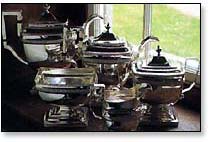
George Rogers Clark and the Illinois Campaign (1778-1779)
"In 1778, Clark traveled down the Ohio River to the Falls of the Ohio with soldiers and many families who joined the military convoy for security
and protection from American Indian attacks. For his camp, Clark chose an island at the Falls of the Ohio River. He named the place Corn Island.
This event, which took place on May 27, 1778, marks the founding of the settlement later to be named Louisville.
Clark trained his troops at Corn Island and launched a successful campaign into the lands to the north, capturing British posts at Kaskaskia and
Cahokia on the Mississippi River and Vincennes on the Wabash River. However, British Lieutenant Governor Hamilton marched from Detroit and
recaptured Vincennes from the Americans. Settling in for the winter of 1778-79, Hamilton planned to reclaim the two Mississippi posts in the
spring. Clark never gave him that opportunity.
In a daring concept, considered one of the boldest in American military history, Clark took fewer than 200 men on foot across 175 miles of flooded,
frozen plains to recapture the British fort at Vincennes. This dangerous mission took almost three weeks, but British spies never sighted Clark's
men. When Clark ordered his men to begin firing on the fort, the British did not know how many Americans were surrounding them. Clark's
frontiersmen were deadly shots, convincing the British that they were outnumbered. Hamilton surrendered and Clark ensured American control of the
Northwest Territory, a region that included the states of Ohio, Indiana, Illinois, Wisconsin and Michigan." Source: http://www.locustgrove.org/aboutgrc_war.html
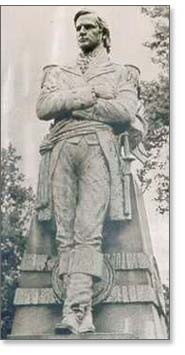
In the words of George Rogers Clark (1752-1818)
Fall, 1775, to the Virginia Council requesting support for Kentucky:
"I am sorry to find that we should have to seek protection elsewhere . . .if a country were not worth protecting, it was not worth claiming.
"Clark was requesting that Kentucky be recognized as part of Virginia."
March 6-26, 1777, Diary excerpts at Harrodsburg:
"Thomas Shores and William Ray killed near Shawnee Spring. . . A small party of indians killed and scalped Hugh Wilson. . .Archibald McNeil died of
wounds. . .A large party of indians. . .killed and scalped Garret Pendergreet; killed or took prisoner Peter Flin." That's 6 heads of families in
three weeks. There were only about 200 people in Harrodsburg at this time."
June 24, 1778, Memoir of the outset of the campaign:
"We left our little island and run about a mile up the river in order to gain the main channel, and shot the falls at the very moment of the sun
being in a great eclipse, which caused various conjectures among the superstitious. . .The whole of our force consisted only of four
companies."
Summer, 1778, Speech to the Indian Chiefs at Cahokia:
"Men and warriors, pay attention. . .I carry in my right hand war, and peace in my left. . .Here is a bloody belt and a white one. Take which you
please. Behave like men. . .if you take the bloody path you shall leave town in safety. . . and we will try like warriors to keep our clothes
stained with blood. . .If, on the other hand, you should take the path of peace and. . . listen to the bad birds that may be flying through the
land, you will no longer deserve to be counted as men but as persons with two tongues who ought to be destroyed. "He spoke to the Indians from a
position of the power that he didn't have in a voice they were unaccustomed to hearing. The British gave them presents, Clark had none to
give."
February 3, 1779, To Gov. Patrick Henry of Virginia:
"I know the case is desperate, sir. . . no time is to be lost. Was I shoer of enforcement, I should not attempt it. Who knows what fortune will do
for us? Great things have been affected by a few men well conducted. Perhaps we may be fortunate. "This was to explain his subsequent winter march
on Vincennes with only approximately 180 men."
February 23, 1779, Ultimatum to Lt. Gov. Henry Hamilton at Vincennes:
"I expect you shall immediately surrender yourself with your garrison prisoners at discretion. If any of the stores be destroyed or any letters or
papers burned, you may expect no mercy, for by heavens you shall be treated as a murtherer." This from a commander with less than 175 effective men
to a commander well fortified until spring when many Indian reinforcements were due." Source:
http://www.locustgrove.org/aboutgrc_letters.html




George Rogers Clark National Historic Park--Indiana
Link to Park
George Rogers Clark Memorial
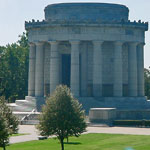
An intense interest in commemorating the great accomplishments of George Rogers Clark had developed among the citizens of Vincennes and the state
of Indiana during the early 1920s as the 150th anniversary of the American Revolution neared.
After various proposals had been considered, President Calvin Coolidge signed into law a resolution establishing the George Rogers Clark
Sesquicentennial Commission on May 23, 1928. The 15-member commission was created for the purpose of "designing and constructing at or near the
site of Fort Sackville . . . a permanent memorial, commemorating the winning of the Old Northwest and the achievements of George Rogers Clark and
his associates."
President Franklin Delano Roosevelt dedicated the memorial June 14, 1936. In 1940, the memorial became a unit of the Indiana Department of
Conservation. In 1966, Congress made the building and grounds a part of the National Park Service. The measure was signed into law by President
Lyndon B. Johnson during a ceremony at the memorial on July 23, 1966.
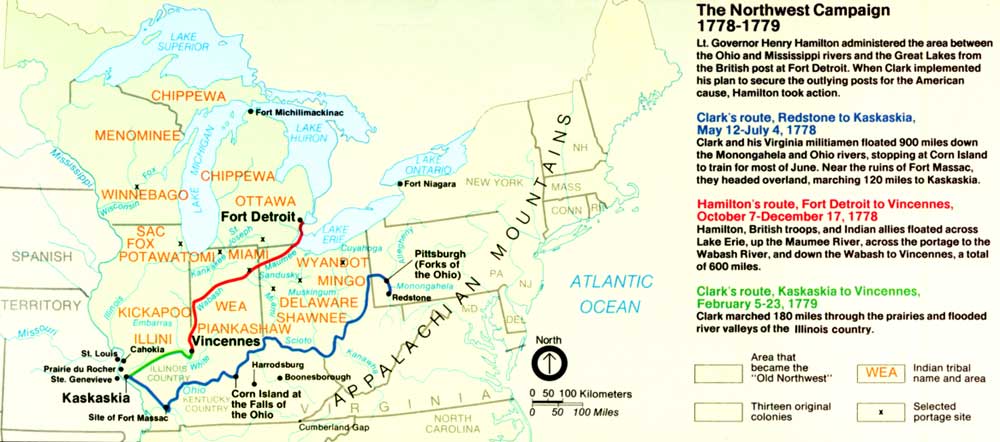
The Clark Memorial is more than 80 feet high and is 90 feet across at the base. The walls are two feet thick. The exterior is composed of
granite from Vermont, Minnesota, and Alabama. Towering over the entrance is an eagle with outspread wings. Above the 16 Doric columns is an
inscription which reads: "The Conquest of the West - George Rogers Clark and The Frontiersmen of the American Revolution."
Inside the rotunda are seven murals, each created on a single piece of Belgium linen 16 feet by 28 feet. They were painted by Ezra Winter
during a period of approximately two and a half years. Hermon Atkins MacNeil, designer of the Standing Liberty quarter, sculptured the bronze
statue of Clark.
Three of Clark's quotations are inscribed in the memorial: "Great things have been effected by a few men well conducted;" "Our cause is just .
. . our country will be grateful;" and "If a country is not worth protecting it is not worth claiming."
There are Roman numerals at three locations. Left of the steps are the numerals, 1931, the year construction of the memorial began. Above the
memorial's entrance door are the Roman numerals for the years, 1779 and 1933. In 1779, Clark captured Fort Sackville from the British and in 1933,
the memorial was completed. Clark's birth and death years of 1752 and 1818 encircle the statue's base.
It is highly fitting that the nation honors the great individuals and deeds of the past. Certain things do not change. The virtues that Clark
and his men exhibited transcend an era. A memorial such as this serves as a reminder that courage, fortitude, and valor do not go out of style. The
truly great heroes of history age well and provide guidance for the future.
To learn more about the history of the Memorial, please read the Historic Structures Report/Historical Data written by Edwin C. Bearss (1970).
Upon entering the memorial rotunda, the presence of George Rogers Clark is immediately felt as one sees the Herman McNeil statue of soldier,
patriot, Clark, standing in military uniform. The bronze statue of Clark, which stands eight feet tall and weighs seven and one half tons, depicts
a young man. Clark was only 26 years old when he conceived of the idea of leading his brave frontiersmen into the Illinois Country. Truly a man of
vision, Clark felt that only a strike at the heart of the British controlled countryside would lead to an end to the horror of Indian raids on
frontier settlements.
The inscription at the base of the Clark statue reads, "If a country is not worth protecting it is not worth claiming."
Upon the walls of the memorial rotunda, seven murals depict the Clark expedition story. The murals, which are oil on canvas, stand 28 feet
tall. It would take artist Ezra Winter and six assistants two years to complete them.
George Rogers Clark Memorial Murals
Mural #1
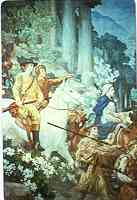
Kentucky:
Entering the Great Valley |
Mural #2

Cahokia:
Peace or War with the Indians |
Mural #3
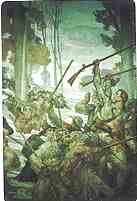
The Wabash:
Through Wilderness and Flood |
Mural# 4
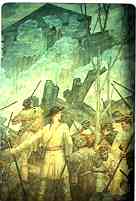
Vincennes:
The British Barrier to the West |
Mural# 5
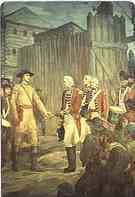
Fort Sackville:
Britain Yields Possession |
Mural# 6
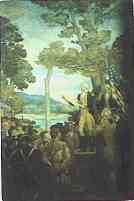
Marietta:
The Northwest, A New Territory |
Mural #7
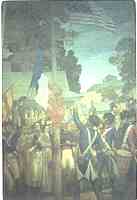
St. Louis:
Way Opened to the Pacific |
Statue
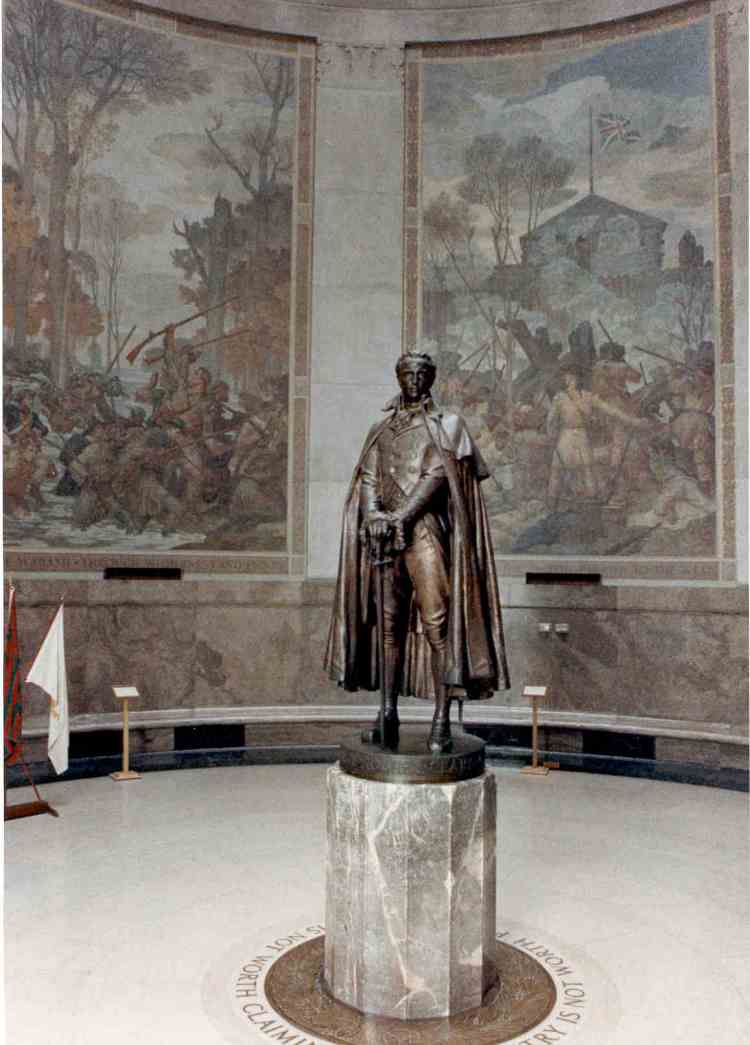
George Rogers Clark statue
in the Memorial rotundra |
Memorial
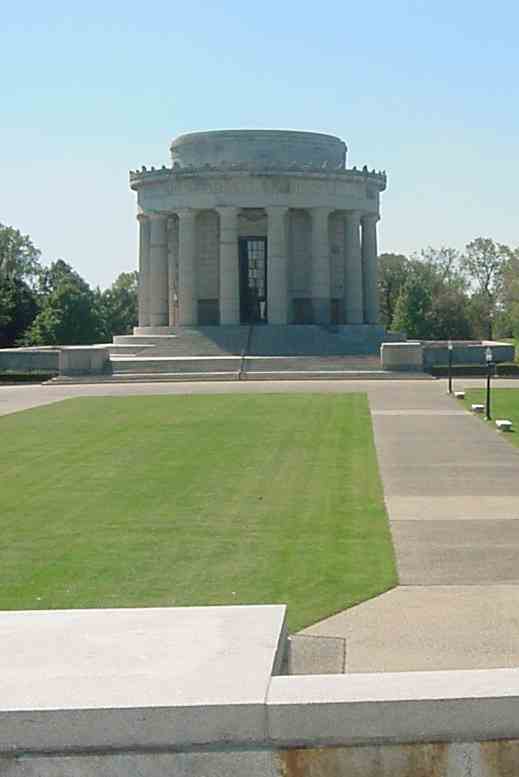
George Rogers Clark Memorial |
Clark's & Logan's Flag
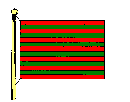
Although we do not know what "rebel flag" was raised above the fort on the day of the surrender,
we do have records of one flag used by Clark.
This flag was authorized by George Rogers Clark and was designed by Captain Leonard Helm. In all
probability, it was the flag that Lieutenant Governor Henry Hamilton mentioned in his journal on
December 17, 1778. Hamilton says: "On my approach to St. Vincennes (I) was not a little surprized
to see at a landing place about a small mile above the fort, our boats with a small guard, and the
Gunboat with the flag, hawled on shore- The American flag at the same time being displayed on the
Fort I now presumed that some reinforcements had come to the Garrison. . . ."
To understand the origin of the colorful red-and-green flag, now known as the flag of George
Rogers Clark, it is necessary to look at the ledger of Vincennes inhabitant Francis Bosseron. On
November 12, 1778, Bosseron listed in French the following items:
Paid to St. Marie for 5 ells [an ell of material measured 45 inches] of red serge for the
flag (pavilion) at 9; 45 Livers [livres]
Paid to Mr. Dajene for 3 3/4 ells of green serge at 10; 37 Livers [livres]
Paid to Madame Goderre [Godare] for making the flag; 25 Livers [livres].
Of all the flags and banners used by Clark and his men, the 13-striped-red-and- green flag is the
only one that historical records describe.

General William Clark
Governor of Missouri Territory (Bet. 1813 - 1821)
Corps of Discovery (Bet. 1803 - 1806)
Served in KY Militia and commissioned a lieutenant in U.S. Army (1792)
Indian Agent for Louisiana Territory (Bet. 1807 - 1813)
Superintendent of Indiana affairs (Bet. 1807 - 1938)
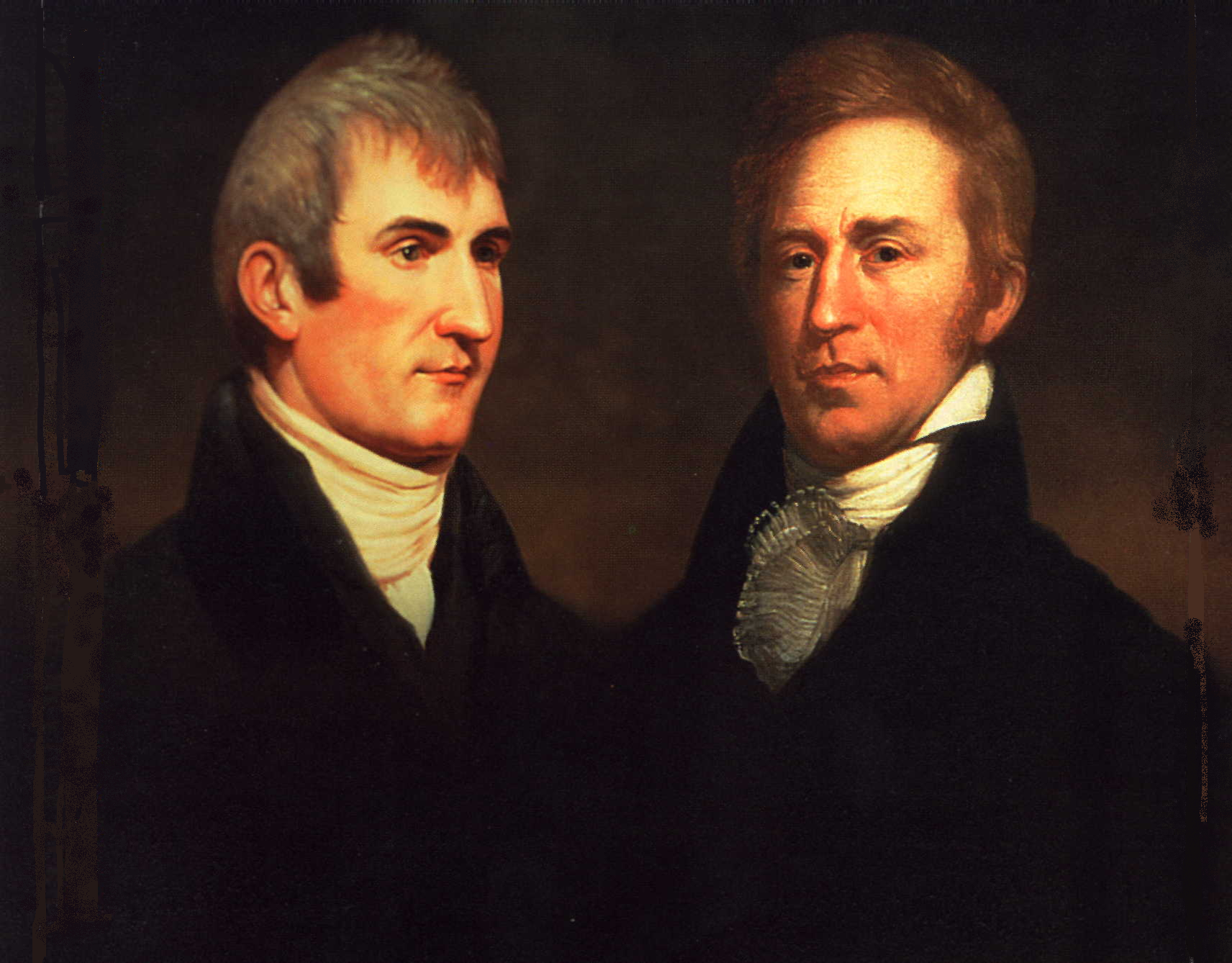
Meriwether Lewis and William Clark (Co-leaders of the Corps of Discovery).
Source: Independence National Historical Park

"Over the course of two years, four months, and nine days the legendary Meriwether Lewis and William Clark
along with their expedition members traveled a total of eight thousand miles and embarked upon a threshold
of discovery that would later become one of the most productive and successful military operations and
scientific explorations known to the United States of America.
Sent by president Thomas Jefferson, Captain Meriwether Lewis' mission was to merely map a water route
across the continent and gather information on Indian cultures and the nature that he would encounter
along the way. Lewis was given the ability to hand select his expedition members and almost immediately
Lewis' former comrade William Clark was selected to help lead the expedition.
Together, the expedition explored, catalogued, and discovered remarkably scientific things, including 178
new plant species, along with 122 previously unknown animal life species. They recorded a variety of
natural flora and fauna and peacefully met with a variety of Indian groups. Countless new geological,
meteorological, and topographical records were formed of the area between the Missouri River and the
Pacific Coast, vastly changing what was known about the world around them."

 Photo courtesy of Filson
Club, Louisville
Photo courtesy of Filson
Club, Louisville
"Meriwether Lewis was born in Virginia in 1774. At age 18, he was managing his family's plantation in
Virginia. He joined the militia in 1794 and later joined the United States Army in 1795. Lewis served
with General Anthony Wayne and moved on to a rifle company commanded by Captain William Clark where a
friendship was formed between the two. Lewis then advanced to Captain in 1800 and in 1801 was asked to
serve as Thomas Jefferson's private secretary in Washington. Jefferson gave Lewis the chance of a
lifetime, an opportunity that would later become one of the greatest journeys and legends known in the
United States. Jefferson selected Lewis to head an expedition to the Northwest in 1803, Lewis immediately
accepted. Afterwards, Lewis was appointed governor of Louisiana Territory in 1807 and later committed
suicide in 1809, leaving the journals of the expedition behind."

 Photo courtesy of Filson
Club, Louisville
Photo courtesy of Filson
Club, Louisville
"William Clark was born in Virginia in 1770, as the younger brother of General George Rogers Clark. In
1785, his family relocated to Jefferson County, Kentucky. In 1792, Clark was chosen as second lieutenant
in the United States Army; serving under General Anthony Wayne, where he would participate in the battle
of Fallen Timbers. He later became captain of a rifle company in which Meriwether Lewis served. Clark
resigned from the army in 1796 to spend time with his family, but in 1803 was requested by Lewis to
accompany him on an expedition to the Northwest. Immediately Clark jumped at the chance and joined Lewis
in his endeavors. In 1807 Clark was selected to be chief Indian agent and brigadier general of the
militia and later as the governor for Louisiana Territory. He died in St. Louis in 1838."
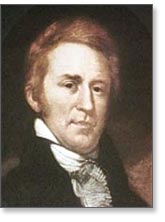
General William Clark (1770-1838)
"William Clark came to Kentucky with his parents in 1784. In 1789 he fought the Indians in an expedition
led by Col. John Hardin-(Revolutionary War Col.). In 1790 he was sent on a
mission to the Creek and Cherokee nations and in 1791 served as an ensign and acting lieutenant on the
expeditions under general Scott and Wilkinson against the native Americans on the Wabash. General
Washington commissioned him a first lieutenant in the 4th Sub Legion under General Wayne in March 1793.
William came home to Kentucky in 1796 and lived with his parents at Mulberry Hill. When they died, he
inherited the homestead but sold it to his brother, Jonathan, in 1800. He then moved to Clarksville,
Indiana, with his brother, George Rogers Clark.
In 1803, President Thomas Jefferson commissioned Meriwether Lewis and William Clark to make a western
expedition to establish an American presence in the far northwest; to investigate a water passage to the
Western Sea; to map and investigate the new Louisiana purchase; to report the culture, commerce, and
capabilities of the many native-American tribes of the area; and to observe and collect botanical and
biological specimens.
Members of the expedition assembled at Louisville, KY, in October, 1803, and moved on to camp above St.
Louis on the east bank of the Mississippi for the winter, pending signing of the Louisiana Purchase. Upon
reaching the native Mandan villages in present-day South Dakota, they acquired the services of Toussaint
Charbonneau, a French trader, and his pregnant 15-year-old Shoshone wife, Sacagewea (Suh-COG-uh-wea, "Bird
Woman"), as interpreters, not as guides.
By June of 1805, Lewis and Clark and their party were at the Great Falls of present-day Montana and made a
difficult 10-day portage around it. Obtaining horses from the Shoshones, they crossed the Bitterroot
Mountains, came down the Columbia River to the Pacific Ocean in late November, and wintered at Fort
Clatsop (Oregon). The expedition returned to St. Louis on 20 September 1806, to the astonishment of many
who had given them up for dead months ago. After disbanding most of the company, Lewis and Clark returned
east in October, pausing for three weeks at Locust Grove, home of Clark's sister, Lucy Clark Croghan.
Lewis then moved on to report to the President in Washington City where Clark later joined him.
After Clark's marriage in 1808, he was appointed Indian agent at St. Louis. In 1813, he was made Governor
of the Missouri Territory. In 1822, President Monroe appointed him Superintendent of Indian Affairs to
establish and secure treaties with the western tribes. He died in St. Louis in 1838, esteemed by all who
knew him."
General William Clark facts
"William Clark, born in 1770, was the only son of John and Ann Rogers Clark's six sons who did not
participate in the Revolutionary War. William Clark was married twice. He and older brother Jonathan are
the only siblings whose ancestors continue the Clark name. York, William Clark's slave who accompanied
Clark on the Lewis and Clark Expedition, was not granted his freedom, or manumitted, until over a decade
after their return from the Pacific. William Clark's grandson, Meriwether Lewis Clark, Jr. founded the
Louisville Jockey Club, later Churchill Downs, and the Kentucky Derby."
Lewis & Clark Story
"Meriwether Lewis and William Clark visited Locust Grove together on 8 November 1803 upon returning from
their historic expedition to the Pacific. Locust Grove is the only verified remaining structure west of
the Appalachian Mountains known as a stopping point for Lewis and Clark. It was here that people at the
Falls would have had perhaps the first opportunity to learn about what remains the greatest exploration
venture in our county's history. George Rogers Clark, older brother to William Clark, spent the last nine
years of his life at Locust Grove, from 1809 until his death in 1818."
Lewis and Clark at the Falls of the Ohio -- A Timeline
by James J. Holmberg, The Filson Historical Society.
The following is an excerpt from a longer piece by the same title:
23 September 1806 - The Lewis and Clark Expedition arrives in St. Louis, essentially ending the epic
journey. Lewis and Clark collaborate on a letter to Jonathan reporting their successful return and
reporting on the expedition since leaving the Mandan villages in April 1805. Since he will soon be with
Jonathan can tell him more then. The letter is intended for publication and in a letter to Jonathan dated
the following day, William reminds his brother to have it published. He also anticipates their arrival at
the Falls about October 9 or 10 [they arrived November 5] and says they will remain in the neighborhood of
Louisville for a few days.
23 September 1806 - Lewis to Jefferson. Reports the expedition's successful return. States their
intended route east will be through Cahokia, Vincennes, Louisville, Crab Orchard, Ky., Abingdon, Va. . . .
to Washington. Direct his mail to Louisville.
9 October 1806 - William's letter to Jonathan is published in the Frankfort Palladium. It is the first
detailed printed account of the return of the expedition. This report is reprinted in newspapers
throughout the country and abroad.
10 October 1806 - the members of the Corps of Discovery are discharged at St. Louis.
5 November 1806 - Jonathan Clark diary. "Captains Lewis & Clark arrived at the Falls on their return
from the Pacific Ocean after an absence of a little more than three years." [Lewis and Clark and the party
with them (some but not all of the men) took the southern route rather than the Vincennes route they had
planned to. They crossed into Kentucky from Illinois and came up through the counties bordering the river
to the Falls. That same day and over a number of succeeding days Clark is in the store of Fitzhugh and
Rose in Louisville. During this time Lewis and Clark apparently spent most of their time in the
Louisville area, but probably were in Clarksville also.
8 November 1806 - Jonathan Clark diary. Jonathan with Lewis and Clark at the Croghan's Locust Grove
estate for a family gathering and welcome home celebration.
9 November 1806 - Lewis at Louisville writes secretary of War Henry Dearborn.
Ca. 11 November 1806 - Meriwether Lewis and most of the party, including two Indian delegations going
to Washington, leave Louisville, traveling to Frankfort and then separating and going by different routes
- one overland due east through Lexington and the other (led by Lewis) southeastward through the
Cumberland Gap and then down Virginia's Great Valley.
14 December 1806 - Clark, near Louisville [?] to William Croghan. Will leave tomorrow for the eastward,
stopping first at Col. Richard C. Anderson's [east of Louisville] and taking the Wilderness Road via
Danville. Ca. 15 December 1806 - William Clark and most likely York leave the Louisville area for the
East, traveling overland via the Wilderness Road through the Cumberland Gap and down Virginia's Great
Valley.
Ca. April 1810 - Nicholas Biddle interviews William Clark re: the official expedition history (published
in 1814). From these conversations, Biddle's notes recorded that Lewis joined Clark who then resided at
Louisville and from Louisville they proceeded by water to St. Louis; the party consisted of three groups
of men, one of which was young Americans from the neighborhood of Louisville, they numbered nine and joined
at Clarksville and/or Falls of the Ohio (York is listed separately as Clark's servant); the original design
of Lewis and Clark was to go up the Missouri in boats from Louisville after wintering at Charette (about
150 miles up the Missouri). [How accurate Biddle's notes are and how accurate Clark's recollections are
cannot be fully determined. As written it is clear the facts are a bit incorrect based on the previously
cited primary sources from the date of the events themselves. After Clark's apparent statement that his
and Lewis's intent was to go up the Missouri from Louisville, Biddle bracketed in St. Louis, apparently
assuming Clark meant to say it instead. This is not necessarily so. In Clark's mind, he very well may
have considered the start of the expedition to have been Louisville (more correctly the Louisville area).
His statement that he resided in Louisville is not completely correct, because we know he had moved across
the river to Clarksville earlier that year. Given his brief residence in Clarksville after living in
Louisville for eighteen years, he may not have considered Clarksville his home. This possibility is
supported by an 1828 deposition Clark gave in which he stated he had lived in Louisville until 1803 at
which time he was out of the country for three years. Regarding the men enlisted at the Falls,
they were recruited in Louisville, most likely Clarksville, and by Lewis upriver. They most likely were
actually enlisted at Clarksville and Louisville given their scattered dates of enlistment, thus referring
to the Falls as the place of their enlistment.]
Sources:
Donald Jackson, ed. The Letters of the Lewis and Clark Expedition with Related Documents, 1783-1854, 2
vols. (Urbana: University of Illinois Press, 1978); William Clark Papers - Voorhis Memorial Collection,
Missouri Historical Society, St. Louis, Mo.; The Kentucky Gazette, Lexington, Ky.; The Pennsylvania
Magazine of History and Biography, vol. 43 no. 2, 1919; Dwight L. Smith and Ray Swick, eds. A Journey
through the West: Thomas Rodney's 1803 Journal from Delaware to the Mississippi Territory (Athens: Ohio
University Press, 1997); Jonathan Clark Diary, Clark-Hite Collection, The Filson Historical Society,
Louisville, Ky.; Jonathan Clark Papers - Temple Bodley Collection, The Filson Historical Society; Roy E.
Appleman, Lewis and Clark: Historic Places Associated with their Transcontinental Exploration (1804-1806)
(Washington: U.S. Department of the Interior, National Park Service, 1975; second printing, St. Louis: The
Lewis and Clark Trail Heritage Foundation and Jefferson National Expansion Historical Association, 1993);
Stephen E. Ambrose, Undaunted Courage: Meriwether Lewis, Thomas Jefferson, and the Opening of the American
West (New York: Simon and Schuster, 1996). Source: http://www.locustgrove.org/


Clay County, Kentucky
"CLAY:1806 (47th) Clay County, with an area of 474 square miles, was formed from Madison, Floyd, and Knox counties. It
was named for General Green Clay who came from Virginia in 1777 and served in the Kentucky Constitutional Convention and General
Assembly. He commanded a force of 3,000 Kentuckians in the War of 1812. General Green Clay was the father of Cassius M. Clay and a distant
cousin to Henry Clay.
The county seat, Manchester, was named for the great manufacturing city of Manchester, England, where General Clay's wife lived.
Cherokee Chief Red Bird named the rivers and forests in Clay County. Early fur traders and explorers settled around the salt springs, and
in 1798, James Collins erected a cabin and constructed a salt extracting operation at the mouth of Collins Creek. This became the first
settlement.
Col. Theophilus T. Garrard, the proprietor of extensive salt works in Clay County, led a regiment of mountaineers against a force of 7,000
Confederates at Wildcat Mountain. Although greatly outnumbered, Garrand's men held the Rebels until Union reinforcements
arrived.
The first toll-house in Kentucky was built in the 1700's by Dillion Asher."
Source: Written by Robert A. Powell Kentucky
Counties, page 18-19; 1989.

The Honorable Henry Clay (U.S. Presidential Candidate / U.S. Congressman)
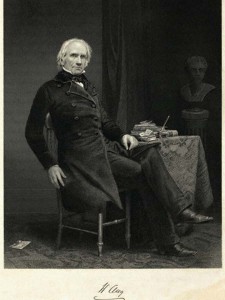
Ashland
"On 29 June 1852, Henry Clay asked his son Thomas to come and sit by his
bedside. Just before the hour of noon, "The Great Compromiser" drew his last breath. At that point his
life became a completed major chapter in the political history of the United States. Henry Clay had lived
through and served in some political position for a half a century. No single statement would adequately
cover his active public life.
Clay claimed to have been cradled in the American Revolution, a claim which had some substantial fact
behind it. He was born the seventh son of nine children to Reverend John and Elizabeth Hudson Clay on 12
April 1777. As a three-year-old he had seen the British troops under the notorious raider Banastre
Tarleton ransack his family home.
As a youth Clay had grown up in a rural slaveholding environment in Hanover County, Virginia, a county
which had spawned Patrick Henry and other Virginia political leaders. In his political life Clay was to
make some stout claim to having been a mill boy of the Slashes. More importantly his widowed mother had
married Captain Henry Watkins who was able to get the adolescent Clay into Peter Tinsley's chancery office
as a clerk. Clay entered this public service in a lowly position with only a limited amount of formal
education. In Tinsley's office, and then as an amanuensis in Chancellor George Wythe's office the young
Clay developed a clear and precise angular style handwriting which remained clear until almost the moment
of his death. During more than half a century Henry Clay was to produce literally thousands of
handwritten letters, legal briefs, and public documents.
Little could that youth of twenty years of age, and a newly licensed attorney to practice his profession
in Virginia, have imagined on that November morning, 1797, when he set forth to find clients and fortune
in Kentucky, that the expanding West would become so vital a part of his life. In Lexington, Clay
presented his Virginia license to the court and was given one to practice in Kentucky. Almost immediately
the young Virginian entered into the public and social life of rapidly expanding central Kentucky, within
a decade he established a reputation as a highly successful trial lawyer.
He made a successful marriage with Lucretia Hart, the daughter of one of Kentucky's major
pioneering land families. Almost by force of environmental and family circumstances, Henry Clay was to
become a major land owner, livestock breeder, and farmer. For half a century Ashland was to become not
only a family home to the Clays, but also a focal agricultural center in Kentucky, and a national one in
politics.
Henry Clay began his political career in 1803 when he was elected to the Kentucky General Assembly. In
that body his Jeffersonian views were pitted against the conservative federalist one of
Humphrey Marshall, a fact which resulted in a somewhat comic opera duel. In 1806 Clay was employed to
defend Aaron Burr, a ticklish task which he abandoned when he was appointed to the United States Senate
that year at the very young age of twenty-nine years. On 11 January 1808, he was chosen Speaker of the
House of Representatives, and in January 1810 he was returned to the U.S. Senate. hc2z.jpg However, in
August of that year he was elected once again to the House of Representatives and served as speaker in the
Twelfth, Thirteenth, Fourteenth, Fifteenth, and Sixteenth Congresses. Clay's was to be a major voice in
the troubled years in American-British relations from 1808-1814. He served as commissioner to the joint
American-British peace negotiations in Ghent, Belgium in 1814.
Back home after 1815, Henry Clay became involved in nearly every national issue. He opposed the
Adams-D'Onis Treaty, and supported the independence of the Latin American republics. The issues,
however, which thrust him into the political limelight were the Missouri Compromise, the banking
issues, opposition to Andrew Jackson, and promotion of his American System. No doubt the most important of
these was the negotiation of the Missouri Compromise which was fundamental in maintaining American unity,
providing some kind of workable sectional policy regarding slavery expansion, and some kind of western
policy. At heart Henry Clay favored the gradual abolition of slavery as demonstrated in his strong
support of the American Colonization Society attempt.
There burned deeply in the Clay psyche a yearning to be President of the United States. He made his first
gamble for this office in 1824 with only a remote chance of winning. In 1832 he once again
attempted to be elected president. He suffered his most disappointing loss for the office in 1844.
At the moment Henry Clay lay dying in Washington, he must have looked back upon his career as lawyer,
state representative, United States Senator, Congressman, Speaker of the House, a peace commissioner,
Secretary of State, on the Missouri Compromise, the compromise tariff bill revision in 1833, his American
System, the Texas question, and the Compromise of 1850, his greatest victory.
Through the bitter raw political years in American history, Henry Clay prevailed. Even in the face of
great family tragedy, he prevailed. Contemporaries branded him with numerous political epithets, but these
he survived. Few American politicians could claim so many victories, or engage in so many gambles, and
still claim an exalted place in political history. Perhaps Henry Clay's greatest honor was
the post mortem one he received when a great majority of American historians honored him as having been
one of the greatest United States Senators. The name of Henry Clay was stamped deeply on the American
political scene during his lifetime, but perhaps his true greatness has emerged since in the overflowing
stream of impressive monographs and biographies of his life and achievements. In his image is reflected
that of a young republic undergoing the trials and tribulations of becoming a mature, powerful nation."
by Dr. Thomas D. Clark

Ashland
HENRY CLAY CHRONOLOGY
1777 - Born: Hanover County, Virginia (12 April)
1781 - Father dies
1791 - Mother moves to Kentucky
1792 - Goes to work for George Wythe
1796 - Studies law under Robert Brooke
1797 - Admitted to bar; moves to Kentucky
1799 - Marries Lucretia Hart
1803 - Elected to state legislature
1805 - Law professor at Transylvania University
1806 - Sent to U.S. Senate at age 29
1807 - Elected to state legislature and Speaker of the House
1809 - Elected to U.S. Senate
1811 - Elected to U.S. House of Representatives and Speaker of the House
1814 - Peace Commissioner at Ghent
1816 - Presides at formation of American Colonization Society
1821 - Authors the second Missouri Compromise
1824 - Appointed Secretary of State under John Quincy Adams
1828 - Rejects offer of appointment to Supreme Court
1829 - Returns to Lexington to farm and practice law
1831 - Elected U.S. Senate; nominated for Presidency
1832 - Authors Compromise Tariff Act
1836 - Elected President of American Colonization Society
1842 - Resigns as U.S. Senator
1844 - Nominated for Presidency
1849 - Returns to U.S. Senate
1850 - Authors Compromise of 1850
1851 - Resigns from U.S. Senate
1852 - Dies in Washington D.C. (29 June)
History of The Ashland Estate
On 15 April 1849, Henry Clay wrote, "I am in one respect better off than Moses. He died in sight of, without
reaching, the Promised Land. I occupy as good a farm as any that he would have found, if he had reached it; & it has
been acquired not by hereditary descent, but by my own labor." Henry Clay deeply loved Ashland, the farm and home he had
built upon it. For him, it provided a place of refuge and sanctuary from a difficult and often disappointing world and
was one of the few places where Clay regularly found happiness. For Henry Clay's descendants, Ashland was a place of
great reverence, inspiration, and attachment. For the students and regent of Kentucky University and the Agricultural and
Mechanical College, Ashland was a place of learning, development, and growth. For today.s visitors, Ashland is a place
of great history, pride, and awe.
This engraving of the early Ashland shows the mansion and several outbuildings as they were in Henry Clay's time.
In 1804, Henry Clay began to acquire land for a farm for his young family. He had lived in Lexington since 1799, but by
1804 Clay was ready to move from his town home on Mill Street to a more substantial residence on the outskirts of town.
By 1809, the center block of his new home was complete and Clay was residing on the farm he named Ashland for the ash
trees abundant on the property. By 1811, Clay desired still more room and received plans to add wings to Ashland from
Benjamin Latrobe, architect of the Federal Capitol. Within a year or so, the home was a full five-part Federal
structure including a center block, two hyphens (connecting pieces), and two end blocks. Clay and his wife, Lucretia
Hart, resided at the home until his death in 1852.
When Clay died his will dictated that Lucretia would have a life estate in the property, but when she left or died, the
property would be sold to settle the estate. A short time after Clay's death, Lucretia moved to her son John's home
(called Ashland on Tate's Creek) and Ashland was sold to another of her sons, James.
Upon purchase of Ashland, James Clay found the mansion in a state of serious disrepair. He arrived at the difficult
conclusion that there was only one thing to be done: raze the house and rebuild. James had the house torn down, taking
care to save all materials that could practically be salvaged. He then rebuilt the home on the existing foundation
following his father's original floor plan. James Clay carefully and thoughtfully rebuilt Ashland as a memorial to his
father, Henry Clay. He did incorporate certain Italianate, Greek Revival, and Victorian details in the rebuilding to
bring the house into the more current style, but by and large intentionally recreated his father's home.
A Lexington photographer named Mullen took this picture of Ashland for a stereoview in the late 1860s. It shows the
house as rebuilt by James B. Clay. James Clay resided at Ashland until 1862 at which time he fled Lexington because of
fear of retribution due to his strong Confederate leanings. He first traveled to Cuba then on to Montreal where he
remained until his death in 1864, never to return to the memorial he built to his father. In 1866, Ashland was bought
by John Bryan Bowman to become part of the new Kentucky University.
Bowman moved to Ashland in 1866 and initially used the home as a residence, but after a time, determined it had more
room than he needed. As a result, selected rooms on the first floor were designated for the university's use as a
museum. Unfortunately, by the late 1870s Bowman's relationship with the University's Board of Directors had begun to
deteriorate and he was fired. He was forced to leave Ashland in 1878. While still owned by Kentucky University,
Ashland was rented out until 1882 when it was sold to Henry Clay's granddaughter, Anne Clay McDowell, and her husband
Henry Clay McDowell, who had been named in honor of her famous grandfather. The McDowells returned Ashland to family
ownership for the first time in 16 years.
Ashland as it appeared not long after the McDowells moved into it. The McDowells immediately engaged in major
renovation and restoration. They kept the house largely the same, but made several significant interior alterations to
modernize it and bring it into a more popular style. Anne and Henry Clay McDowell resided at Ashland until their
deaths. At that time, their oldest child Nannette took possession of the home. Nannette McDowell Bullock, her husband
Thomas, and son Henry were the last residents of Ashland, and it is through Nannette's efforts that the Henry Clay
Memorial Foundation was created, preserving Henry Clay's legacy, the house and 17 remaining acres for future
generations.
On 12 April 1950, a huge crowd gathered to hear Vice President Alben Barkley dedicate Ashland as a historic house
museum dedicated to preserving the legacy of Henry Clay. Since 1950, Ashland has been open to the public as a historic
house museum. Due to its long and varied history, Ashland may be thought of today as an "onion," the layers of which
can be peeled away to reveal the history of the home and its occupants and, remaining at its core, Henry Clay's
five-part Federal structure and floor plan. To this core have been added son James Clay's Greek Revival, Italianate,
and Victorian flourishes and Eastlake and Aesthetic details added by granddaughter Anne Clay McDowell.
Ashland was made a National Historic Landmark in 1961 with the presentation of this plaque. Today, Ashland is a
National Historic Landmark and site of profound history. It serves as a place of retreat and comfort for many of its
neighbors, the people of Lexington, and thousands of visitors who visit the site each year. Most of all,
it is a reminder of the .Promised Land. that Henry Clay and his descendants found here.


Crittenden County, Kentucky
"CRITTENDEN: 1844 (92nd county) Crittenden County is bordered by the Ohio River and the counties of Union, Webster, Lyon,
Caldwell, and Livingston. It was carved from Livingston and includes an area of 365 square miles. The country is named for Honorable John J. Crittenden-(17th Gov of KY), who served as U.S. Attorney General under three presidents, was U.S.
Senator five times, and governor of Kentucky. Located on the Ohio River across from Illinois, Crittenden County was at one time the
world's leading source of fluorspar. It was used in making steel, aluminum, porcelain, optical lenses, and glass products.
The county seat, Marion, was incorporated in 1844, and named in honor of General Francis Marion, the famous "Swamp Fox" of the
Revolutionary War. Chickasaw Road, across the northern part of the county, was used by Indians in their hunt for deer, elk, and
buffalo. The animals crossed the Ohio River here to reach the salt licks of Illinois.
Crittenden County fell prey to looting but little fighting during the Civil War; however, the courthouse was burned by guerrillas in January
of 1865." Source: Written by Robert A. Powell Kentucky Counties, page 19-20; 1989.

Honorable John J. Crittenden-(17th Gov of KY)
17th Governor of Kentucky (1848-1850);
State House of Representatives; Speaker KY House of Representatives 1829-32;
Kentucky Secretary of State (1834-1835);
U.S. District Attorney for Kentucky (1827);
U.S. Senator (1817-1825, 1835-1841, 1854-);
U.S. Attorney General (1850);
U.S. Secretary of State (1851);
Attorney General for Illinois Territory (1809);
Served as U.S. Attorney General under 3 U.S. Presidents;
Served as U.S. Senator for 5 terms of office.
17th Governor 6 September 1848 to 31 July 1850. Born 10 September 1787 and died 26 July 1863. (Whig Party)

"He was one of the greatest statesmen Kentucky has ever produced, and was preparing for re-election to
Congress when he died at the age of 75. Crittenden was born near Versailles, Kentucky, one of the four
sons of John and Judith Harris Crittenden. He studied at Washington and Lee University; and completed
studies in law at William and Mary College in 1807. He then moved to the newly opened western part of the
state, settling at Russellville, and soon became the best-known lawyer in the area. In 1809 he was
appointed Attorney General for Illinois Territory. On 27 May 1811 he married Sarah C. Lee, a daughter of
Major John and Elizabeth Lee of Woodford County. That same year he was elected to the State House of
Representatives and was re-elected six times. In 1817 he was elected to the U.S. Senate. In 1825 he lost
the race for the legislature, but the victor, Col. Solomon P. Sharp, was assassinated and Crittenden won
the new election with ease. He was re-elected for the next three terms, and was Speaker
1829-32. The presidential election of 1824 was the beginning of an active alliance between Crittenden and
Henry Clay which was to last over a quarter of a century. On 13 November 1826 Crittenden married his
second wife, Mrs. Maria R. Todd, widow of John Harris Todd of Frankfort. In 1827 he was appointed District
Attorney for Kentucky by President John Quincy Adams but was removed two years later by President Jackson.
In 1834 he became Secretary of State under Governor James T. Morehead, and in 1835 was again elected to
the U.S. Senate. In 1841 he was appointed U.S. Attorney General by President Harrison, who died after a
month in office. Crittenden was appointed and later elected to fill the vacancy left in the U.S. Senate
by Clay's resignation. In 1848 he resigned from the Senate to run for governor. He resigned as governor
in 1850 to accept the post of Attorney General from President Fillmore, and during Daniel Webster's
illness in 1851, Crittenden also served as U.S. Secretary of State. Crittenden returned to his practice
in Kentucky, and married a third time on 27 February 1853, to Mrs. Elizabeth Ashley. In January 1854
Crittenden was again elected to the U.S. Senate. He was a candidate for re-election in 1863 when he died.
Crittenden had five sons and four daughters in his three marriages. In the Civil War he struggled so hard
to prevent, one son, George B. Crittenden, was a general in the Confederate forces and
another, Thomas L. Crittenden became a general in the Union army."
Source reference Kentucky Governors by Robert A. Powell, published and distributed by Kentucky
Images, 527 South Upper Street Lexington, KY 40508-2993; Published 1989.

Ethelred II "the Unready", King of England
Born: circa 968 A.D. Died: 23 April 1016, in London. Buried: St. Paul's, London, England. Died Father
Edgar. Mother Ælfthryth. Married three times: 1. Ælflaed, 2. Ælgifu, 3. Emma of Normandy. Children: at
least six sons, including: Edmund Ironside, Edward the Confessor (both future kings) and Alfred the
Atheling. Succeeded: 18 March 978.
Æthelred's epithet--'the Unready' - has often been misunderstood. The Old English word unræd is better
translated as 'lacking good counsel,' and thus a play on æthel and ræd, meaning 'noble counsel.'
Certainly Æthelred, who came to the throne when only about ten years old, did not always benefit from the best
advice.
A story - doubtless concocted by Æthelred's enemies - tells how Æthelred, as an infant, defecated in the
baptism font. Dunstan, the Archbishop of Canterbury presiding over the ceremony, declared that this
portent predicted the overthrow of the English monarchy should Æthelred ever become king.
Domestic discontent
Æthelred began his reign in the shadow of his brother's murder (Edward The
Martyr), which had been carried out by Æthelred's own retainers. A cult grew up around the dead King
Edward, which may have been encouraged by discontented martyr. Rumblings of dissent and threatened revolt
continued intermittently throughout Æthelred's reign.
Æthelred, not the wisest of kings, was also unlucky - in the manner he had come to the throne, in his
choice of advisers, in his lack of martial prowess, but his worst piece of bad luck was the return in
strength of the Vikings.
The onslaught from the North
The motives of the Viking raiders were plunder and profit. When in the summer of 991 Olaf Tryggvason, the
future king of Norway, led his 90 ships up the Blackwater estuary in Essex, he made an offer he thought
the English could not refuse:
Better for you all that you should buy off this onslaught of spears with tribute money, than that we
should join battle so grievously.
The English army was commanded by the fiercely loyal ealdorman of Essex, Byrhtnoth, who spurned the offer. The
resulting fight was celebrated in the anonymous contemporary poem, The Battle of Maldon.
The fighting was fierce, the English resistance stiff, but in the end Byrhtnoth was felled by an axe blow
and his head cut off. Some of his followers fought to the death, while the rest fled the field. The
defeat was a huge blow to English morale.
Paying the Danegeld
The rights and wrongs of the policy that Æthelred now adopted have been much debated. Within two years of
the defeat at Maldon, Æthelred acceded to Olaf's demands, and handed over £10,000, the first of many
tribute payments to the Norsemen made by Æthelred and his successors - a totle of £236,000 in Æthelred's
reign alone. These payments were later referred to as Danegeld.
Some say that as England was so weak militarily, but rich financially, it was the only possible strategy
to prevent the country being laid to waste. The country's military weakness was domeonstrated by a string
of Danish victories in the first decade of the 11th century, and the inadequacies of its commanders
exemplified by Ealdorman Ælfric who, in 1003, preferred to feign illness rather than take charge of an
army. Even Alfred the Great, a capable general, had restored to tribute payments from time to time.
Others say that by offering money, Æthelred only encouraged more Viking armies to sail across the North
Sea to try their hand at extorting the Danegeld from the English.
Sweyn's campaign of conquest
On St. Brice's Day 1002 Æthelred - presumably in a misguided effort to restore national dignity - ordered
the massacre of all Danes in England. Among the slain was the sister of Sweyn Forkbeard, king of Denmark.
Although Sweyn continued to demand and receive Danegeld, his motive for attacking England shifted from
profit to revenge by conquest. After years of raiding by his best commanders, in 1013 Sweyn himself
landed in England, and gained the submission of much of the country. Æthelred fled to Normandy, where his
wife Emma's brother was duke, and where Emma's great-nephew was to become duke in his turn - and king of
England as William I.
Early in 1014 Sweyn suddenly died. His young son, Cnut, returned to Scandinavia, and the English nobles
invited Æthelred to return, if he promised to redress their grievances and rule ore justly. Æthelred's
resumption of the crown was thus the result of the first constitutional agreement in English history.
TIMELINE
|
c. 968: Birth of Æthelred
978: (18 March) Becomes king
991: (10/11 August) Battle of Maldon
1002: Massacre of Danes in England
1013: Sweyn Forkbeard forces Æthelred into exile
1014: Æthelred returns from exile
1016: (23 April) Death of Æthelred
|
"Then the wolves of the slaughter, careless of water, Came wading westward through shimmering
rivers, Bearing shields landward . . . There Byrhtnoth awaited, stood fast against anger - His warriors
round him - bade them with their shields. Build the firm hedge of battle, strong against foemen . . ."
Anon., The Battle of Maldon, c. 1000.
Wessex Leadership Tree from 802-1066 A.D.
Malcolm III's, King of Scotland child married the child of the King of England Ethelred II "the unready"'s child.
24 generations later was William Goose (Ganz)then 26 generations later was Carl Goose (Ganz) and Roscoe Goose
Malcolm's wife was Maragaret of Scotland (St. Margaret). She was the saintly queen, and she was a reconciler and a reformer, a scholar, and an embroideress, a wife, and a mother. In her, the line of the old Saxon kings of England was linked with the new dynasty of the Norman kings. We know about her because her biographer, Turgot, wrote a lyrical account of her life. She stands at a key point in history and is pivotal to the unraveling of its meaning.

Freemasonry in Kentucky: History of Masonry

History of Masonry

In London, in June 1717, the Grand Lodge of England was formed and this marks the beginning of Freemasonry
as it is known today. A few years later, the Grand Lodges of Scotland and Ireland were organized, with the
establishment of these high-governing bodies, subordinate lodges were established throughout England,
Scotland and Ireland. It was only natural that the American colonies should receive their charters from
their mother country, or work under the Grand Lodges of Great Britain and Scotland. While Freemasonry may
have existed in the infant colonies earlier than 1730, it is definitely known that it was at work that
year. In the decade following, the Masonic institution was firmly established in Massachusetts,
Pennsylvania and Georgia. On 13 October 1778, the Grand Lodge of Ancient York Masons in Virginia was formed
at Williamsburg, the state capital.
Although Lexington was one of the earliest settlements in Kentucky, it was not until 1785 that it assumed
the appearance of a frontier village, its growth having been retarded by Indian warfare. At this time,
seven years before Kentucky became a state, Lexington consisted of only three rows of log cabins. Two years
later, in August 1787, John Bradford published the first newspaper west of the Alleghenies - the Kentucky
Gazette, in a little log cabin near the corner of Broadway and Main Streets. The haunting dread of Indian
attacks began to gradually fade away, and by the fall of 1788, this "budding metropolis contained "about
fifty houses, partly frame and hewn logs, with the chimneys on the outside. . . and at most 350
inhabitants."
The history of the human race does not record a more amazing episode than the deluge of emigrants, who,
pouring through the Cumberland Gap at the close of the eighteenth century, spread over all the boundaries
of the present State of Kentucky, and within the short period of twenty years converted a boundless
wilderness into prosperous farms and commodious villages.
To be found among the inhabitants of this frontier metropolis, was a small group of Masons, many of whom
had served in the Revolutionary War and who had now come westward to build up their fortunes, or establish
their claims to the rich Bluegrass lands which were rapidly being opened up. These pioneer Masons who
settled in Lexington, being far removed from any lodge, were desirous of establishing one of their own. So,
after some months of delay, they petitioned the Grand Lodge of Virginia, as Kentucky was still a part of
Virginia and most of the Masons had come from that state.
At a Grand Lodge, holden by adjournment at the Mason's Hall, in the city of Richmond, on the 17th day of
November, 1788 ... a petition of Green Clay, in behalf of sundry Brethren residing in the district of
Kentucky was read, praying that leave be granted to them to hold a regular lodge at the town of Lexington,
in the district aforesaid.
Ordered, that a charter be granted to Col. Richard Clough Anderson Sr., John
Fowler, Green Clay, and others, to hold a regular Lodge of Free Masons at the town of Lexington, in the
district of Kentucky, by the name title, and designation of the Lexington Lodge, No. 25.... (Signed) Alex
Montgomery, G.M., p.t. Teste William Lambert, G.Sec'y, pro tem.
The three men named in the record were of some stature in both the profane and Masonic worlds. Col. Richard Clough Anderson Sr., the first Master of Lexington Lodge No. 25, was a
native of Hanover County, Virginia. He was a captain in the Virginia Continentals during the Revolution
and crossed the Delaware in the first boat at the Battle of Trenton in 1776. He also saw service at
Brandywine, Germantown, and Savannah before being taken prisoner at Charleston in 1780. After the war he
moved to Kentucky and became a principal surveyor of bounty lands to be entered for veterans of the
Revolution. Anderson eventually established his
residence on a farm called "Soldier's Retreat" near Louisville. Anderson was a
member of the first electoral college and a member of the Kentucky legislature. He married Elizabeth
Clark, the sister of General George Rogers Clark (Founder of Louisville, KY). His
children included Honorable Richard Clough Anderson Jr. for whom Anderson County, Kentucky was named, and Civil War (Union)
Brigadier General Robert Anderson. Col. Richard Clough Anderson Sr. died in
1826.
Accordingly, the Grand Lodge of Virginia saw fit to grant a charter to the little band of Masons "at the
town of Lexington, district of Kentucke." Thus the first lodge in the western country was established in
Lexington the "Athens of the West" four years before Kentucky was admitted into the Union.
It is an interesting fact and one that shows the importance Masonry played in the early settlement of
Lexington, that out of the party of eight pioneer hunters who located the site of the city, three were
Masons; Robert Patterson, Levi Todd and John Maxwell.
The return for the year 1794 is the earliest one extant, and shows its membership consisted of 19 Master
Masons, 17 Fellowcrafts and 9 Entered Apprentices. The first Masonic Temple or "Masons Hall" as it was then
called, in Lexington and in all that country west of the Alleghenies, was a small log house of primitive
style built on land donated to the lodge by Brother William Murray, afterwards the first Grand Master of
Kentucky. This deed, dated 16 December 1795, from William Murray and wife was made out to several
brothers, as trustees of "Lexington Lodge of Ancient Masons" and was in consideration of five shillings. By
June 1796, the membership of the Lodge had grown so, that an annual "St. John's day was celebrated with
considerable display."
During the summer of 1796, a joint lottery, authorized by law was held, and $2,250 was received each by the
lodge and the city trustees, with this money, Lexington Lodge No. 25 replaced its log meeting place with a
two story brick building on the same location; the new Masonic Hall being completed and occupied during the
late fall of 1796. At this time there "were as many as twenty-five brick buildings being erected in
Lexington." Here, in this "Masons Hall" Lexington Lodge No. 25 continued to meet under its Virginia
Charter. Hunters in buckskins and lawyers, doctors, surveyors, printers, statesmen and members of other
professions were wont to assemble and "meet upon the square." Here too, "they parted upon the square" to go
out into the world, and carry into practice in their daily lives the tenets of tolerance, justice and
brotherly love they professed.
Other lodges were established in the neighboring Bluegrass towns, by the Grand Lodge of Virginia, namely:
Paris Lodge No. 35; Georgetown Lodge No. 46; Frankfort - Hiram Lodge No. 57 and Abraham's Lodge U D. at
Shelbyville.
Distance and dangers, coupled with the unsatisfactory means of communication suggested the desirability of
asking permission from Virginia to sever connections and to establish a Grand Lodge of Kentucky. Permission
was given, and in 1800, the five lodges in the Bluegrass assembled in the "Masons Hall" in Lexington, and
on the sixteenth day of October the Grand Lodge of Kentucky was formed. James Morrison, a Lexingtonian and
the oldest past master present was asked to preside.
By virtue of Lexington Lodge No. 25 being the oldest lodge in Kentucky, it then became known as Lexington
Lodge No. 1 upon the rolls of the newly organized Grand Lodge of the state. The other lodges likewise took
new charters and numbers: Paris Lodge No. 2; Georgetown Lodge No. 3; Hiram Lodge No. 4 (at Frankfort) and
Solomon's Lodge No. 5 at Shelbyville. The formation of the Kentucky Grand Lodge in Lexington cemented the
bonds that ever bound the cities of the Bluegrass together, for these men were the foremost leaders of
their day in everything that pertained to the welfare of their respective communities.
On 9 March 1819, the Lexington Masons suffered the loss of their hall by fire. At that time, the Grand
Lodge of Kentucky, Lexington Lodge No. I and a sister lodge of the city, Daveiss No. 22 were jointly
occupying the building. "By the munificence of the Craft, aided by the contributions of the fellow
citizens, said the Kentucky Gazette, 3 September 1819, "a sum of money was raised, sufficient to rebuild
the lodge hall; and such has been the zeal and activity of the superintendents, that the rafters for the
roof, were raised this day. A spacious suite of rooms fifty six by thirty, is being raised, which when
completed, will render it one of the most roomy and elegant structures in the city."
Next year, 1820, was an interesting one in the annals of Lexington Freemasonry, for that year, The Honorable Henry Clay (U.S. Presidential Candidate / U.S. Congressman)
was Master of Lexington Lodge No. 1 and also Grand Master of the Grand Lodge of Kentucky. This unusual
honor that was conferred upon the illustrious "Harry of the West" has never before or since, been
extended to another Kentucky Mason.
There were four Masonic bodies and the Grand Lodge of Kentucky meeting in Lexington, the stronghold of
Freemasonry in the western country, it was decided in 1824 to erect a "commodious edifice" suitable for the
needs of the Craft. The small brick "Masons Hall" had become too small to adequately house the Masonic
bodies. After several months of deliberation it was decided to erect a very handsome building "which would
stand for all ages and should, in some degree, indicate to posterity the state of the arts at he period of
its erection." A prize of $400 was offered for the best design submitted, which was won by Matthew Kennedy,
local architect, who was employed to superintend the erection of the building. With pledges from Masons,
the Masonic bodies and public spirited citizens, which "were all set down in specie," ground for the new
hall was broken, and on 1 June 1824, amid a great gathering of Masons and spectators, Asa Kentucky Lewis,
Grand Master, laid the corner stone, pronouncing "it well formed, true, and trusty." Robert J.
Breckinridge, Grand Orator, delivered a suitable oration and a collection was taken up for the workmen
and placed on the corner-stone.
In May 1825, during the construction of the Grand Masonic Hall, General Lafayette, the last surviving
major-general of the Revolutionary War visited Lexington. Lafayette, a member of the Masonic Order, was
royally entertained by his brethren and citizens of Lexington, and a Masonic Ball was given in his honor in
this partially completed building. Lafayette took his seat at the banquet table in front of a large
castellated cake, surmounted by the American and French flags, and covered with Masonic designs. This cake
was the splendid workmanship of his fellow-countrymen, the well known restaurant-keeper and culinary artist
Mathurin Giron, immortalized by James Lane Allen in his "King Solomon of Kentucky."
After a bounteous repast was served and suitable speeches and toasts for the occasion delivered, the
remainder of the evening was devoted to dancing to the strains of Anton Phillipe Heindrick's masterpieces.
The dancing lasted far into the night, but the old general, still lame from the wound he received in the
war, was able to tread out but a few of the measures, and left the hall about eleven o'clock "to indulge in
those thoughts and feelings which must occupy the mind of such a benevolent man, and which must consecrate
his day to peace and happiness, and the day was over for him."
Next morning, General Lafayette and his suite attended a Masonic breakfast in the grand hall, where he was
addressed by John Ward: "Excellent and venerated Brother! Patron of our Country and of National Freedom
wherever man exists - The Fraternity of Masons in Lexington greet and welcome you!" General Lafayette's
visit to Lexington was less than two days, yet in that short space he was elaborately entertained in the
Masonic Hall on two occasions.
After numerous delays, occasioned by a shortage of material and money, the Grand Masonic Hall which had
been in the course of construction for two years, was completed and dedicated "in ancient form and usage"
on 26 October 1826. This three story brick building, with its one and one-half story spire was quite an
imposing structure in the little town of Lexington - the "Athens of the West." Before the building was half
completed, it was seen that the original estimate was far too low, and the pledges and money on hand would
not nearly pay for its completion.
Permission was then obtained from the Legislature to raise money by lottery for the work on the new hall.
Several small lotteries were held as the work on the building progressed, and upon its completion a "grand
lottery with a first prize of $20,000" was held to make the final payment on the building. When the final
drawing took place, it was found that Dr. Lewis Marshall, of Woodford County, holder of ticket no. 17,400
had won the first prize of $20,000. Payments in those days were made largely in script or paper of
individual banks, and were often quite worthless. Dr. Marshall refused this script and sued the lottery
managers for his payment in gold. Part of this money was raised and paid him, the remainder being secured
by a mortgage on the newly erected hall.
After nine years Dr. Marshall foreclosed on his mortgage, and when the hall was put up and sold, it was
bought in by the mortgage holder - Dr. Marshall on 4 November 1835, at a cost of $6,000. Thus the
"unfortunate lottery" robbed the Lexington Masons of their hall, the very thing it was intended to build.
On the evening of 29 August 1836, at a quarter to nine, fire was discovered in a carpenter's shop in the
rear of the building. The local fire engines, "Kentuckians," "Resolution," and "Lyon," made their
appearance, but the fire was beyond control and by midnight, the Grand Masonic Hall was totally destroyed
"leaving nothing but tottering walls and smoking ruins." The Masonic lodges of the city, as well as the
Grand Lodge were still occupying the building, and lost all their furniture, jewels, and archives. In an
attempt to rescue the charter of Lexington Lodge No. 1, John McCracon was nearly suffocated by smoke and
was unsuccessful in his attempt. The hall "cost between $30,000 and $40,000," said the Kentucky Gazette,
"and no insurance, but as it was purchased low, it is supposed the ground and remaining materials are fully
worth the purchase."
During the life of this Masonic Hall, 1826-1836, the whole country was swept with a great movement
threatening to wipe out Masonry in general, commonly called the "Morgan episode," or the anti-masonic
campaign. The whole temple of Masonry in the United States, which had seemed to the common eye,
impregnable, was shaken to its very depths by the commotion that followed. Two Grand Lodges, Michigan and
Illinois, went down under the strain. Several other Grand Lodges stood for a time on the verge of
dissolution, and seriously contemplated suicide. Even in Ohio, Kentucky, and Tennessee, far removed as they
were from the theatre of action, there were sad inroads into the ranks of the Fraternity. It was the
members steadfast loyalty that kept the alter fires burning and it is hard to tell what might have happened
to Freemasonry had not these martyrs stuck so firmly to their principles.
Since that time the Grand Lodge has resided in Louisville and is currently located on the Louisville campus
of the Masonic Homes of Kentucky.
For Lexington Lodge No. 1 in 1836, the outlook was pretty discouraging. Asiatic Cholera had swept Lexington
three years before, when one out of every seven persons was carried off by the pestilence. Added to this
was the loss of their hall and the ten years of anti Masonic move meet, which had paralyzed the order and
almost caused its death. However, the Lexington Masons rallied with a grim determination and, after
several years of hard work laid the cornerstone, 3 July 1840, for another Masonic Hall, on the site of
their first log building. It was completed and dedicated on 1 September 1841, at a total cost of $20,774.
From then on, Masonry in the Bluegrass was on the upward trend; several sister lodges being established in
the city and the Grand Lodge still held its meetings in Lexington.
During the Civil War, when brother turned against brother the hall was seized by the Union army, and used
as a hospital, recruiting office and later as a prison. All of their records, furniture and archives were
either lost or destroyed during its occupancy by the Yankee soldiers.
Having become badly dilapidated and in great need of repairs, the old Masonic Hall was torn down in
December 1891. The property subsequently passed to the Central Christian Church upon which had been built
the first building devoted to Masonic purposes in Kentucky.
Prior to 1900 the Grand Lodge had for many years ceased to use the Masonic Hall and had moved to the city
of Louisville, Kentucky for its annual meeting and regular business. On 1 December 1900 an amendment to
the article of incorporation provided for the purchase of land and construct buildings on the purchased
property.
Sources of Information: "200th Anniversary Lexington Lodge No. 1 F.&A.M. Lexington, Kentucky 1788 -
1988"
"Book of Constitutions of The Grand Lodge of Kentucky", Twelfth Edition, Prepared by Joseph R. Conway,
P.G.M., Grand Secretary, J.C. McClanahan, P.G.M., P.G.S., Roland T. Stayton, William A. Buckaway, Jr.


Goose Creek, Louisville, Kentucky (stream)
Goose Creek (Jefferson): ghus kreek
(Jeffersonville). This 6th class city with extinct post office, 8 miles northeast of downtown Louisville, is on the
Ohio River bottom west of River Road, centered at the mouth of the stream for which it was named. This stream, which
heads in Anchorage and flows for 13 miles, may have been named for the wild geese said to have inhabited its banks in
pioneer times or, possibly for William Goose (Ganz), a wagonmaker who arrived in nearby
Jeffersontown before 1800. The Goose Creek Post Office was established on 5 October 1892, with Emma Frederick,
postmaster, and discontinued in 1902. On a 1912 topographical map this place was identified as Florida Heights, which
surprises local people who have always known it as Goose Creek. Yet by 1881 the Florida Heights name had been applied
to a station on the Louisville, Harrods Creek and Westport Railroad, a few hundred yards below Goose Creek. Goose Creek
was incorporated in 1969. 100, 643, 989. Written by Robert M. Rennick, Kentucky Place Names, 1987.


Little Goose Creek, Louisville, Kentucky (stream)
Little Goose Creek is
a branch of the larger creek in northeastern to southeastern Jefferson County, Kentucky. They both converge prior to
flowing into the Ohio River. This branch and Goose Creek can be traversed for short distances in canoe or kayak.
Snags and Sawyers (floating trees) clog up both branches as flood waters attempt to wash out the fallen trees, however,
they get caught up and fail to wash downstream and out to the Ohio River. A canoe is the superior form of
transportation on this stream so that you can get out of the canoe and lift it over the logs and continue traversing
the stream.


Goose Creek (subdivision & shopping center), Louisville, Kentucky
Goose Creek neighborhood was incorporated in 1969. It's namesake is Goose Creek, the stream, which is named after
William Goose (Ganz). See Goose Creek, Louisville, Kentucky
(stream) for more information.

Goose Creek Post Office, Louisville, Kentucky
The Goose Creek Post Office was established on 5 October 1892, with Emma Frederick, postmaster, and discontinued in
1902. On a 1912 topographical map this place was identified as Florida Heights, which surprises local people who have
always known it as Goose Creek. Yet by 1881 the Florida Heights name had been applied to a station on the Louisville,
Harrods Creek and Westport Railroad, a few hundred yards below Goose Creek. Goose Creek was incorporated in 1969. 100,
643, 989. Written by Robert M. Rennick, Kentucky Place Names, 1987.

(from) Ganz to Goose
Roscoe Goose got his surname, so family history
and legend have it, from an ancestor who migrated to America from Germany in 1701. Many years later,
William Ganz, a grandson of the emigrant, served with distinction in the American
Revolutionary forces, being personally commissioned a captain by General George Washington.
On being mustered out after the war, Ganz told a fellow Pennsylvanian: "I am an American but I have a German name.
What does 'Ganz' mean in American?"
Actually, the German word for "goose" is Gans. As a noun, Ganz is defined by Cassell's Dictionary as a
"pig of iron" and as an adjective, it deals with the concept of entirety. But the two words sound almost alike in
German, and Ganz's puckish friend made a delightful choice when he laughed and said, "In American it means 'goose.' Do
you want to be a Goose?"
Ganz then and there announced that henceforth his name was William Goose (Ganz).
Several years later he moved westward and settled in the area now known as Jeffersontown, [Kentucky].
In 1862 a descendant of William Goose, Sgt. Rufus Goose, joined the Union Army and also fought with distinction.
Names being what they are, William Ganz, the original Goose, probably had chosen wisely, despite the laughter of his
friend. At least one is left to speculate whether the quaint, easily remembered name "
Roscoe Goose" didn't have more impact on the course of events that impelled him toward fame and
fortune than the name "Roscoe Ganz" might have had.
Be that as it may, Rufus Goose married in 1876 and the couple had five sons. Roscoe, later to be "The Golden Goose,"
was one of them.
The growing boys gradually followed their father into the fields and as naturally, picked up chores. Luther and Bill
were fairly big. Tommie was not so big. Roscoe and Carl were unusually small.
Rufus looked at Roscoe and Carl one morning as they wrestled with a young goat, pushing her, much against her will, off
the back porch. The goat finally gave up, jumped off and went running into the orchard. The youngsters
looked up triumphantly.
"You two have the muscles of a mule, but you sure don't put on much height or weight." he said. "Aren't you ever going
to grow up?" They both became jockeys...
Written by Earl Ruby, The Golden Goose, 1974.

Carl Seay Goose (Ganz)-b. 1893-d. 15 October 1915
Won 39th. Kentucky Oaks (Grade I), 9 May 1913-Jockey. (horse: Cream)
39th. Kentucky Derby, (NA: place) 10 May 1913-Jockey. (horse:???)(SCRATCHED BEFORE RACE)
Won The Tobacco Stakes in 1910 (horse: Longhand)
Won Louisville Handicap in 1910 (horse: Ben Double)
Won Debutante Stakes (Grade III) in 1912 (horse: Briar Path). His brother Roscoe won this race in
1913
Won Cherokee Handicap in 1912 (horse: Volthorpe). Roscoe won this race in both 1915 & 1916 on
(horse: Sleeth).
Carl is the brother of Roscoe T. Goose. Carl Goose was born and raised in Jeffersontown,
Kentucky and also in Louisville, Kentucky. He was a jockey and horse trainer. He died in a racing accident. Carl is
buried in the same section as his brother Roscoe and other family members, at Cave Hill Cemetery in Louisville,
Kentucky. Carl didn't have a riding helmet and most jockeys didn't at that time. His death served to motivate Roscoe
to champion the cause of getting all jockeys to wear helmets, then for those helmets to become a part of the normal
equipment worn as a standard requirement for racing. Roscoe also saw that necessary improvements were made for safety
standards to increase the quality of the helmets too.
Carl first rode at Churchill in spring of 1910, and his last meet was fall of 1915. He was even scheduled to ride in
the 39th Kentucky Derby, against his brother Roscoe in 1913, but for a reason I have yet to learn, Carl's horse was
scratched before the race. Carl's fatal accident was at Latonia Race Course in 15 October 1915. He rode at Churchill
in 1915 and there is a historical record of the same in their card file. Although Roscoe did champion quality headgear
for jockeys as a result of the accident, I found nothing discussing his invention of any type of helmet.

Kentucky Oaks (Grade I)
Year Horse Finish
1911 Ilma 3rd
1912 Pliant 4th
1913 Ballyshe 5th
1916 Kathleen 1st
Kentucky Derbies (Grade I)
Year Horse Finish
1913 Donerail 1st
1915 Ed Crump 10th
1917 Green Jones 12th
1913
Derby:Start good and slow. Won driving; second and third same. DONERAIL, showing startling improvement over
his Lexington form, was restrained to the stretch turn, where he moved up with a rush, and, under punishment, drew away
in the last sixteenth. TEN POINT showed superior speed for the first mile, tired in the last eighth and was distressed
at the finish. GOWELL made a fast and game stretch effort. FOUNDATION raced with TEN POINT to the stretch, then tired.
YANKEE NOTIONS ran prominently to the homestretch and tired in the final drive. LEOCHARES was hopelessly beaten. Scratched -
Prince Hermis, Sam Hirsch, Flying Tom, Floral Park.
View The 1913 Media Guide Chart PDF

"Derby Day, Louisville, Ky. Kentucky's famous racing event" This post card was mailed in 1914, so it is highly likely
that it had been made in 1913, the year Roscoe won the KY Derby.
Roscoe Goose was born and raised in Jeffersontown, Kentucky on 21 January 1891. Roscoe was a jockey, horse trainer,
thoroughbred owner, and mentor/trainer of many famous jockeys (e.g. Charles Kurtsinger, Eddie Arcaro, Eugene James,
Gilbert Elston, and others). He was one of the first ten men named into the Kentucky Hall of Fame. National Jockeys
Hall of Fame in 1968. Roscoe is buried at Cave Hill Cemetery in Louisville, Kentucky.
His 1913 win of the Kentucky Derby set several new records, it was a new track record for that distance, it was the
first time that a Louisville native "local boy" won the Derby, it had the largest crowd that year for attendance up to
that point, and this Derby was the first to have BOTH a jockey and horse transported in just for the specific race all
the way from New York. It set a track speed record 2:04 4/5 for 1 1/4 mile that stood until 1914. He holds the record
at Churchill Downs in Louisville, Kentucky for having the highest odds (100 to 1) to have ever won the Kentucky Derby.


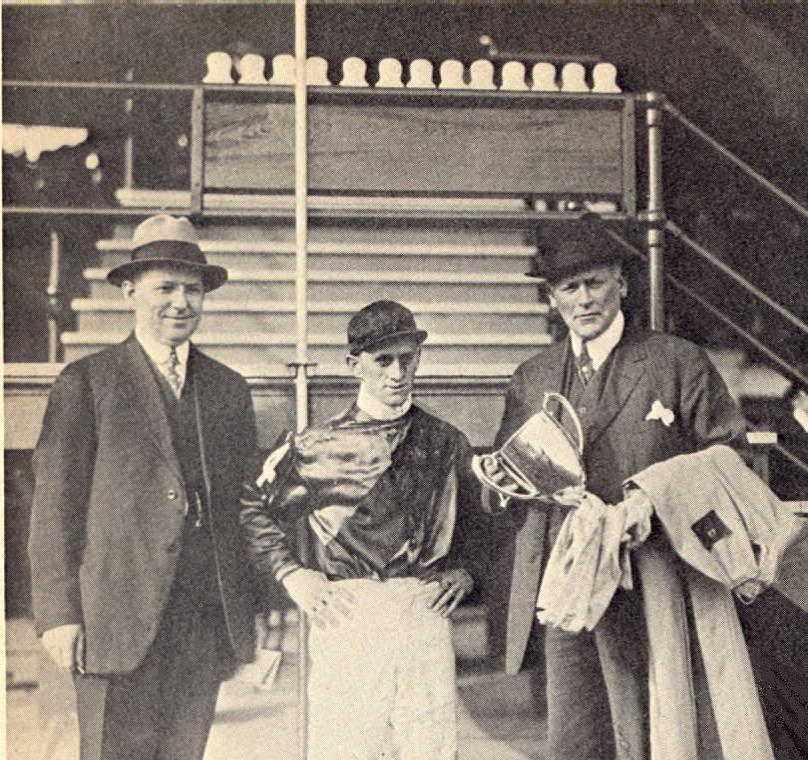
RESOLUTION
WHEREAS Roscoe Goose gained lasting fame by riding Donerail to win the Kentucky Derby of 1913 and to set
an all-time record payoff of $184.90, and ...
WHEREAS Mr. Goose graduated from the ranks of the riders to become a highly-respected trainer and owner of
Thoroughbreds, and
WHEREAS Mr. Goose, while acting as a trainer and owner, took special interest in young boys wishing to learn the riding
profession, even taking them into his home and clothing them and feeding them, and produced such notable riders as
Charles Kurtsinger and Eugene James, who rode winners of the Kentucky Derby, and ... Gilbert Elston,
WHEREAS Mr. Goose has for more than 20 years served as an unofficial host to visiting turfwriters covering the Kentucky
Derby, has given unsparingly of his time to provide information and help of all kinds to these writers, especially the
new and uninitiated, and in all these years has shown himself to be a thorough gentleman and an example of all that's
good in racing: be it
RESOLVED, That the National Turfwriters Association recommend to the National Jockeys Hall of Fame, the early election
to that honored group of Mr. Roscoe Goose.
(Passed unanimously by the National Turfwriters Association in annual meeting at Churchill Downs, Wednesday, May 1,
1968).
Roscoe rode his first meet at Churchill in the spring of 1908, and his last in the spring of 1917. After retiring from
riding in 1918, Roscoe became a successful trainer. In 1939 and 1940, he won stakes races with the horses: Kings
Blue, Lightspur and Blue Delight. He also was active in helping up and coming jockeys, one of which was
Charley Kurtsinger who rode 1937 Triple Crown winner War Admiral.

William Goose (Ganz)
Father of Sgt. Rufus Goose (Civil War), and grandfather Roscoe and Carl Goose and their less famous brothers. For a
detailed history of the surnames:(from) Ganz to Goose click here.


Hardin County, Kentucky
Named in honor of Col. John Hardin
HARDIN COUNTY: 1792 (15th county) chartered 1792 at the 15th county of Kentucky. "Hardin is the fourth largest county
in Kentucky with an area of 616 square miles. It was established completely from a section of Nelson [County]
in 1792, and named for Col. John Hardin-[Revolutionary War Col.], who was a participant in
many campaigns against Indians on the frontier. While on a peace mission with the Indians, he was treacherously
murdered by them near the present site of Defiance, Ohio.
Fort Knox was designated a permanent post in 1932; much of its 110,300 acres, lies in Hardin County. It
is also home of the Patton Military Museum.
Often considered the crossroads of Kentucky, Elizabethtown, the county seat, is laid out in a wheel
pattern, with the courthouse as the hub. Among the pioneer settlers was Andrew Hynes; the town was named for Elizabeth
Hynes, Andrew's wife. North of Elizabethtown stands a mansion which was the home of John LaRue Helm; twice
governor of Kentucky, he served in the Legislature 11 years (6 as presiding officer), and was one of the organizers
as well as first president of the L & N Railroad. Son of Honorable John LaRue
Helm-(18th & 24th Governor of KY), Ben Hardin Helm, was President Lincoln's brother-in-law. He was a
Confederate General; killed in action at Chickamauga."
Written by Robert A. Powell Kentucky Counties, page 28; 1989.

Col. John Hardin-(Revolutionary War Col.)
Col. John Hardin was Revolutionary War veteran. He also was a participant in many campaigns against Indians on the
frontier. While on a peace mission with the Indians, he was treacherously murdered by them near the present site of
Defiance, Ohio. Col. Hardin was one of the prominent slave owners at the time. There was division between
those in the family at the time who believed in slavery and those against it. His famous brother was Capt. William B. Hardin-(Revolutionary War Capt.).

Captain William B. Hardin-(Revolutionary War Capt.)
Capt. William B. Hardin-(1747-1821), was the brother of Col. John Hardin-(Revolutionary War
Col.) and grandson of Martin Hardin, a Huguenot colonist who came to Virginia from Canada and later
resettled in Pennsylvania. The 5th class city, Hardinsburg, Kentucky was named in honor of him.

Hardin Courthouse
Elizabethtown (Hardin): e/lihz/e/beth/town (Elizabethtown, Cecilia). This 4th class industrial city and
seat of Hardin County, KY. is at the junction of the Bluegrass and Western Kentucky
Parkways, I-65, and US 62, 36 miles south of downtown Louisville. In 1793, at what was first called Severns Valley
Station (for John Severns, a surveyor from Fort Harrod, Col. Andrew Hynes had 30 acres of his land surveyed and laid
out for the new county's seat. He named it Elizabethtown for his wife (nee Warford, from Maryland). This name first
appears in the Hardin County court records in May 1795 and by this name the town was officially established in 1797.
The post office may have begun operation as Hardin Court House or Elizabethtown in January 1804 with George
Helm, postmaster. The city is now generally called Etown. 568, 1420. Written by Robert M. Rennick:
Kentucky Place Names, 1987.


Hardinsburg, Kentucky
Hardinsburg (Breckinridge): hahr/dihnz/bergh
(Hardinsburg). This 5th class city and seat of Breckinridge County lies at the junction of US 60 and KY 259 and 261,
48 miles sw of downtown Louisville. It is on the site of the first settlement in the county, the pioneer Hardin's
Station, which was established by Captain William Hardin-(Revolutionary War Capt.)
(1747-1821) in 1780. Captain Hardin was the grandson of Martin Hardin, a Huguenot colonist who came to Virginia from
Canada and later resettled in Pennsylvania, and the brother of Col. John Hardin-(Revolutionary
War Col.), another Indian fighter, for whom Hardin County was named. Hardinsburg was laid out as a town, named
for William, and incorporated in 1800, the year after the formation of the county. Its post office was established on
1 January 1803, as Breckinridge Court House or Hardinburg (sic). 214, 898. Written by Robert M. Rennick:
Kentucky Place Names, 1987.

Hardinsburg Station, Kentucky
Hardinsburg Railroad Station (Breckinridge): (See Harned)(hahrn/ed)(Hardinsburg, Kingswood). This village with
post office is on US 60, 1.5 miles se of Hardinsburg. The site is believed to have been settled by Mose Payne before
1800 and first called Hardinsburg Station. A post office called Layman, for a local family, was established on 6 June
1890, by Capt. William B. Hardin-(Revolutionary War Capt.), but 6 months later it was
renamed for Henry Harned, a Virginian who had moved to this place from nearby Custer shortly after the Civil War, and
who donated the site of the depot and right-of-way to the Louisville, Hardinsburg & Western
Railroad (later Louisville, Henderson & St. Louis) Railroad in 1890. 214, 290, 1398. Written by Robert M.
Rennick: Kentucky Place Names, 1987.


Hart County, Kentucky
Named in honor of Captain Nathaniel G. T. Hart
"HART: 1819 (61st) Hart County was formed from Green and Hardin in the cavernous limestone portion of the Pennyroyal
Region. It is bordered by Metcalfe, Green, Barren, Edmonson, Grayson, Hardin and LaRue, and embraces an area of 425 square
miles. The county was named for Captain Nathaniel G. T. Hart, a brother-in-law of Henry Clay. Hart was the leader of a volunteer company of
soldiers called the Lexington Light Infantry. Before the entry of United States into the War of 1812, Hart practiced
law in Lexington and was a successful merchant. He was massacred by Indians at the Battle of River Raisin.
Munfordville, the county seat, was named for Richard I. Munford, a legislator and donor of the land on which the courthouse stands. Until a
few years ago, Munfordville had two attractive, well preserved and historic log structures; the old Munford Inn (1810) and
Glen Lilly (1819), the home of General Simon Boliver Buckner, and patriot governor, Civil War hero, and Vice Presidential
candidate (1896). Old Munford Inn was built and operated by Thomas Munford, a brother of the founder of Munfordville. It accommodated
Andrew Jackson, on the way to his inauguration as President." Source: Written by Robert A. Powell Kentucky Counties, page
29; 1989.

Honorable John LaRue Helm-(18th & 24th Governor of KY)
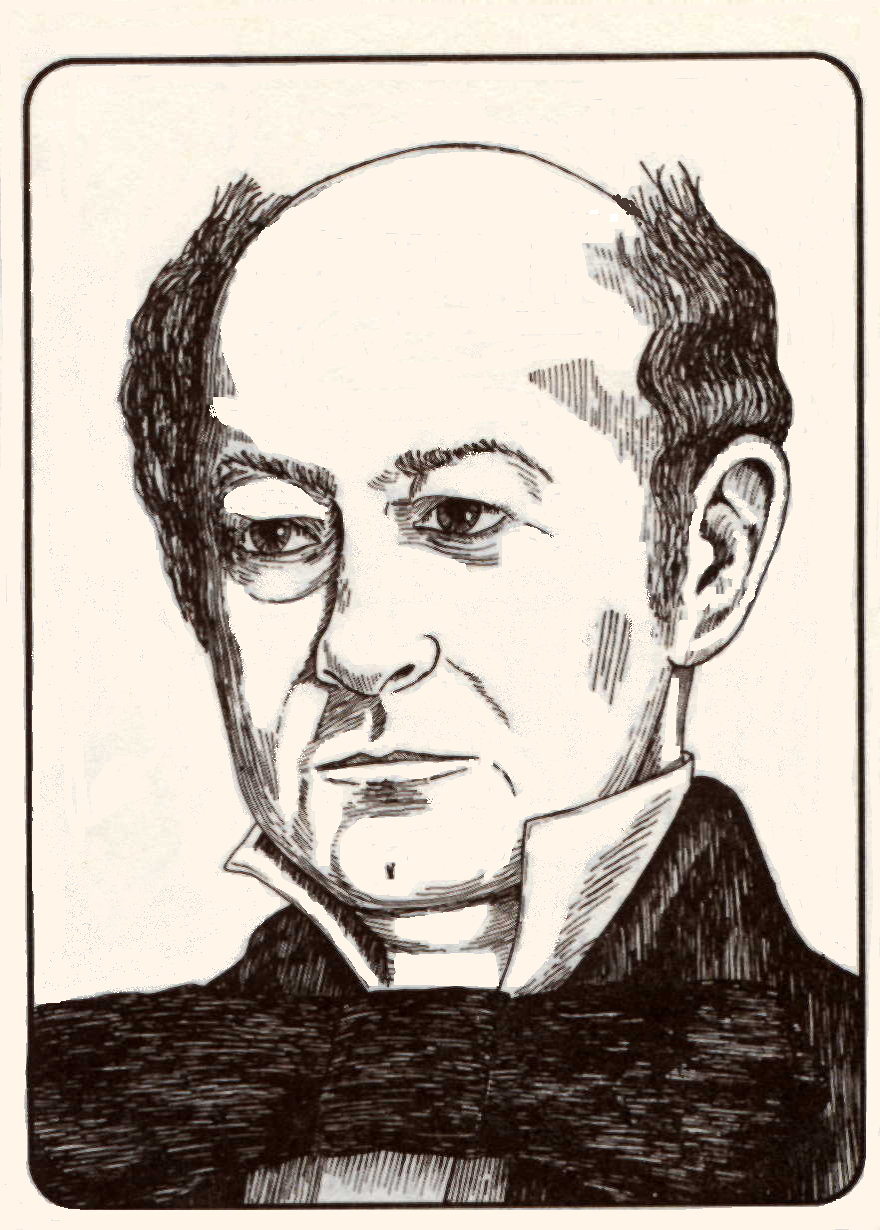
Honorable John LaRue Helm-(18th & 24th Governor of KY)
31 July 1850 - 2 September 1851 (18th Gubernatorial term)
3 September 1867 - 8 September 1867 (24th Gubernatorial
term)
born 4 July 1802 - died 8 September 1867
Democrat

Though he was governor of Kentucky twice, Helm did not fill out a full term in office, in fact, he did not even assume
the office duties for his second term. He was born near Elizabethtown, on the old Helm Place, founded by his
grandfather, Thomas Helm, an emigrant to Kentucky from Virginia. He was the son of George & Rebecca LaRue Helm. During
his teens, he worked in the office of the clerk of the circuit court and began reading law. In 1818 Helm began the
study of law under Samuel Haycraft. He then established a practice which grew rapidly, and he soon paid off his
father's debts and secured for himself the old "Helm Place," which was thereafter his home. At the age of 22 he
was appointed county attorney for the newly created Meade County. In 1825 he entered politics, and the next year was
elected to the state legislature. In 1828 he was re-elected, serving for 11 years with only a couple of interruptions.
He rose to a position of leadership in state politics and was elected Speaker of the House in 1835, 1836, 1842,
and 1843. In 1830 he married Lucinda Barbour Hardin, daughter of noted frontier lawyer Ben Hardin. Upholding the
family tradition, John and Lucinda reared 12 children. In the exciting presidential year of 1848,
John J. Crittenden-(17th Gov of KY) returned to Kentucky to add impetus to the Whig party.
Helm was selected as his running mate and defeated John P. Martin for Lt. governor. On 31 July 1850 Helm became
governor when John J. Crittenden-(17th Gov of KY) resigned to enter President Fillmore's
cabinet. Helm proved himself a strong governor throughout the rest of the term. From 1854 to 1860 he was president of
the prestigious L & N Railroad. In 1860 Helm openly denounced the election of Lincoln and in 1861 was chairman
of the meeting which declared neutrality for Kentucky. He was classed a Southern Sympathizer, and hoped that
Kentucky would eventually join the South. One of his sons, Ben Hardin Helm, a Confederate general, was
killed at Chickamauga. When the war ended Helm re-entered politics as a Democrat. He was elected to the state
Senate, and led a successful fight to remove all restrictive & punitive laws against ex-Confederates.
He was a candidate for governor in the election of 1867, when nearly every local, state, and federal office went
Democrat. He was elected by a clear majority of 43,000 over two opponents; however, Helm took the oath of office at his
home on 3 September 1867 and died five days later. He is buried in the family cemetery.
Source reference Kentucky Governors by Robert A. Powell, published and distributed by Kentucky
Images, 527 South Upper Street Lexington, KY 40508-2993; Published 1989.

Chief Judge Harry Innes (Chief Judge of the U.S. District Court of Kentucky)

"INNES, HARRY. Harry Innes, the first federal judge for Kentucky, was born Caroline County, Virginia, on 4 January
1752, to Robert Innes, a Scottish clergyman, and Catherine (Richards) Innes. Educated at Donal Robertson's school and
at William and Mary College, he read law under George Wythe and was admited to the bar in 1773. After practicing law in
Bedford County, Innes began his public career in 1776 by administering lead and powder mines in western Virginia for the
Virginia Committee of Public Safety. In 1779 Gov. Thomas Jefferson appointed him to adjust and settle land claims in
the Montgomery and Washington districts. The following year, he became esheator and later the tax commissioner. In
1782 Innes was appointed assistant judge of the newly established supreme court for the Kentucky District, and he moved
to Kentucky in 1783. When Indians killed the court's attorney in 1784, Innes resigned his judgeship to fill the
vacancy.
Innes, like many other Kentuckians, speculated in land. He also farmed, practiced law, and in time reared six daughters
(four by his first marriage, to Elizabeth Calloway of Bedford County, who died in 1791, and a daughter and a
stepdaughter by his second marriage, to the widowed Ann Shields). He became a trustee of Transylvania University, a
charter member of the political Club of Danville, and was involved in a variety of manufacturing ventures. He
spearheaded the improvement of the Wilderness Road, and Secretary of War Henry Knox appointed Innes to organize
Kentucky's defense against Indian attacks. Innes joined the movement for immediate, unconditional separation from
Virginia, and was a member of at least eight of the conventions held before statehood was achieved in 1792, as well as
both of the first two constitutional conventions.

Three years before statehood, Innes was appointed first judge of the U.S. Court for the District of Kentucky. The court
had juridiction over both circuit and district proceedings and during the twenty-seven years of Innes's tenure docketed
2,290 cases, about one-third dealing with land controversies, one-third with other civil cases, and one-third arising
from the whisky tax. Innes demanded strict adherence to the English legal traditions familiar to him, including the
rhetoric of classical pleadings. In the few cases that were carried to the U.S. Supreme Court, Innes's decisions were
usually upheld--except when litigants or their lawyers were members of the Marshall family. [The Marshall family is
related to the Innes family--this is not enumerated in this encyclopedia].
Until 1795, when the Treaty of Greenville brought relief from Indian warfare and the Treaty of San Lorenzo brought free
navigation of the Mississippi, the internal revenue statutes were unenforceable in Innes's court. Grand juries refused
to indict and petit juries refused to convict farmer-distillers on criminal charges. It was only when federal attorney
Joseph Hamilton Daveiss [another cousin of mine] brought civil charges (for debt) and Jefferson became president,
promising to repeal whiskey tax, that Kentuckians complied fully.
During the era of the Federalist Judiciary Act (1801-1802), the district court was abolished and its caseload
transferred to the new 6th Circuit Court, whose principal judge was William McClung, with District Judges Innes and John
McNairy of Tennessee as subordinates. The Jeffersonian Judiciary Act of 1802 reestablished the district court, and
Innes was again the sole judge. In 1807, the court's circuit court caseload was transferred to the 7th Circuit Court.
Innes served on that court for its Kentucky cases with Supreme Court Justice Thomas Todd, his younger cousin and
protégé, and continued as judge of the district court until his
death.
Innes, a Jeffersonian, was often involved in controversies with members and associates of the Marshall family, who were
Federalists. Although he worked fairly amicably with Daveiss (who was married to Nancy Marshall) until Daveiss's public
frustration in the BURR CONSPIRACY lead to his dismissal, it was Innes's quarrels with Humphrey Marshall [another cousin
of mine] that enlivened the pages of local newspapers. Marshall believed that Innes participated in the Spanish
Conspiracy, and Innes believed that Marshall was guilty of fraud in the land case. Both tried to get the other
impeached, but neither was successful. Innes won a libel suit against the Federalist Western World but another
libel suit against Marshall resulted in a hung jury.
Mutual friends arranged a truce a few months before Innes's death, which Marshall violated in the second edition of his
History of Kentucky. Innes died 20 September 1816, and was buried in the Frankfort Cemetery.
See Harry Innes Papers, Filson Club, Louisville, KY; Mary K. Bonsteel Tachau, Federal Courts in the early
Republic: Kentucky 1789-1816 (Princeton, N.J., 1978). Mary K. Bonsteel Tachau."
Written by Mary K. Bonsteel Tachau for The Kentucky Encyclopedia, page 452-453; 1992.

Innes's Station (Franklin County, Kentucky)
"INNES'S STATION. Henry (or Harry Innes established his station in 1792 on 1,200 acres in Franklin County, about five
miles northeast of what is now Frankfort, Kentucky. The sturdily built oak log house, on a stone foundation, was one
and a half stories in height and possibly built with a dog-trot or a breezeway; these were usually enclosed to form a
central hallway between two rooms. There were portholes in the walls of the second-story loft for shooting at
attackers. Innes later added a stone room and basement on the east end and a frame wing on the west. The station was
attacked in the same year it was built by a party of Indians who killed one of Innes's male slaves and captured another.
Innes lived at his station until his death in 1816.
See George A. Lewis, "A Relic of Indian Days, Register 19 (January 1921): 29-31.
Written by George A. Lewis for The Kentucky Encyclopedia, page 453; 1992.


LaRue County, Kentucky
"LaRue County is best known as the birthplace of Abraham Lincoln, although the actual site was at the time a part
of Hardin County, Kentucky. Four counties are adjacent to LaRue; Nelson,
Taylor, Green, and Hart. Created from Hardin County, Kentucky, LaRue has an
area of 260 square miles.
The county was named for John P. LaRue, a Virginian who brought a colony of settlers to
Phillips Fort and purchased the place. LaRue's brother-in-law was Robert Hodgen, who built a tavern and
gristmill there in 1789. Hodgenville was created in 1818 by an order of the Hardin
County, Court, and was named for Hodgen. In 1843 Hodgenville became the county seat. The Lincoln
Birthplace Shrine, three miles south of Hodgenville, includes 116 acres of the original Thomas Lincoln farm
where Abe was born and lived when he was very young. The birthplace cabin is located in a magnificent marble and
granite memorial building. It was dedicated in 1909, on the 100th anniversary of Lincoln's birth, and there are 56
steps leading to the memorial; one for each year of Lincoln's life.
An impressive statue of Lincoln stands on the public square in Hodgenville, but the oldest landmark in the county
is a stone springhouse east of Hodgenville, which was built in 1775."
Source: Written by Robert A. Powell Kentucky Counties, page 34; 1989.
LARUE COUNTY. The ninety-eight county in order of formation, LaRue County is located in central Kentucky. The
county is bordered by Green, Hardin, Hart, Nelson, and Taylor counties and has an
area of 263 square miles. LaRue County was formed on 4 March 1843, from a portion of Hardin
County and was named in honor of John P. LaRue, an early settler. The seat of LaRue County
is Hodgenville.
The topography of LaRue County is rolling to hilly. The Muldraugh Escarpment is the most dominant geographical
feature of the county. The principal streams in LaRue County are the Nolin River and the Rolling Fork of the
Salt River. Among the numerous creeks, Otter Creek is one of the largest. The land is also marked by a number of
large sinkholes formed by the collapse of underlying caves.
Burial mounds in LaRue County attest to the occupation of prehistoric Native American tribes. The first white settlers
came into the region in the early 1780s. Originally surveyed by Benjamin Lynn in 1778, the first permanent white
settlement was established by Phillip Phillips in 1781. Called Phillips' Fort , this site was located 1 1/4 miles from
what is now Hodgenville.
One of the pioneer families of LaRue County was that of Thomas Lincoln, who settled on the Sinking Springs farm
in LaRue County. It was there that Abraham Lincoln was born on 12 February 1809. During the Civil War, the Confederate
army under the command of General Braxton Bragg marched through LaRue County in 1862 on its way north to Louisville.
LaRue County, largely agrarian, had a small industrial base by the twentieth century, manufacturing lumber products,
clothing, and concrete. Tobacco, wheat, corn, and vegetables such as sweet peppers are staple crops. Cattle and hogs
are also raised. The industrial potential of the county was enhanced in 1938 with the creation of the Nolin Rural
Electric Cooperative Corporation, which supplied electricity to all reaches of LaRue County. A significant industrial
competitor is the city of Elizabethtown in adjacent Hardin County, at the junction
of I-65, the Bluegrass Parkway, and the Western Kentucky Parkway. LaRue is served only by U.S. 31E.
The population of LaRue County was 10,672 in 1970; 11,922 in 1980; and 11,679 in 1990.
See Bessie Miller Elliott, History of LaRue County (Hodgenville, Ky., 1967). Written by Bon
D. Bryant for The Kentucky Encyclopedia, page 536; 1992.

John P. LaRue-(Revolutionary War Soldier)
"LARUE, JOHN P. John P. LaRue, a prominent landowner in what is now Kentucky, was born in Frederick County,
Virginia, on 24 January 1746, to Isaac and Phebe (Carman LaRue. He owned land in Spottsylvania County, Virginia, and he
took part in the Revolutionary War.
In 1779 he and his brother Samuel built a cabin on Guist Creek, a branch of Brashers Creek, a fork of the Salt River,
about five or six miles from Squire Boone's Station in present-day Shelby County, Kentucky. In
1783 John married Mary Brooks in Virginia and returned to Kentucky with his wife the following year. They settled at
Nolin Station, at the mouth of Beech Fork, a tributary of Rolling Fork of the Salt River, about fifty miles from the
Falls of the Ohio. Through his acquaintance with Squire Boone, a prominent surveyor in Kentucky, LaRue gained title to
large tracts of land in Shelby County, Kentucky and throughout the region, eventually laying
claim to 40,000 acres. He died 4 January 1792, at his home on a branch of the Nolin River above Hodgenville.
In 1843, the state legislature established LaRue County, the name chosen by Honorable John LaRue Helm-(18th & 24th Governor of KY), Speaker of the House and
later governor (1850-1851, 1867), in honor of his maternal grandfather.
"
Source: "See Otis M. Mather, Six Generations of LaRues and Allied Families (Hodgenville, KY.,
1921)."The Kentucky Encyclopedia, page 536; 1992.

First Lady Mary Todd Lincoln

Mary Todd Lincoln House
On 13 December 1818, Eliza Parker Todd, wife of Robert Smith Todd of Lexington, Kentucky, gave birth to a
daughter, Mary Ann Todd. She was the fourth of what was to be sixteen Todd children.
Mr. Todd who received a degree in law at Transylvania University was a leading member of the Whig party
and very active in the politics of the day. He was friends with Henry Clay who often came to the Todd
home to discuss his presidential campaigns. Young Mary Todd admired Mr. Clay and said she would love to
visit him some day in the White House. Mary's father encouraged her to sit in on the political meetings
that took place in her home, to have an opinion and be able to back it up. Mary would often visit Mr.
Clay at his home, Ashland.
Mary loved to learn and read. She had 12 years of formal education which was very unusual for that time
for a young lady. Most men did not have that much formal education. This love of learning and politics
was the basis of the beginning of a friendship between her and a young member of the Whig party in
Springfield, Illinois. Mary Todd was most impressed by the speeches of Mr. Abraham Lincoln. The two would
have long conversations about Henry Clay and about books and poetry they had read. Eventually, much to
the chagrin of her family, the friendship grew stronger. Mary Todd married Abraham Lincoln in November,
1842.
As a young lawyer in Springfield, Abraham Lincoln would travel with the circuit court which would cause
him to be in remote areas for extended periods. Mary would hold down the home front in his absence and
keep up with all the latest political news by reading the newspapers and newest books. Mr. Lincoln often
commented that he had no need to read a book after Mary reviewed it for him.
Abraham Lincoln was not always a popular and successful candidate. Many times he became discouraged by
defeat but always Mary, his best supporter, was there to encourage him. She knew that he would be able to
make a difference in Washington. In 1847 Mr. and Mrs. Lincoln and their two sons stopped to visit
Lexington on their way to Washington, DC., where Mr. Lincoln would be in the House of Representatives.
During this visit Abraham Lincoln witnessed first hand some of the slave auctions that were held in the
center of town.
During the difficult times of the Civil War while Mr. Lincoln was president Mary made it her job to see
that he took care of himself. She would prepare his favorite food and arrange to have interesting
visitors at their meals to help take his mind off the war at least for awhile. Finally when the war ended
on 10 April 1865 Mary was looking forward to being able to enjoy a normal life with her husband. On 14
April, just four days later that dream ended with a shot from the gun of John Wilkes Booth.
Mary Lincoln knew much sorrow in her life. As her husband's fame grew, the attention to every detail of
their lives grew. During the Civil War, some of the Todd family supported the Confederacy, yet Mary was
the First Lady of the United States. She lost family members to the war and over the years lost three
sons to illness. Mary Lincoln lived for seventeen years after the assassination. She remained in
mourning that entire time, wearing black every day. She died in July 1882, just before her 64th birthday.
She is buried in Springfield, Illinois, with her husband and three of her children, Eddie, Willie and
Tad.


Logan County, KY.
"LOGAN COUNTY: loh/ghen. 556 square miles. Population (as of printing of book, 1987) 24,059. Seat:
Russellville. This county was established in 1792 from part of Lincoln County and named for General Benjamin Logan (Revolutionary Army) (1743-1802), pioneer, Indian fighter, delegate to
the several Danville conventions to arrange Kentucky's separation from Virginia and, later, to draft Kentucky's first
constitution, and twice an unsuccessful candidate for governor. The county, then comprising all of Kentucky south of
the Green River, was one of the 7 organized in the new state's first legislative session. It included all of 23 and
part of 6 counties subsequently created." Source: Written by Robert M. Rennick: Kentucky Place Names, 1987.
"LOGAN COUNTY: 1792 (13th County) Logan County is bordered by Muhlenberg, Butler, Warren, Simpson
and Todd Counties. It was taken from Lincoln County 1792, and covers 563 square
miles. The county was named for General Benjamin Logan (Revolutionary Army), a pioneer
hero, who the general masses wanted to be the second governor. He was an influential figure in bringing about
Kentucky's independence.
Russellville, Logan's county seat, was settled in 1795. It was the site of Confederate Sovereignty
Convention, to admit Kentucky as the 13th state of the Confederate States of America, 1861. It was one of
the state's largest as well as most prosperous cities for most of the 19th century.
West of Russellville is the site of a log structure built in 1792 which served as the seat of justice for all of
the Western Kentucky from 1793-1798. Logan County possesses one of Kentucky's two Shaker communities.
South Union near Auburn, was founded by the Shakers around 1807. Many of the buildings are
restored.
Among Logan County's native sons are four Kentucky governors, five governors of other states, a
supreme Court Judge to Mississippi and a number of U.S. Army officers." Source: Written
by Robert A. Powell Kentucky Counties, page 38-39; 1989.
Logan's Company of Kentucky County
Militia

Logan Courthouse (Russellville), Logan County, KY.
Russellville (Logan County, KY): ruhs/el/vihl, ruhs/el/vel (Russellville. This 4th class industrial city and
seat of Logan County, Kentucky is on US 68, 79, and 431, 105 miles wsw of downtown
Louisville. The date of its first settlement has been disputed. According to Logan Countie's noted historian, Alex C.
Finley (in 1879), the first house on the site was built by Gasper Butcher around 1780. W.R. Jillson has questioned
this, finding no record evidence of a house there until Cook's Cabin or Station was built in 1790. It has been said
that the name Big Boiling Spring was early applied to the place, for a spring that boiled up out of the ground, along
with Gasper Butcher's Spring or Station until 1792 when, with the formation of the county, it became known as Logan
Court House. Actually the first courthouse and community were 1 mile east of the present courthouse site. The
town that was laid off in 1795 and named for General William Russell centered in 1798 on the 2nd courthouse located on
Russell's 2000-acre Revolutionary War military grant. Russell, (1735-1793), the son of English immigrants, was a
veteran of both French and Indian and Revolutionary War campaigns. The Russellville post office was established on 1
April 1801, with Armestead Morehead, postmaster, but the town was not incorporated by legislative act until 13 January
1810. 42, 109, 206, 1344. Written by Robert M. Rennick: Kentucky Place Names, 1987.
Logan's Company of Kentucky County Militia

General Benjamin Logan Fort (Revolutionary War Time)

Look to the bottom, center of the map to see the fort written in red.


Logansport P.O. (& Logansport), Butler County, KY.
Logansport (Butler): toh/ghenz/pawrt (Cromwell). The hamlet with Morgantown branch post office is in the
Big Bend of the Green River, now on KY 403, 1/2 mile west of the river and 5 1/2 miles northwest of Morgantown. Early
in the 1900s it was located about 1 1/4 miles southeast (Logansport P.O.), and in the 19th century was, as the name
suggests, a port on the Green River. As such it was first called Carson's Landing for Thomas C. Carson, its owner.
According to tradition, the winter of 1852 was exceptionally cold and the river froze over. The steamboat
Captain (some say General) Benjamin Logan was trapped for 2 months in
ice some 18 inches thick. "When the spring thaws came, the boat was crushed by the impact of the ice and sank." The
post office, established 5 May 1854, with Carson as postmaster, was named for the boat whose smokestack was visible for
years. 578, 1019. Written by Robert M. Rennick: Kentucky Place Names, 1987.

Steamer Logan (1853)
The steamer Logan was named for General Benjamin Logan
(Revolutionary Army) and so were both towns. The description of "Logansport" failed to explain that once river
traffic dissipated and railroads took over, the city moved up onto the ridge. As bridges crossed the rivers, ferryboats
also lacked any purpose or ability to support themselves. In 1997, the completion of restoration of the 1800s Post
Office and Mansion was accomplished. These two buildings are like a trip back into time. They are absolutely
beautiful. The location of the landing is still obvious, especially because of the location of the two buildings and
only the forth family in 200+ years to live on the property lives there. The oral history has been handed down.
Steamer Logan (1853)
"Sternwheel packet wooden hull built in Louisville, KY., 1853, 150 tons. Off the lists 1853." Source: "Way's Packet
Directory, 1848-1994." Compiled by Captain Frederick Way, Jr.
This vessel was crushed at the wharf of Logansport P.O. (& Logansport), Butler County,
KY. For many years after the vessel submerged or became a "seminaufragium," (vessel whose cost to replace is
greater than its value), was visible from the shore.


Logan's Crossroads (Nancy), Pulaski County, KY.
Nancy (Pulaski): naen/see (Delmer, Faubush). This village with post office extends west for over 1 mile
along KY 80, 5 1/2 miles west of Somerset. It was first called Logan's Crossroads for the family of William
Harrison Logan (1811-1884). The post office was first established as Lincolnville for the late president on 27 June
1865, with William Harrison Logan as postmaster. It was discontinued in 1875 and reestablished on 4 September 1884, as
Nancy for Logan's wife, NANCY LESTER LOGAN (1834-1890), the daughter of Vincent Lester. 978, 1410. Written by
Robert M. Rennick: Kentucky Place Names, 1987.

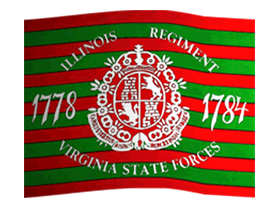
General Benjamin Logan (Revolutionary Army)

General Benjamin Logan (1743-1802) was a revolutionary Army general. He had
many famous and influential descendants:
Julia Tevis (Wickliffe) Beckham
who was his great granddaughter.
Honorable John Crepps Wickliffe Beckham-(35th Gov of KY) who was his great-great grandson.
Honorable Charles Anderson Wickliffe-(14th Gov of KY) who was his grandson.
Col. Charles Anderson Wickliffe-(Confederate Col.) who was his great grandson.
Honorable Robert C. Wickliffe-(Governor of Louisiana) (RW-Gov) who was his great-grandson.
Honorable Robert C. Wickliffe-(Attorney & Legislator) (RW-uncle)who was his grandson.
Honorable Aaron K. Wooley-(Kentucky state Representative and Senator)who was a cousin.
Honorable Robert Wickliffe Wooley-(Diplomat and soldier-Lt. Col. in CSA.) who was a cousin.
Honorable William Preston-(Major General CSA/Lt. Col in KY Volunteers; U.S. Congressman & Ambassador
to Spain)
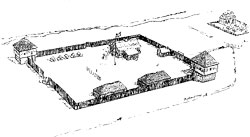
Logan's Company of Kentucky County
Militia
Kellar's Company of Illinois Regiment of the
Virginia State Line: Portraying the American Revolution 1779-1783

Benjamin Logan arrived in Kentucky Co. Virginia in 1775 where he established Logan's Fort. It was one of the first
three settlements. In March 1776 Logan moved his family to St. Asaph's which was the town at Fort Logan. Logan was
appointed Sheriff of Fincastle Co. and was also commissioned a Captain in the County Militia.
In 1777 Logan's Company defended against many attacks of Indians. Logan's Fort sustained the longest siege of any that
year. Some of the men under Logan's command went to fight with George Rogers Clark. In 1779 Logan and his men went
with Col. Bowman to attack the Indian town of Chillicothe. Though the raid was not successful, they did get horses and
his men were paid in plunder. Logan was also in command of the Lincoln county militia at the battle of Picaway, under
General George Rogers Clark in August of 1780.
The time period we have chosen is March 1777. This not only represents the establishment of Kentucky Co. but also the
first militia muster of said county. Indian attacks also increased at this time. The men of Logan's Co. wore garments
of the civilian frontier - moccasins or shoes, breeches, trousers, breechclout, leggings, hunting shirts, neck stock,
neckerchief and a round or tri-cornered hat. They wore waistcoats, shirts and breeches when they had them.

Louisville, Hardinsburg & Western Railroad
Louisville, Hardinsburg & Western Railroad (later Louisville, Henderson & St. Louis Railroad) had a station at the city
of Hardinsburg, Kentucky. Hardinsburg Station Mr. Henry Harned donated the site of
the depot and right-of-way to the Louisville, Hardinsburg & Western (later Louisville, Henderson & St. Louis) Railroad
in 1890. Written by Robert M. Rennick: Kentucky Place Names, 1987.

Malcolm III, King of Scotland
Wessex Leadership Tree from 802-1066 A.D.
Malcolm III's child married the child of the King of England Ethelred "the unready"'s child.
24 generations later was William Goose (Ganz)26 generations later was Carl Goose (Ganz) and
Roscoe Goose
Malcolm's wife was Maragaret of Scotland (St. Margaret). She was the saintly queen, and she was a reconciler and a reformer, a scholar, and an embroideress, a wife, and a mother. In her, the line of the old Saxon kings of England was linked with the new dynasty of the Norman kings. We know about her because her biographer, Turgot, wrote a lyrical account of her life. She stands at a key point in history and is pivotal to the unraveling of its meaning.

Margaret of Scotland (St. Margaret), Queen of Scotland
Wessex Leadership Tree from 802-1066 A.D.
Malcolm's wife was Maragaret of Scotland (St. Margaret). She was the saintly queen, and she was a reconciler and a reformer, a scholar, and an embroideress, a wife, and a mother. In her, the line of the old Saxon kings of England was linked with the new dynasty of the Norman kings. We know about her because her biographer, Turgot, wrote a lyrical account of her life. She stands at a key point in history and is pivotal to the unraveling of its meaning.


Martwick (City of), Muhlenberg County, Kentucky
"Martwick (Muhlenberg): mahrt/wihk (Central City). The coal town with branch post office is on KY 1381,
just north of the Illinois Central Gulf RR, U.S. 62, and the Western Kentucky Parkway, and 10 miles northeast of
Greenville. It grew up around the Martwick Mine, opened in 1910 by Greenville coal operators Charles M. Martin and
Judge William A. Wickliffe, for whom it was named. The post office was
established on 15 March 1912, with Arthur C.
Howard, postmaster. 773, 1253." Written by Robert M. Rennick: Kentucky Place Names, 1987.
During the 1970's, the coal company cut off the spring and closed down the town. Nothing left as of 19 July 1994.

Dr. Ephraim McDowell (Surgeon)
died on 25 June 1830.
A distant cousin of mine, Ephraim McDowell [performed the first operation in American on his/my other distant cousin,
Jane (Todd) Crawford][she is also a cousin of Mary Todd Lincoln]. McDowell "was a physician and surgeon who introduced
pioneering techniques in abdominal surgery, was born on 11 November, 1881, in Augusta (later Rockbridge) County,
Virginia. He was the ninth of eleven children of Samuel and Mary (McClung) McDowell. His family moved to Danville,
Kentucky, in 1784. Schooled in Georgetown and Bardstown, McDowell studied medicine with Alexander Humphreys of Staunton,
Virginia, attended a course of lectures at the University of Edinburgh School of Medicine, and studied anatomy and
surgery with John Bell.
McDowell returned to Danville in 1795 and built a busy practice, earning a regional reputation as a skillful anatomist
and surgeon, widely consulted by other practitioners. McDowell did not keep notes on his cases, however, and published
only two articles, both of them in an obscure journal, the Eclectic Repertory and Analytical Review.
Recognition of the significance of his work came slowly and only decades after he performed the first successful
ovariotomy, on Christmas Day 1809. the forty-seven-year-old patient, Jane (Todd) Crawford, who had been thought to be
pregnant with twins, was in fact suffering from a large cystic ovarian tumor that weighed more than twenty pounds.
In a letter describing the surgical procedure that would subsequently bring him international fame. McDowell said he had
warned Crawford that four of the "most eminent Surgeons in England and Scotland had uniformly declared in their Lectures
that such was the danger of Peritoneal Inflammation, that opening the abdomen to extract the tumor was inevitable death.
But notwithstanding this, if she thought herself prepared to die, I would take the lump from her if she could come to
Danville." The surgery went well and Crawford was "perfectly well in twenty-five days." McDowell performed the operation
well before the discovery of the importance of aseptic techniques or the introduction of anesthetics.
McDowell performed the procedure at least eleven additional times, with but one death. He was one of the first surgical
pathologists, carefully preserving and studying specimens removed during surgical procedures. Dr. Samuel D. Gross, a
professor of surgery in the school of medicine of the University of
Louisville during the 1840s and 1850s, publicized McDowell's accomplishments and secured for McDowell his proper
place in the annals of abdominal and gynecological surgery. McDowell was one of the founders of Centre College in
Danville, and between 1819 and 1829 served on the college's board of trustees.
On 29 December 1802, McDowell married Sarah Hart Shelby, the daughter of the first [and fifth] governor of
Kentucky, Honorable Isaac Shelby-(1st. & 5th. Gov of KY)(1792-1796 and 1812-1816).
The couple had six children, five of whom survived: Susan, Mary, Adaline, Catherine, and William Wallace.
McDowell died on 25 June 1830, and is buried in Danville."
See Laman A. Gray, Sr., "Ephraim McDowell: Father of Abdominal Surgery, Biographical Data," FCHQ 43 (July
1969); 216-29; Josephine Rich, Pioneer Surgeon (New York 1959).
Written by Allen J. Share for "The Kentucky Encyclopedia, published 1992.

Honorable James Patton Preston-(1816 - 1819 Governor of Virginia)
Graduated from the College of William and Mary, 1773.
Alumni list from the College of William and
Mary, 1773.
Preston, James Patton (1774-1853) . of Virginia. Born 21 June 1774. Brother-in-law of John Floyd; uncle
of James McDowell and John Buchanan Floyd; father of William Ballard Preston. Governor of Virginia,
1816-19. Died 4 May 1853. Burial location unknown.
More Preston details

Honorable William Preston-(Major General CSA/Lt. Col., U.S. Congressman,
Ambassador to Spain)
Major General CSA/Lt. Col in KY Volunteers; U.S. Congressman & Ambassador to Spain)
"William Preston, politician and soldier, was born near Louisville on 16 October 1816, to Major William
Preston, a Revolutionary War Veteran who acquired choice land at the Falls of the Ohio [River], and
Caroline (Hancock Preston. He received a classical education in several preparatory schools of Kentucky
and obtained a degree in literary studies from Yale College in 1835 and an LL.B. at Harvard in 1838.
After establishing a successful law practice in Louisville, he launched a political career as a Whig.
Preston participated in the Mexican War (1846-1848), achieving the rank of Lieutenant Colonel in the 4th
Kentucky Volunteers. He was a delegate to the 1849 Kentucky Constitutional Convention and served in the
Kentucky House in 1851 and the State Senate in 1852. In September 1852 he was elected to fill the vacant
U.S. Congressional seat of Democrat Humphrey Marshall. Preston advocated a pro-slavery position in the
House, where he served until he was defeated by Marshall in the 1855 election. By 1856 he had switched
allegiance to the Democratic party. He participated as a delegate to the 1856 Democratic convention,
where he supported James Buchanan and successfully nominated fellow Kentuckian John C. Breckinridge for the
Vice-Presidency. In late 1858 Preston received an appointment as U.S. Minister to Spain. He successfully
negotiated the long-standing Amistad claims with Spain, but the U.S. Senate on a sectional vote rejected
it. He tried to purchase Cuba from Spain for $30 Million and, using principles from the Monroe Doctrine,
protested Spanish intervention in Santo Domingo.
Preston resigned the ambassadorship and joined the Confederate States of America, formed in February 1861.
He rose to the rank of Major General and engaged in numerous battles, including those at Fort Donelson,
Nashville, Shiloh, Vicksburg, and Chickamauga. At Shiloh his brother-in-law, General Albert Sidney
Johnston, died in his arms. In January 1864 he was selected Confederate minister to Mexico. Frustrated by
the lack of recognition from the Mexican government, Preston resigned and joined General Edmund
Kirby-Smith's Trans-Mississippi Department in Texas in December 1864, where he served until the war ended.
At war's end he spent several months in exile in England and Canada before obtaining a federal pardon in
1866 and returning to Lexington.
Preston served a single term in the state legislature in 1868 and was a delegate to the 1880 Democratic
convention. He devoted most of his time to overseeing the large estate he had inherited from his
father-in-law. [Honorable Robert C. Wickliffe-(Attorney & Legislator)]
In 1840 Preston married Lexingtonian Margaret Wickliffe, daughter of Honorable Robert C.
Wickliffe-(Attorney & Legislator), Kentucky's largest slaveholder. They had five daughters: Mary
Owen, Caroline Hannah, Margaret, Susan C., and Jesse Freemont, and a son, Robert Wickliffe. Preston died
in Lexington on 21 September 1887, and was buried in Louisville's Cave Hill Cemetery.
See J. Frederick Dorman, "General William Preston" FCHQ 43 (Oct. 1969); 301-308; J. Frederick
Dorman, The Prestons of Smithfield and Greenfield in Virginia (Louisville 1982).
Written by Charles C. Hay III for The Kentucky Encyclopedia, page 738-739;
1992.
PRESTON, William, (1816 - 1887)
PRESTON, William, (nephew of Francis Preston), a Representative from Kentucky; born near Louisville, Ky.,
16 October 1816; pursued preparatory studies and was graduated from St. Joseph's College, Kentucky;
attended Yale College in 1835; was graduated from the law department of Harvard University in 1838; was
admitted to the bar and commenced practice in Louisville, Ky., in 1839; served as lieutenant colonel of the
Fourth Kentucky Volunteers in the war with Mexico 1846-1848; delegate to the State constitutional
convention in 1849; member of the State house of representatives in 1850; served in the State senate
1851-1853; elected as a Whig to the Thirty-second Congress to fill the vacancy caused by the resignation of
Humphrey Marshall; reelected to the Thirty-third Congress and served from 6 December 1852, to 3 March 1855;
unsuccessful candidate for reelection in 1854 to the Thirty-fourth Congress; Envoy Extraordinary and
Minister Plenipotentiary to Spain 1858-1861; during the Civil War served in the Confederate Army and
attained the rank of major general; appointed Envoy Extraordinary and Minister Plenipotentiary from the
Confederacy to Maximilian, Emperor of Mexico, in 1864; again a member of the State house of representatives
in 1868 and 1869; died in Louisville, Ky., 21 September 1887; interment in Cave Hill Cemetery.
Bibliography
Sehlinger, Peter J. Kentucky's Last Cavalier: General William Preston, 1816-1887. [Frankfort,
Ky.]: Kentucky Historical Society; Lexington: Distributed by The University Press of Kentucky, 2004.
Congressional Biography
More Preston details

Honorable William Ballard Preston-
(U.S. Congressman, Secretary of
Navy, Commonwealth of Virginia Congressman)
U.S. Congressman)
PRESTON, William Ballard, (1805 - 1862)
PRESTON, William Ballard, (nephew of Francis Preston), a Representative from Virginia; born in Smithfield,
Va., 25 November 1805; graduated from Hampden-Sydney College, Hampden-Sydney, Va., 1824; studied law and
graduated from the University of Virginia, Charlottesville; admitted to the bar and commenced practice in
1826; member of the Virginia state house of delegates, 1830-1832, 1844-1845; member of the Virginia state
senate, 1840-1844; elected as a Whig to the Thirtieth Congress (4 March 1847-3 March 1849); appointed
Secretary of the Navy in the Cabinet of President Zachary Taylor and served from 8 March 1849, to 22 July
1850; delegate to the Virginia state constitutional convention, 1861; served in the Confederate States
Congress; died in Smithfield, Va., on 16 November 1862; interment in Preston Cemetery on the former
Smithfield Plantation, Blacksburg, Va.
Congressional Biography
Biography
of The Honorable William Ballard Preston


Shelby County, Kentucky
"SHELBY: 1792 (12th) Shelby County was the third county formed after Kentucky became a state. It
was taken from Jefferson in 1792, and is also bordered by Franklin, Oldham, Henry, Anderson and Spencer. Shelby
covers an area of 384 square miles, and was named for Honorable Isaac Shelby-(1st. &
5th. Gov of KY), a hero of the American Revolution, and Kentucky's first governor. He was
called back to serve again as the fifth governor from 1812-1816. Shelby was so popular that counties in
nine states were named in his honor.
Shelbyville was founded in 1792. It is the county seat, a thriving trade center, and the
home of the Kentucky Old Mason's Home. Squire Boone's Station, or Painted Stone
Station, between Shelbyville and Eminence, was one of the first
settlements between Fort Harrod and the Falls of the Ohio.
Major Bland Ballard died in Shelby County, Kentucky in 1853. Though he
lived nearly 100 years, his longevity is more remarkable when you consider the perilous adventures he
survived. He was in the middle of most every encounter between the pioneers and Indians. He not only
lost at least five family members during the Tick Creek massacre in 1788, he single-handedly killed
six Indians to be the lone survivor."
Source: Written by Robert A. Powell
Kentucky Counties, page 56-57; 1989.
"SHELBY COUNTRY. Shelby County, the twelfth in order of formation, is located in north-central
Kentucky, bordered by Anderson, Franklin, Henry, Jefferson, Oldham, and Spencer
counties. It has an area of 385 square miles. The county was formed from a portion of Jefferson County on 23
June 1792, and was named in honor of Kentucky's first governor, Honorable Isaac
Shelby-(1st. & 5th. Gov of KY) (1792-1796, 1812-1816). The county seat SHELBYVILLE.
The topography of Shelby County is rolling and some sections are hilly. Corn, hemp, and wheat were the
primary crops before the Civil War. Shelby County was a major hemp-growing country, producing 308,200
pounds in 1870. In 1870 the county produced 239,450 pounds of tobacco and 2626 head of mules, many of
which were sold elsewhere. Tobacco, corn, hay, beef, and dairy cattle are now the principal farm
products. Shelby County is well known for its alfalfa hay, grown in deep, limestone-shale-embedded soil.
Farms in 1987 occupied 91 percent of the land area, and 71 percent of farmland was in cultivation. In
1987 the county ranked fifth in the state in agricultural receipts, 60 percent of which were derived from
livestock and poultry.
The first settlers arrived in the Shelby County area in 1779. Squire Boone founded Painted Stone and
Eminence. Other early settlers were Alexander Bryan, John Buckles, and Richard Cates. Squire Boone's
Station was abandoned in September 1781, Tyler's Station [Tylers were cousins] on Tick Creek, Bland Ballard
and his family were killed by Indians. [This history conflicts with what is written above. Bland Ballard
lived to be almost 100 years of age.] Among the early settlements were Shelbyville, Pleasureville, and
Simpsonville.
From September 1862 to January 1865, several Civil War skirmishes were fought in Shelby County. On 26
August 1864, a band of Confederate guerrillas, commanded by Captain David Martin, attacked Shelbyville.
Tourism expenditures in the county totaled $2.6 million in 1988, a 14 percent increase over the previous year.
Attractions include the Old Stone Inn, once a stagecoach tavern near Simpsonville, Science Hill Inn, and Claudia
Sanders' Dinner House, established by Col. Harlan Sanders, creator of Kentucky Fried Chicken. Thousands each June
attend the Shelby County Fair and Horse Show, whose gaited event is one of the largest in the state. Lake Shelby is a
one-hundred-acre fishing lake, and fishing, water-skiing, and camping are available on the 325-acre Guist Creek Lake. The
birthplace of Whitney M. Young, Jr., director of the National Urban League, is in Lincoln Ridge; it is listed on the
National Register of Historic Places.
The majority of the county's industry is located in Shelbyville, where twenty-seven manufacturing firms employed 2,464
in 1990. Shelby County's largest employer is Leggett and Platt, manufacturers of swivel chairs, sofa beds, and
reclining chair mechanisms in Simpsonville. Also located in Simpsonville is the F.B. Purnell Sausage Company. The
Bagdad Roller Mills, which produce livestock feed, are located in Bagdad.
The population of Shelby County was 18,999 in 1970; 23,328 in 1980; and 24, 824 in 1990.
See George L. Willis, History of Shelby County, Kentucky (Hartfort, KY., 1929); Edward D. Shinnick, Some Old
Time History of Shelbyville and Shelby County (Frankfort, Ky., 1974). by Ron D. Bryant in The Kentucky
Encyclopedia, page 816; 1992.

Honorable Isaac Shelby-(1st. & 5th. Gov of KY)

4 June 1972-1 June 1796
24 August 1812-5 September 1816
ISAAC SHELBY
Born 11 December 1750-Died 18 July 1826
Jeffersonian Republican
"Kentucky's first governorn, the man recognized as the "father" of our Commonwealth, was born in Maryland in 1750.
Isaac Shelby was a soldier, patriot, and statesman who was so admired and respected that counties in nine states are
named in his honor. This son of Evan and Leatitia Cox Shelby received a fair education and then worked on his father's
plantation. Around 1773 the Shelby family moved to the Holston region of Virginia, now eastern Tennessee. Isaac Shelby
served in his father's Fincastle Company at the Battle of Point Pleasant, 10 October 1774 distinguishing
himself by his skill and gallantry. In July 1775, he visited Kentucky and surveyed lands for the Transylvania
Company. In 1783 he moved to Kentucky, where, at Boonesborough, he was married to Susannah Hart on 19
April 1783. Isaac and Susannah had 11 children. Their eldest daughter, Sarah, married Dr. Ephraim McDowell. In 1784,
Shelby was chairman of a convention called to consider an expedition against the Indians and separation of Kentucky from
Virginia. He was also a member of the succeeding conventions which prepared the way for Independent statehood, and was
a member of the convention 2-19 April 1792, which framed the first Constitution of Kentucky. On 15 May
1792, he was elected governor, taking office on 4 June 1792 and serving four years. At the close of his term he
declined re-election and for the next 15 years gave attention to his private affairs. In 1812, Shelby was called from
retirement to become governor a second time. He was elected over Gabriel Slaughter by a vote of 29,285 to 11,936. He
cooperated vigorously in the war against Great Britain and in 1813 assembled and led in person, 4,000 Kentucky
volunteers into the Northwest for the invasion of Canada, an expedition that resulted in the defeat of the British at
the Battle of the Thames. For his patriotic and heroic services he was awarded a gold medal by Congress.
In 1817, President Monroe asked him to accept the post of Secretary of War; he declined because of his age. The next
year he and General Andrew Jackson were sent to make a treaty with the Chickasaw Indians for the purchase of their lands
west of the Tennessee River. Part of this land became the "Purchase" area of far western Kentucky. Shelby was
chairman of the first board of trustees of Centre (pronounced "Center") College, founded in 1819. Isaac Shelby was
buried at his home, "Traveller's Rest," south of Danville, and a monument was erected."
Source reference Kentucky Governors by Robert A. Powell, published and distributed by Kentucky Images, 527 South
Upper Street Lexington, KY 40508-2993; Published 1989.

Honorable Gene Snyder
U.S. House of Representatives
In honor of Congressman Gene Snyder, the Western District Court of
Kentucky, at Louisville, was named after him.


"Marion Gene Snyder, U.S. Congressman, was born on 26 January 1928, in Louisville. He attended the University of
Louisville (1945-1947) and received an LL.B. from Jefferson School of Law in 1950. He pursued careers in farming,
real estate, law, and beginning city attorney (1954-1958) and Jefferson County magistrate (1951-1961), he was elected
to the U.S. House of Representatives (1963-1965). He was defeated in 1964 but reelected in 1966 and thereafter,
serving declined to run. He served on the Merchant Marine Committee and the Public Works Committee. A tough-minded,
aggressive Republican legislator, often acerbic in debate. Snyder had the respect of many of his colleagues. He
married Louise Hodges 23 March 1951; they have a son, Mark. He married Patricia Creighton Robertson on 10 April 1973."
Written by H. Lew Wallace for The Kentucky Encyclopedia, page 832; 1992.


Todd County, Kentucky
TODD: 1819 (64th county) Todd County is bordered by Logan County,
Muhlenberg, and Christian as well as the Tennessee state line. It covers an area of 376 square
miles, and was chiseled from Christian and Logan. The county was named for
Col. John Todd, a great uncle of Mary Todd Lincoln. He served under General George Rogers Clark
(Founder of Louisville, KY) in the conquest of Illinois Territory in 1778, and was killed four years
later at the Battle of Blue Licks.
Jefferson Davis, the only President of the Confederate States of America, was born at Fairview in
Todd County. A large concrete monument was erected in the 1920's, to honor Davis. This great obelisk (351 feet
high) is one of the world's tallest concrete monuments. It is the center attraction in the beautiful 22 acre state
park. The United Daughters of the Confederacy raised money for the monument through public subscription. The
park also includes a replica of the log house in which Jeff Davis was born on 3 June 1808.
Elkton is the county seat and largest town. It dates from 1820, and was named for Elk Fork Creek.
The courthouse was built in 1834. Elkton was the birthplace of Benjamin Bristow, who became a Union
recruiter in the Civil War and then Secretary of the Treasury in 1874. He lost the Republican nomination
for President to Rutherford B. Hayes in 1876.
Lake Malone, situated in the northeastern corner of Todd is a popular recreation area covering small parts
of three counties. Source: Written by Robert A. Powell Kentucky Counties, page 58;
1989.
Todd County: 377 Square Miles. Population 11,640 (in 1987). County Seat: Elkton. Todd County was
established in 1819 from parts of Logan and Christian Counties and named for Col. John Todd (1750-1782) who served with [his distant cousin] General George
Rogers Clark (Founder of Louisville, KY) in his campaigns and was killed in the "Battle of Blue Licks."
Written by Robert M. Rennick, Kentucky Place Names, 1987.

Todd's Fort, (near Lexington, Kentucky)

Look to the bottom, center of the map to see the fort written in red. It is just southeast of Lexington, Kentucky.

Todd's Point
Todd's Point, (Shelby County, Kentucky) (Ballardsville). This settlement on KY 362, 7 miles
northwest of Shelbyville, was named for the pioneer Todd family. Its post office was established on 18 April 1867, with
Thomas A. Fountain, postmaster, and closed in 1913. It is now locally called just "The Point"." Written by Robert M.
Rennick, Kentucky Place Names, 1987.

Col. John Todd (1750-1782)
Born 27 March 1750-Died 17 August 1782
Governor of Illinois
First Colonel for Fayette County Militia
He is the namesake for Todd County, Kentucky and
Todd's Fort,(near Lexington, Kentucky).
TODD, JOHN. John Todd, pioneer, was born in Montgomery County, Pennsylvania on 27 March 1750, to David
and Hannah (Owen) Todd. His family sent him at an early age to Parson, John Todd's school in Louisa County, Virginia,
to study the classics. He studied law under General Andrew Lewis, a prominent Botetourt County, Virginia, attorney,
was admitted to the bar on 14 May 1771, and practices law in Fincastle County, Virginia. Todd served as General
Lewis's aide at the Battle of Point Pleasant, often referred to as the first battle of the Revolutionary War, in the
fall of 1774.
Todd came to Kentucky early in 1775 and joined General Benjamin Logan (Revolutionary Army) [a
distant cousin of his], and John Floyd at Logan's Station (St. Asaph). From St. Asaph he explored and surveyed areas
west along the Barren River to where Bowling Green is now located, and south into middle Tennessee, along the
Cumberland River. In 1777, Todd settled in Lexington, where he was later joined by his younger brothers, Robert and
Levi Todd, with whom he founded a dynasty with land and political influence in Kentucky. Todd was one of the first two
burgesses sent to Virginia legislature by Kentucky County in 1777. He introduced bills to emancipate slaves and to set
aside land grants for educational institutions.
Todd owned more than 20,000 acres of land in central Kentucky along Elkhorn Creek and the Ohio River, as well as vast
acreage in Tennessee. Some of the land he had purchased and some he obtained as payment for military service. Todd
participated in the conquest of Illinois with General George Rogers Clark (Founder of Louisville,
KY) [his cousin] in 1778 and was appointed the first civil governor of Illinois by Virginia Governor Patrick
Henry. He arrived in Kaskasea in May 1779. After the 1780 term of the Virginia legislature, Todd made one or
two more trips to Illinois, but delegated most of his duties to deputies. Todd was the first colonel of the Fayette
County militia, second in rank on the frontier only to General George Rogers Clark Upon
learning that the Canadians and Indians had attacked Bryan's Station in August 1782, Colonel Todd gathered the 182
available men at Lexington, Boonesborough, and Harrodsburg and began pursuit, without waiting for General Benjamin Logan Fort [his cousin] and his men from Lincoln County, locating the
attacking force at BLUE LICKS on 19 August 1782. Todd died in the disastrous ensuing battle.
Todd was married in 1780 in Virginia to Jane Hawkins. They had a daughter, Mary Owen Todd, who upon her father's death
became one of the wealthiest people in Kentucky. In 1819, the Kentucky General Assembly named a new county in Todd's
honor. He is buried in a common grave with others killed at Blue Licks.
See Thomas M. Green, Historic Families of Kentucky (Cincinnati 1889). Betty B. Ellison. The Kentucky
Encyclopedia Page 887.

LEVI TODD
Born 11 December 1756-Died 18 July 1826
Delegate to KY Statehood Conventions
Founder of Lexington, KY
Trustee for Transylvania
TODD, LEVI. Levi Todd was born in 1756, the son of David and Hannah (Owen) Todd, Levi Todd was one of the
founders of Lexington, Kentucky. He moved to Kentucky from Virginia in 1775 or 1776 and settled at Harrodsburg, where
he became the first clerk of Kentucky County in the spring of 1777. In 1779, Todd established a station in present-day
Fayette County, a short distance from Lexington, on the northern bank of the South Elkhorn Creek, along the road to the
mouth of Dick's [now Dix] River. (Some sources, including Collin's Historical Sketches of Kentucky [1874] and
Jillson's Pioneer Kentucky [1934], say that another station was founded by Todd in present-day Jessamine County,
near Keene. The existence of the Fayette County station, however, is better established.)
Todd's station was short-lived. By the summer of 1780, Indian threats caused Todd to abandon the settlement and move to
the site of present-day Lexington. According to legend, while camped there in 1775, Todd and his party, led by Major
John Morrison, received word of a skirmish between the British and the Minutemen in Lexington, Massachusetts. In
commemoration of the event, they named their camp Lexington. A member of the party, William McConnell, built a cabin on
the spot, which was known as McConnell's Station. Todd settled permanently in Lexington, where his older brother, Col. John Todd (1750-1782), was already established. Levi was one of the original property holders
within the city limits when the plan for the city was adopted, according to Collins, on 26 December 1781. He was one
of the original town trustees and also among the first trustees of Transylvania Seminary (now
Transylvania University). Todd was a delegate to the Kentucky
statehood conventions that met in Danville on 23 May 1785; on 8 August 1785; and 17 September 1787.
In 1779, Todd married Jane Briggs; they had four children, one of whom Robert S. Todd, was the father of Mary Todd, wife
of Abraham Lincoln. Todd died in 1807.
See George W. Ranck, History of Lexington, Kentucky (Cincinnati 1872); Charles Staples, The History of Pioneer
Lexington, 1779-1806 (Lexington, KY., 1939). The Kentucky Encyclopedia. Page 888.

CHIEF JUSTICE THOMAS TODD
Born 23 January 1765-Died 7 February 1826
Jeffersonian Republican
TODD, THOMAS. Thomas Todd, jurist, was the youngest son of Richard and Elizabeth (Richards) Todd, born on
23 January
1765, in King and Queen County, Virginia. After serving in the army for six months during the latter part of the
Revolutionary War, he attended Liberty Hall (now Washington and Lee University) in Lexington, Virginia, and graduated in
1783. He then made his home and studied law in Virginia with Chief Judge Harry Innes (Chief
Judge), his mother's cousin and Kentucky's
first federal district judge. By 1784 Todd had moved to Danville, Kentucky, where he was secretary-clerk at most of
the conventions seeking separation from Virginia. (The original of the Kentucky constitution of 1792, in Todd's
handwriting, is in the hands of the Kentucky Historical Society.) He rode the circuit as a lawyer, was clerk to Chief Judge Harry Innes (Chief Judge) until 1792, and served as clerk of the Kentucky House of
Representatives. In 1801 Governor James Garrard (1796-1804) appointed him to the Kentucky court of appeals, where he
served for six years and became chief justice. On 3 March 1807, President Thomas Jefferson appointed him to the U.S.
Supreme Court.
Politically, Justice Todd was a Jeffersonian, but he followed the constitutional lead of Chief Justice John Marshall, a
former Federalist, during his nineteen years on the court. He wrote only fourteen opinions and dissented but once; much
of his time and energy were spent in arduous travel to circuit court in Nashville; Frankfort, Kentucky; and Chillicothe,
Ohio.
Todd married Elizabeth Harris in 1788. One of their children, Col. Charles Stewart Todd, was an aide to General William
Harrison during the War of 1812 and later was minister to Russia. A year after Elizabeth's death in 1801. Todd married
Lucy Payne, a sister of Dolly Madison, they had three children. Todd died on 7 February 1826, and was buried in the
Frankfort Cemetery.
See Edward C. O'Rear, "Justice Thomas Todd". Register 38 (April 1940): 112-19. Charles R. Lee, Jr. The Kentucky
Encyclopedia. Page 888.

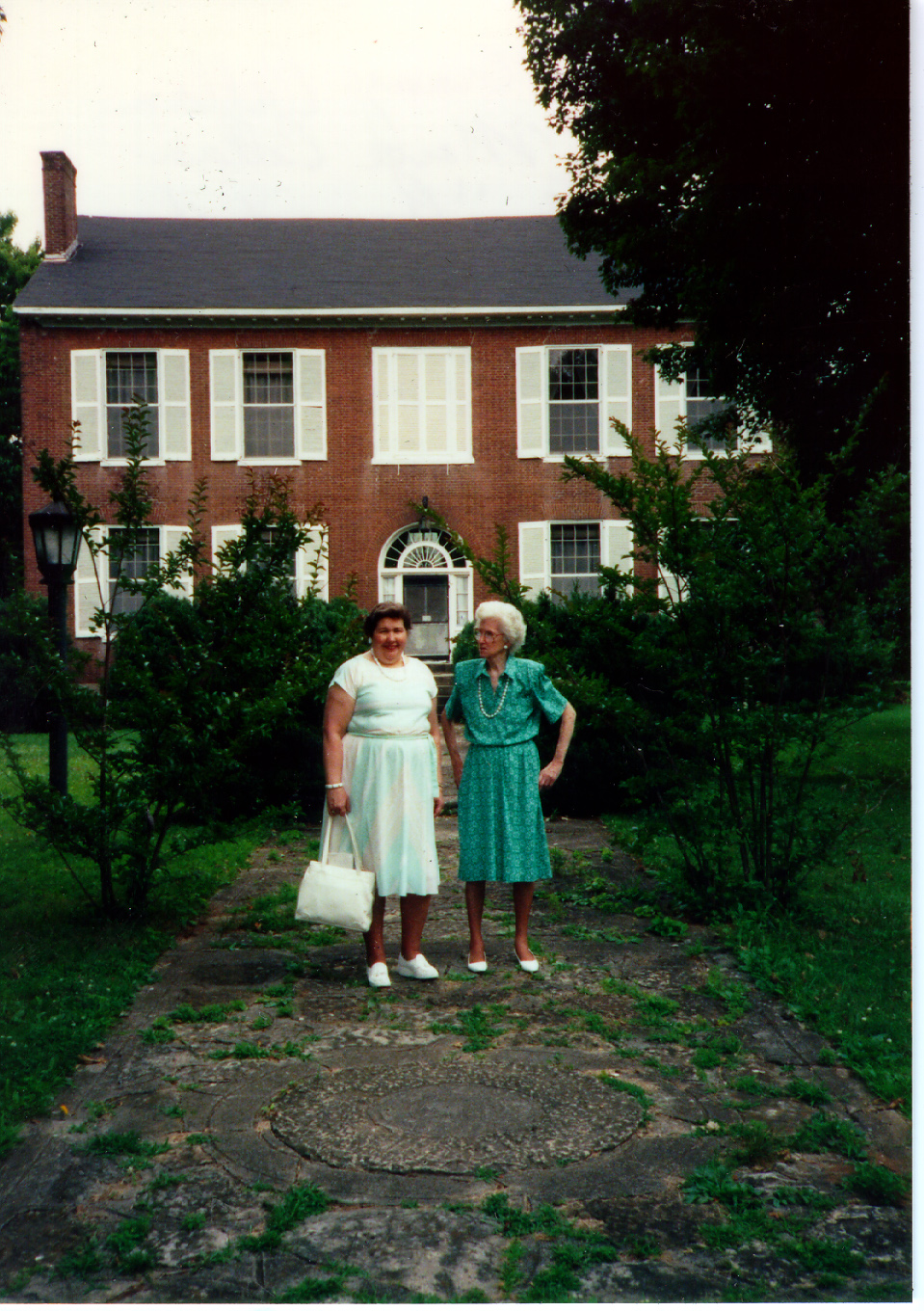
Wickland-Home of three Governors
Bardstown, Kentucky
"The landmark Wickland mansion, east of Bardstown, Kentucky, was erected about 1825-1825 as the residence of Honorable Charles Anderson Wickliffe-(14th Gov of KY); it is considered one of the best Federal
style houses in Kentucky. It is call the "Home of Three Governors: in honor of the original owner, Kentucky's Governor
during 1839-1840; his son [Honorable Robert C. Wickliffe] was governor of Louisiana during
1856-1860; and his grandson Honorable John Crepps Wickliffe Beckham-(35th Gov of KY), Kentucky's
governor from 1900-1907.
The Baltimore trained architect-builder John Rogers designed the spacious fourteen-room mansion, and the design was
executed by his associate James Marshall Browne, a master mason also credited with work on St. Joseph Cathedral,
another Rogers design. Wickland's design features an unusual T-hallway with garden-side carriage entrance matching the
larger main front entry. The perfectly proportioned front facade is complemented by the garden-side gable, and
Georgian balance in fenestration is achieved by using false windows with closed shutters. Left of the main front entry
are double parlors divided by large folding doors, becoming a single large room for entertaining. Paired mantels with
Adamesque swags and elegantly reeded windows surrounds enhance the formal effect. The stair case sweeps up to the
third level, as in Federal Hill and Edgewood; all three staircases are probably the work of master woodwright Alexander
Moore, an associate of both Rogers and Browne in many other Bardstown area homes and buildings.
In 1919 Wickland was sold by the children and heirs of Julia Tevis (Wickliffe) Beckham,
youngest daughter of Honorable Charles Anderson Wickliffe-(14th Gov of KY), finally passing from
family hands. The house is open to the public year-round." Written by David H. Hall for The
Kentucky Encyclopedia, page 950; 1992.
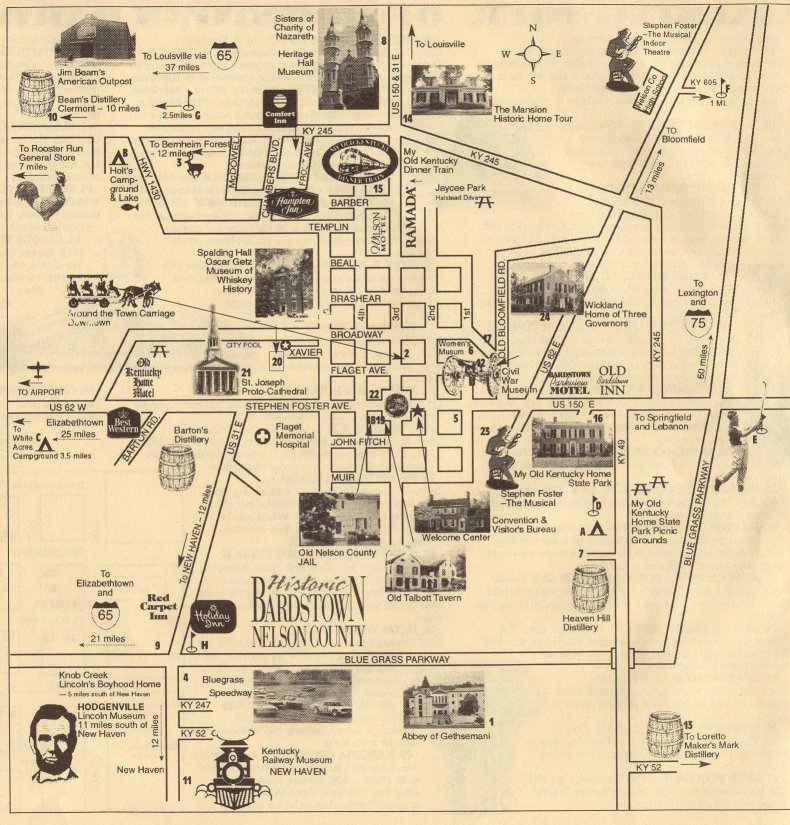


City of Wickliffe
Ballard County, Kentucky
"Wickliffe, the seat of Ballard County, [Kentucky], is located in the southwestern corner of the county on the
Mississippi River. The town was laid out in 1880 and incorporated two years later. It was named after Col. Charles Anderson Wickliffe-(Confederate Col.), who served variously as a Kentucky legislator, a
Confederate officer, and an attorney. He was the nephew of Kentucky's fourteenth governor, also named Charles Anderson
Wickliffe (1839-1840)
Blandville was the seat of Ballard until the courthouse there burned in February 1880. Judge Samuel H. Jenkins offered
to donate the land and funds to build a new courthouse in Wickliffe. A referendum in May 1880 to determine whether to
move the county seat to Wickliffe was approved, and although the supporters of Blandville declared the voting unfair,
the court of appeals in 1882 upheld the legitimacy of the results. The county records were moved to Wickliffe and
another public election was held in 1884, again resulting in the selection of Wickliffe. The town grew rapidly from
that point on. Its location on the Mississippi River gave the town access to commerce. It also benefited from the
presence of the Illinois Centraland the Mobile & Ohio railroads (now the Illinois Central Gulf), which were extended
into the town during the 1860's and 1870's. These water and rail transportation and communication routes linked
Wickliffe with commercial centers to the north and south.
[Located in Wickliffe are the Wickliffe Mounds]
The population of Wickliffe was 1,211 in 1970; 1,034 in 1980; and 851 in 1990."
Written in theThe Kentucky Encyclopedia, page 951-952; 1992.
Wickliffe(Ballard County, Kentucky): wihk/lihf(Wickliffe). This 5th class city and seat of Ballard Co., is on US
51, 60, and 62, and the Mississippi River, 189 miles wsw of downtown Louisville. The town was laid out in 1880 on the
site of a small settlement and named for Honorable Charles Anderson Wickliffe-(14th Gov of KY),
attorney, state legislator, Confederate officer, and nephew and namesake of Kentucky's 14th Governor, who inherited the
land that his pioneer grandfather, Col. Benjamin Logan, had received for Revolutionary War service. The post office at
Fort Jefferson 1 mile south, had been moved to this site the year before, and in 1882, when Wickliffe was
incorporated as a town, the co's seat was transferred from Blandville, 6.5 miles east. 38. Written by Robert
M. Rennick, Kentucky Place Names, 1987.

Wickliffe Mounds
Ballard County, Kentucky
The Wickliffe Mounds in Ballard County, Kentucky, mark the site of a village or small town that Mississippian Native
Americans inhabited from 1000A.D. to 1300 A.D. The mounds lie on the bluffs of the Mississippi River, about three
miles below its confluence with the Ohio [River]. Typical of Mississippian period sites in western Kentucky, the town
at Wickliffe Mounds was both a ceremonial and an administrative center. Two platform (temple) mounds dominate the
site, and several smaller mounds are scattered around the village area. Archaeological excavation in the mounds and
village has provided evidence of a late prehistoric society characterized by staple corn agriculture; trade contacts as
far away as North Carolina, Wisconsin, and the Gulf of Mexico; and a social system organized under hereditary chiefs.
Fain W. King, a Paducah businessman, excavated privately at the Wickliffe Mounds site during the 1930's. With his
wife, Blanche Busey King, he operated the site as a tourist attraction under the misnomer "Ancient Buried City," The
Kings' commercial venture was controversial because of their sensational advertising and unsophisticated
interpretation, putting them at odds with professional archaeologists. In 1946 the Kings deeded the site to Western
Baptist Hospital of Paducah, which maintained the tourism business until it donated the property to Murray State
University in 1983. Since 1983 the Wickliffe Mounds Research Center has established a comprehensive program of
public education, research, and preservation at the Wickliffe Mounds. The site has been listed on the National
Register of Historic Places (1984), and was the first entry in the Kentucky Archaeological Registry (1987).
See David Pollack and Mary Lucas Powell, eds., New Deal Era Archaeology and Current Research in Kentucky
(Frankfort, Ky., 1988)." Written by Kit W. Wesler for The Kentucky Encyclopedia, page 952;
1992.

Honorable Charles Anderson Wickliffe-(14th Gov of KY)
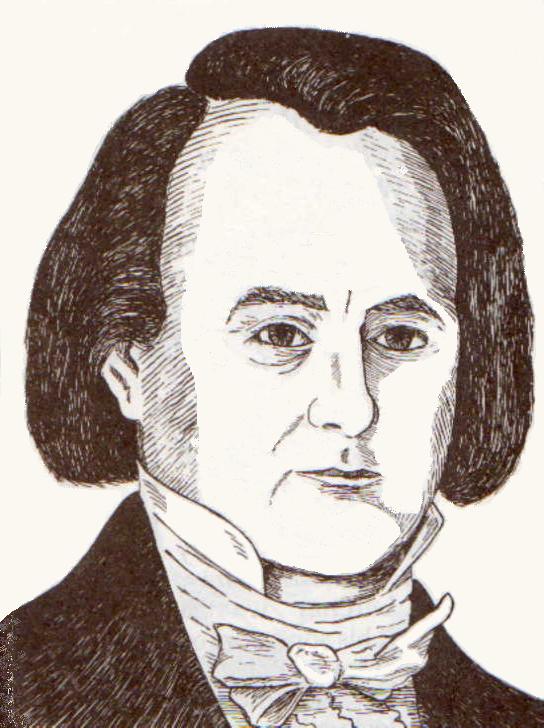
14th Governor of Kentucky; U.S. and State Senator
"14th Governor: 27 September 1839 to 2 September 1840. Born 8 June 1788-died 31 October 1869 (Whig Party)."

"After serving several terms on both the state legislature and the U.S. Congress, Wickliffe succeeded to the
governorship upon the death of Governor James Clark. The youngest of the nine children of Charles Anderson and Lydia
Hardin Wickliffe, Charles was born near Springfield, Kentucky. He attended Wilson's Academy at Bardstown and then
received private instruction under James Blythe, acting president of Transylvania University. Upon returning to
Bardstown, he studied law in the office of his cousin, M.D. Hardin, and in 1809 was admitted to the bar. He began his
practice with the group of Bardstown lawyers which included Ben Hardin, Felix Grundy, John Rowan and W.P. Duval. In
1812 he was elected to the Kentucky House of Representatives from Nelson County. In 1813 he married Margaret Crepps,
and in 1816 he succeeded his cousin, Ben Hardin, as commonwealth attorney for Nelson County, and 1820-21 was again a
member of the State House of Representatives. Then, beginning in 1823, he was elected to the U.S. Congress and
re-elected to four succeeding Congresses, serving until 1833.
Wickliffe was an unsuccessful candidate for the U.S. Senate in 1831. He returned to state politics and in 1833 was
sent to the legislature for the third time representing his faithful constituents in Nelson County. In 1836 he was
elected lieutenant governor on the Whig ticket and on the death of Gov. James Clark, succeeded to the office of
governor. The next year President Tyler appointed him Postmaster-General. He served in this position until 6 March
1845. In 1845 President Polk sent Wickliffe on a secret mission to the Republic of Texas. He returned to
state politics and was elected to the Constitutional Congress of 1849. Wickliffe opposed the movement
for the secession of Kentucky in 1861, and was a member of the Washington Peace Conference and the Border
State Conference.
He was elected to Congress as a Union Whig and at the close of his term was a candidate of the Peace Democrats for
governor. He was defeated by Thomas Bramlette. During his last term in Congress he was thrown from his carriage
and was crippled for the remainder of his life, and for several years prior to his death was blind. He is buried in
Bardstown, KY. Charles Anderson Wickliffe and his wife had three sons and five daughters. The most prominent of these
was his son Honorable Robert C. Wickliffe, who was quite active in politics and became governor of
Louisiana.
Source reference Kentucky Governors by Robert A. Powell, published and distributed by Kentucky Images, 527 South
Upper Street Lexington, KY 40508-2993; Published 1989.

Col. Charles Anderson Wickliffe-(Confederate Col. and attorney)
Confederate Colonel and attorney
The City of Wickliffe in Ballard County is named for Col. Charles Anderson Wickliffe. The city
is the county seat for Ballard County, Kentucky. Col. Charles Anderson Wickliffe was the nephew of Honorable Charles Anderson Wickliffe-(14th Gov of KY).
His dad was Honorable Robert C. Wickliffe-(Attorney & Legislator)(RW-uncle)and his mother was Margaret
Howard Preston. Charles had 3 sisters (Sally, Mary, and Margaret) and 3 brothers (John, Benjamin, and Robert).

Honorable Robert C. Wickliffe-(RW-Gov)
Governor of Louisiana 1856-1860
His father was Honorable Charles Anderson Wickliffe-(Gov) and his nephew was Honorable John Crepps Wickliffe Beckham-(Gov) and his sister was Julia
Tevis (Wickliffe) Beckham. His uncle was Honorable Robert C. Wickliffe-Attorney & Legislator
(RW-Uncle)

Paul R. Wickliffe, Jr. (Electrical Engineer/Inventor)
WICKLIFFE PAUL R., JR., 81, born in Louisville, KY, died on Wednesday, 15 November 2006 in Summit, NJ, where he has
resided since 1954.
He graduated from Woodberry Forest School in Virginia before serving in the Army in World War II. He received a second-
alternate appointment to West Point and later earned degrees in electrical engineering from Purdue and MIT.
His entire working career was spent with Bell Telephone Laboratories at Murray Hill and Holmdel in New Jersey. One of
his earliest assignments was for the design and installation of a microwave relay system that formed the backbone of
AT&T's long distance service across the country. He headed a group that pioneered telephone service aboard trains and
found a way to provide continuous service through the rail tunnels of Baltimore for the Metroliner train.
Among other projects, he collaborated with the British Post Office to provide overseas networks, and supervised a group
that participated in the Telstar communication satellite program. He was in charge of a group that developed the
electronics for transmitting video from one central office to another for the Picturephone service. He was given a "rush
job" to design, fabricate, and operate a system for fiber optic transmission for broadcast from the Winter Olympics in
Lake Placid in 1980. It was another pioneering event in which he was the first person to ever send TV over optical fiber
cable. He is survived by his wife, Mary; a son Paul III; a daughter-in-law Roseanna; and a granddaughter, Sarah.
A memorial service will be held 10:00 a.m. Friday, 8 December 2006 at Central Presbyterian Church. Interment is at
Evergreen Cemetery in Greenville, KY.
Memorials may be made to Central Presbyterian Church, 80 Maple Street in Summit, NJ, or to First Presbyterian Church in
Greenville, KY.
Published in The Courier-Journal on 17 November 2006.
http://www.legacy.com/louisville/obituaries.asp?Page=LifeStory&PersonID=19939410">Courier Journal Obituary
Honorable Robert C. Wickliffe-Attorney & Legislator (RW-Uncle)
Attorney & Legislator

"Attorney and legislator Robert Wickliffe was born at Redstone, Pennsylvania, on 16 January 1775,[tombstone says 1774]
one of nine children of
Honorable Charles Anderson and Lydia (Hardin) Wickliffe. They soon settled in Bardstown,
Kentucky. Privately educated, Wickliffe read law with George Nicholas in Lexington, where he opened a law practice.
In 1805 Wickliffe was appointed U.S. Attorney for Kentucky. Around 1809, he turned to real estate and was widely known
for the litigious manner in which he acquired vast acreages. Wickliffe served three terms in the Kentucky House (1818,
1823, and 1824), and one in the Senate (1825). He was often an adviser to his brother Honorable
Charles Anderson Wickliffe when Charles was governor of Kentucky (1839-1840). Robert Wickliffe was a staunch
advocate of the OLD COURT in the controversy over relief to debtors and one of the most consistent pro-slavery
spokesmen of the Democratic party. In 1840 he held more than two hundred slaves, one of the larges slaveholdings in
the state.
Wickliffe's handling of Breckinridge family legal affairs in the early 1800's had brought him into conflict with
antislavery spokesman Robert Jefferson Breckinridge. In the 1840's Wickliffe and Breckinridge expounded their views in
newspapers and pamphlets, some of them thirty to seventy pages long. The verbose titles ranged from A Further Reply
of Robert Wickliffe to the Billingsgate Abuse of Robert Judas Breckinridge, Otherwise Called Robert Jefferson (an
1843 publication of seventy pages), to The Second Defense of Robert J. Breckinridge Against the Calumnies of Robert
Wickliffe; Being a Reply to His Printed Speech of 9 Nov. 1840 (a thirty-nine page publication commercially printed
in 1841).
In 1805 Wickliffe married Margaret Howard Preston; they were the parents of seven children: Sally, Col.
Charles Anderson, John, Benjamin, Robert, Mary, and Margaret. In 1825, Margaret, his wife, died, and in 1826
Wickliffe married the widow Mary Owen (Todd) Russell, the only daughter of Col. John Todd, whose fortune in land and
slaves was estimated to exceed $250,000. Wickliffe and his second wife had no children. Wickliffe obtained ownership
of his second wife's property in 1828 through a tripartite deed in which Mary (Todd) Wickliffe transferred all of her
property, and Wickliffe part of his, to Richard H. Chinn, who in turn deeded all the property involved back to
Wickliffe on the same day. In the 1820's there was no legislation to protect married women's property rights in
Kentucky. In 1849, the Todd family filed suit for the return of the vast properties of Colonel Todd, claiming that his
will (lost in an 1803 fire that consumed the Fayette County clerk's office) ordered that his property be divided among
the rest of his family if his daughter Mary had no heirs; the only child of her marriage had died before she married
Wickliffe. Todd Heirs vs. Wickliffe continued through lengthy trials until an 1857 Court of Appeals
decision allowed the property and slaves to remain in the Wickliffe family, since Colonel Todd's will could not be
produced.
Robert Wickliffe died in Lexington on 1 September 1859 and was buried at his home, Howard's Grove. His will
emancipated his personal slave, William Box, and gave a three-day holiday to his other slaves upon his death."
Written by Betty B. Ellison for The Kentucky Encyclopedia, page 951; 1992.
Howard's Grove Cemetery: Robert Wickliffe's Tombstone
Letter from Susan P. Christy to sister-in-law, Margaret Wickliffe Preston (R. Wickliffe's youngest daughter then in
Spain), October 29, 1859, Box 74, W-PFP:
"My dearest sister,... your name was the last that his lips ever uttered audibly... after his last sleep had
begun as they thought, that he roused himself and said "my dear children! Sally, Mary, Margaret! -- Margaret!"
Robert Wickliffe came to be known as the "Old Duke" once his namesake, Robert Wickliffe, Jr., began his political
career. According to George W. Ranck's History of Lexington (Cincinnati, 1872), he "came from Virginia at an early day,
and by his energy, persistent labor, and ability, gained a conspicuous position at the bar. He ... was for half a
century one of the leading spirits in state politics.... He was one of the shrewdest and ablest land lawyers in Ky, and
as such made himself rich (p. 382)." Wickliffe was one of the corporators of the first railroad in the West and the
second one in America, originally known as the Lexington & Ohio Railroad on which ran the first steam locomotive built
in the U.S. (invented by Thomas Barlow of Lexington). He was a state representative in 1819, 1823, and 1824; and a
state senator in 1829. During the Old Court-New Court controversy (1819-1823), he led the Old Court (anti-Relief)
faction. He served on the board of Transylvania University during Dr.
Holley's administration, and was a trustee at Christ Church Episcopal. He was a leader in the movement to popularize
the idea of the common school and in 1837 advocated a general system of education for the whole state -- a call taken
up by his political enemy and kinsman, Robert J. Breckinridge. By the 1840s he owned more than 200 slaves, making him
the largest slaveowner in Kentucky. See J. Winston Coleman, Jr., Slavery Times in Kentucky (Chapel Hill, 1940),
p. 45.
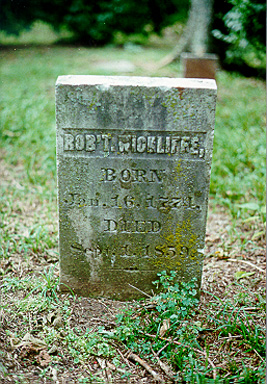
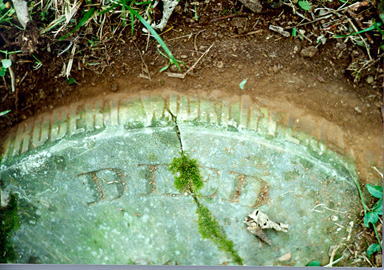
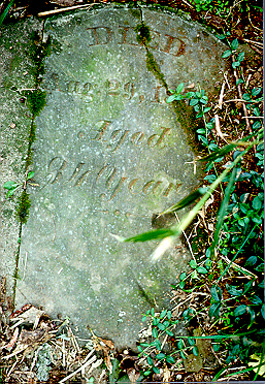
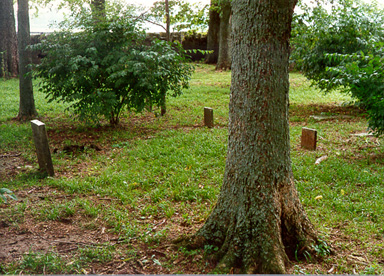
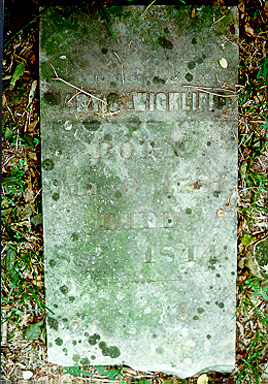
![This picture is taken of the first row of
graves [looking toward the east], with Robert Wickliffe's upright stone in the foreground and in the background is the
upright stone for his daughter, Sally Woolley. What is difficult to see is the row of flat granite tombstones, which are
in very poor condition.](http://www.brennancallan.com/family/grove4.jpg)
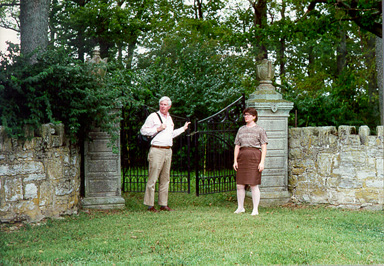

Judge William A. Wickliffe
The City of Martwick, Muhlenberg County, Kentucky was co-named in honor
of Judge William A. Wickliffe. He was a co-owner of the Martwick Mine.

Wick's Pizza
Wick's Pizza is of great importance to the Wickliffe family. Since
its humble beginnings in 1991, Michael and Meredith have grown Wick's Pizza into four lively locations with a
comfortable dining experience that appeals to everyone. Students on a budget. Families with kids. Couples on a
special night out. Sports Fans. No matter who walks in the door, customers will be greeted with kindness and find a
tasty dish and a cool beverage that will satisfy their cravings.
Today (2007), Michael and Meredith are as active as ever, helping maintain the friendly and comfortable atmosphere.
They go out of their way to make every employee and customer feel part of the family. Wick's Pizza just feels
different--like home. That is what sets Wick's apart. That approach results in a place where great food, service and
entertainment are king!
Wick's Creed
It is their sincere belief and practice that all human beings should be treated fairly and should not be discriminated
against regardless of race, sex, sexual orientation, age, religion, natural origin, or disability. No matter who you
are when you walk through their doors--a customer, vendor, or employee--it is their solemn vow that you will be treated
with respect while you are in their establishment. This is their creed by which they live and employ.
How It All Started
The story of Wick's Pizza started in the late 80's. Although the menu of Wick's was developed at the kitchen table of
his parents, the beliefs, philosophy and work ethic were developed during Michael's years in the restaurant industry.
Follow us through the evolution of Wick's Pizza.
1990 . Michael entered the pizza business with a loan from a friend and a management position. He would learn the ups
and downs of the business on the job.
1991 . Michael decided to go out on his own. He opened the 1st Wick's Pizza in the Plainview Shopping Center in eastern
Louisville.
1993 . Meredith and Michael relocated the restaurant to a prime location in the Highlands on Baxter Avenue (it's current
location).
1994 . Wick's Pizza took off and never looked back! Healthy sales helped the Wickliffes open Wick's Pub next to the
restaurant.
1998 . Growing popularity prompted the Wickliffe's to open the Goose Creek location in eastern Louisville.
1999 . Desperate for more room to grow, the Baxter Avenue location expanded to the neighboring building . taking over
more of the block!
2002 . Goose Creek Wick's relocated down the street to a larger building. The Wickliffe's opened their 3rd location in
Middletown on Shelbyville Road.
2004 . The Wickliffe's opened their newest and largest restaurant ever: an 11,200 sq. ft. building in the Valley Station
area of Dixie Highway!

Honorable Aaron Kitchell Wooley (Woolley)
Kentucky State Representative and Senator

"Aaron Kitchell Wooley, Kentucky State Representative and Senator was born in January 1800 in Springfield, New Jersey.
He graduated from the U.S. Military Academy at West Point with honors and taught mathematics there for two years.
Wooley later studied law with Judge Richard Biddle of Pittsburgh and set up practice in 1823 at Port Gibson,
Mississippi. After a visit to Lexington, Kentucky, he was married on 9 October 1827 to Sally Howard Wickliffe,
daughter of the prominent lawyer, Honorable Robert C. Wickliffe-(Attorney & Legislator)
(RW-uncle), with whom Wooley became a law partner. Wooley represented Fayette County in the Kentucky House of
Representatives from 1832-1834 and was a member of the state Senate from 1835-1839. After leaving the Senate, he
served as judge of the Lexington circuit court and joined the faculty of the Transylvania University Law School (1839). He was a Fayette County candidate
for the 1849 state constitutional convention, which addressed the abolition of slavery and the question of appointment
versus election of the judiciary. Wooley stumped the county, speaking out against abolition and popular judicial
election. He died of cholera on 3 August 1849.
[His son was Honorable Robert Wickliffe Woolley-(Wooley)(Diplomat and
soldier-Lt. Col. in CSA.)"]
See George Baber, "The Three Wooleys," Register 12 (Jan 1914): 47-49.
The Kentucky Encyclopedia, page 968; 1992.

Far off to the left (south) of John Howard, but still
generally in line with this group in the first row, is buried Judge Aaron K. Woolley who died 31 August 1849, of
cholera. Beside him, on his right side (further to the south), is his wife, the eldest of the Wickliffe offspring,
Sallie Howard Wickliffe Woolley who died July 29, 1873. She had lived on the farm as plantation mistress since the
1820s as well as in town at her father's first mansion at 2nd and Market Streets (now called the Woolley house). Upon
her death the farm was split up among her children; see O.B. Huggins survey taken on 1 October 1873, Fayette County
Deed Book 52, p. 394. This picture was taken by Jim Birchfield, August 1997.

This eldest living child of Robert and
Margaretta Wickliffe was named after Margaretta's sister, Sarah Howard. She had married Judge Aaron Kitchell Wooley on
October 9, 1827, and (according to her sister, Margaret Wickliffe Preston) had at least fourteen live children by him
before he died in 1849. Only eight children lived to adulthood, and most of them lived in some sort of dependency or in
poverty.
Robert Wickliffe Woolley (1828-1905) m. Mary J. Johnston of Louisville
Margaret Howard Woolley (1830-1898) m. Peter White of Cincinnati
Charles Wickliffe Woolley (1831-1893) m. Mary Frances Stader of Cincinnati
Ellen Douglas Woolley (1838-1904) m. John Breckinridge Payne of Lexington
Benjamin Howard Woolley (1840-1905) never married, died in an asylum
Daniel Vertner Woolley (1842-1899) m. Leila B. Jacob of Louisville
Frank Wickliffe Woolley (1845-1891) m. Lucy McCaw of Lexington
Aaron K. Woolley, Jr. (1847-1885) never married, committed suicide
|
In 1870 she owned real estate valued at $200,000 and personal property at $14,000. Her remains
were moved from the Lexington Cemetery where she was buried on July 31, 1873, to Howard's Grove
on October 16, 1874.
Howard's Grove Cemetery: Broken Gravestone
of Judge Aaron Kitchell Woolley
Aaron Kitchell Woolley was born in Springfield, New Jersey, and after taking some courses at West Point, practiced law
in Port Gibson, Mississippi. He visited Lexington in 1827 where he met the eldest daughter of Robert Wickliffe, Sallie
Howard Wickliffe, married her on October 9th of that year, and became law partner to his father-in-law. He was elected
to represent Fayette County in the Ky. House of Representatives from 1832-34 then the Senate from 1835-41. He was judge
of the circuit court of Fayette County, and also professor in the law college of Transylvania University. According to Ranck, "He was a good lawyer and a
fine speaker, possessed of a strong, clear intellect, and gifted with fine conversational powers (History, p.
196)." By 1844 it had become obvious to the Old Duke that the Judge was more willing to get his wife pregnant than he
was to help support her growing family. Sallie had at least 14 children, only 8 of whom lived to adulthood. In March of
1849, he told his father-in-law he wanted to become a foreign diplomat and so would no longer take care of his wife and
family -- his family knew that he was too drunk and too much in debt from gambling to do anything. "Sister is so
miserable, that she had far better be dead, but I think if he would never show her his face again, that it would be the
best luck, that has befallen her since her marriage - He has been gambling and lost largely, and has been staggering
home drunk, (so his son Robert informs Pa), every night for the last month." (Margaret W. Preston to William
Preston, March 4, 1849, Box 46, W-PFP).
Howard's
Grove Cemetery Broken Gravestone of Judge Aaron Kitchell Woolley

Honorable Robert Wickliffe Wooley
Diplomat and soldier-Lt. Col. in CSA.

Robert Wickliffe Wooley (Woolley), diplomat and soldier, was born in 1829 to Honorable Aaron K.
Wooley-(Kentucky state Representative and Senator)
and Sally Howard (Wickliffe) Wooley in Lexington, Kentucky.
He attended Centre College, Danville, and the Transylvania University Law
School, and practiced law in Lexington with Roger W. Hanson. Nominated in 1855 by the Democratic state convention,
Wooley was unsuccessful in a bid for attorney general. He was a nephew to William Preston (Major General-CSA) and in
1858, when President James Buchanan appointed Preston minister to Spain, Wooley became charge d'affaires in Madrid.
With the outbreak of the American Civil War, Wooley returned to Kentucky in the early summer of 1861. He joined the
Confederate Army and served as a captain and lieutenant colonel on the staffs of Gens. Honorable
William Preston-(Major General CSA/Lt. Col in KY Volunteers) and Simon Bolivar Buckner. Wooley returned to
Lexington after the war to practice law. He moved to Louisville after marrying Mary E. Johnston, a Louisville native
and the daughter of Dr. James C. Johnston. Wooley died on 10 February 1905, at his Louisville residence and was buried
in Cave Hill Cemetery." The Kentucky Encyclopedia, page 968; 1992.

Yenawine (Yenowine)

Yenowine house
Ind. Decisions - "Judge orders historic home
to be repaired" Article: 22 November 2005
Yenowine-Nichols-Collins House ** (added
1975 - Building - #75000017) 5118 State Rd. 64, New Albany


8:44 AM 3 October 2005 "Owners pressed to fix historic home" in Indiana Star
Relocation of the Yenowine-Nichols-Collins House, 5118 SR
64, Georgetown, Floyd County
Published: 1 November 2005
10:13 am: Georgetown home destroyed by fire: CHRIS MORRIS: The Tribune
Thursday, 3 November
2005: "Georgetown fire called arson Historic home gutted by blaze": By Dick Kaukas: dkaukas@courier-journal.com The
Courier-Journal
8:44 AM 3 October 2005
Owners pressed to fix historic home

Email address: bc@brennancallan.com
![]()
![]()
![]()
![]()
![]()
![]()
![]()
![]()
![]()
![]()
![]()
![]()
![]()
![]()
![]()
![]()
![]()
![]()
![]()
![]()
![]()
![]()
![]()
![]()
![]()
![]()
![]()
![]()
![]()
![]()
![]()
![]()
![]()
![]()
![]()
![]()
![]()
![]()
![]() Martwick (City of), Muhlenberg County, Kentucky
Martwick (City of), Muhlenberg County, Kentucky![]()
![]()
![]()
![]()
![]()
![]()








































 Photo courtesy of Filson
Club, Louisville
Photo courtesy of Filson
Club, Louisville
 Photo courtesy of Filson
Club, Louisville
Photo courtesy of Filson
Club, Louisville

















![This picture is taken of the first row of
graves [looking toward the east], with Robert Wickliffe's upright stone in the foreground and in the background is the
upright stone for his daughter, Sally Woolley. What is difficult to see is the row of flat granite tombstones, which are
in very poor condition.](http://www.brennancallan.com/family/grove4.jpg)


